Leaders Pact for the Future: A Planetary Emergency
A must watch lecture about the totalitarian takeover that fuses the climate and health agendas


Nov 24, 2023
My latest lecture uncovers the background to the Planetary Emergency that certain actors want to declare during the UN Summit of the Future in September 2024. This is in effect a totalitarian takeover that fuses the climate and health agenda. What is the history behind it and what are the implications?
Transcript:
The Pharos Chronicles – Jacob Nordangård, PhD is a reader-supported publication. To receive new posts and support my work, consider becoming a free or paid subscriber.
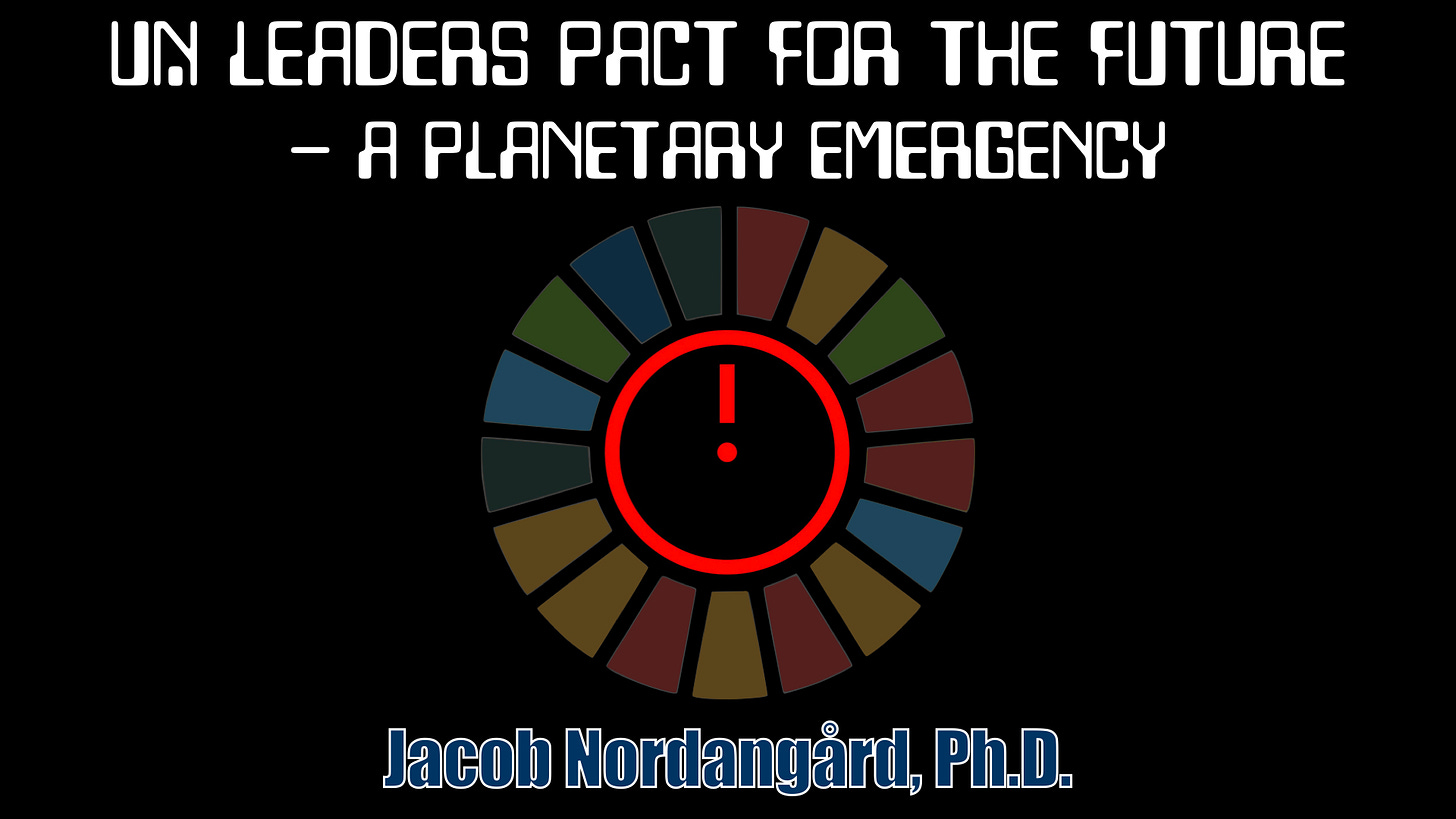
I am Jacob Nordangård. PhD in Technology & Social Change. In this second part about UN “Leaders Pact for the Future” I will talk about the background to the planetary emergency that certain actors wants to declare during the Summit of the Future. And what are the implications?
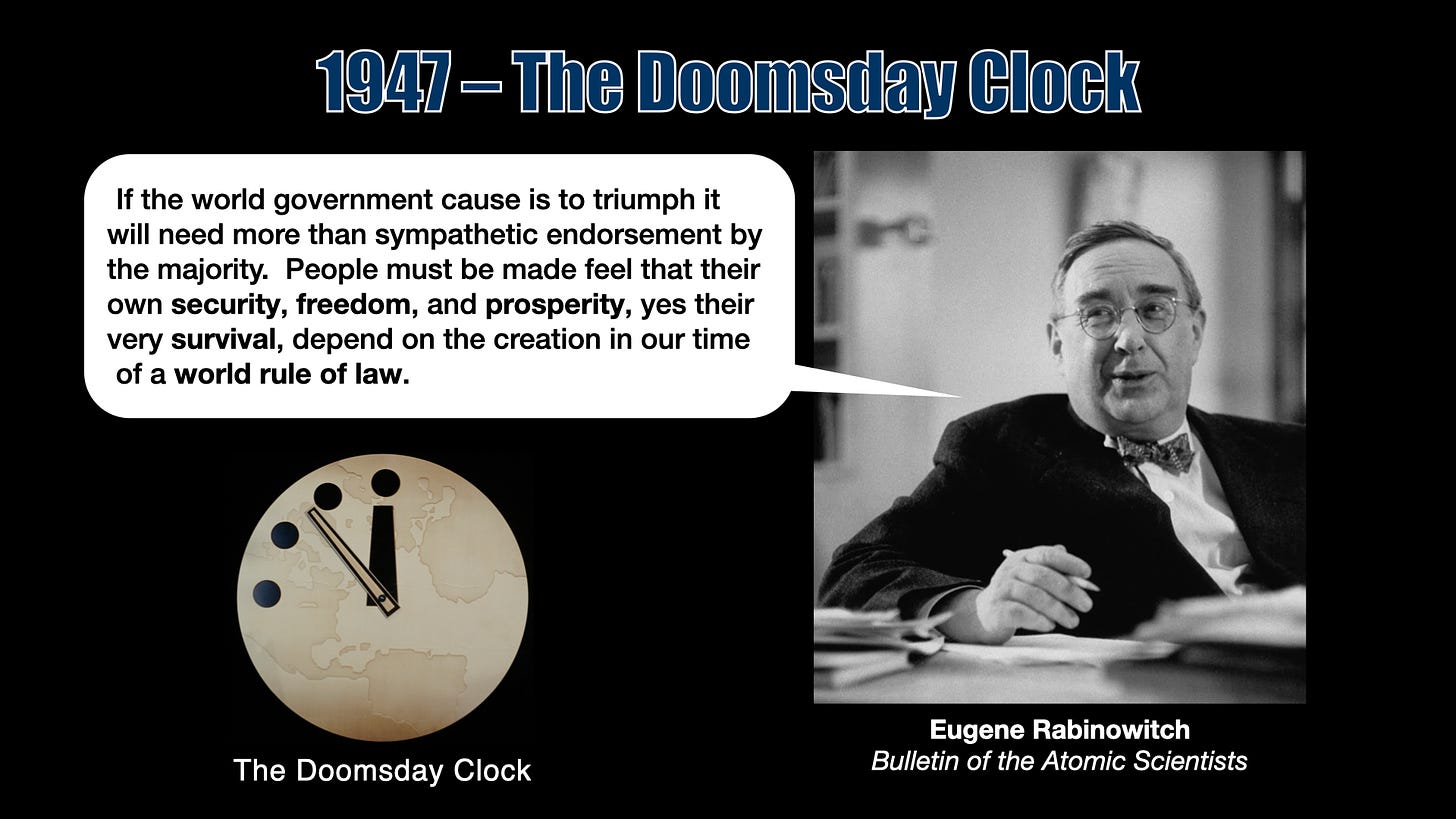
In 1947, the Doomsday Clock was created at the University of Chicago by scientists who had developed the atomic bomb. They wanted to convince the people that a world government was the only option to avoid war and misery. Eugene Rabinowitch, editor of the Bulletin of the Atomic Scientists wrote: ”If the world government cause is to triumph it will need more than sympathetic endorsement by the majority. People must be made feel that their own security, freedom, and prosperity, yes their very survival, depend on the creation in our time of a world rule of law.”
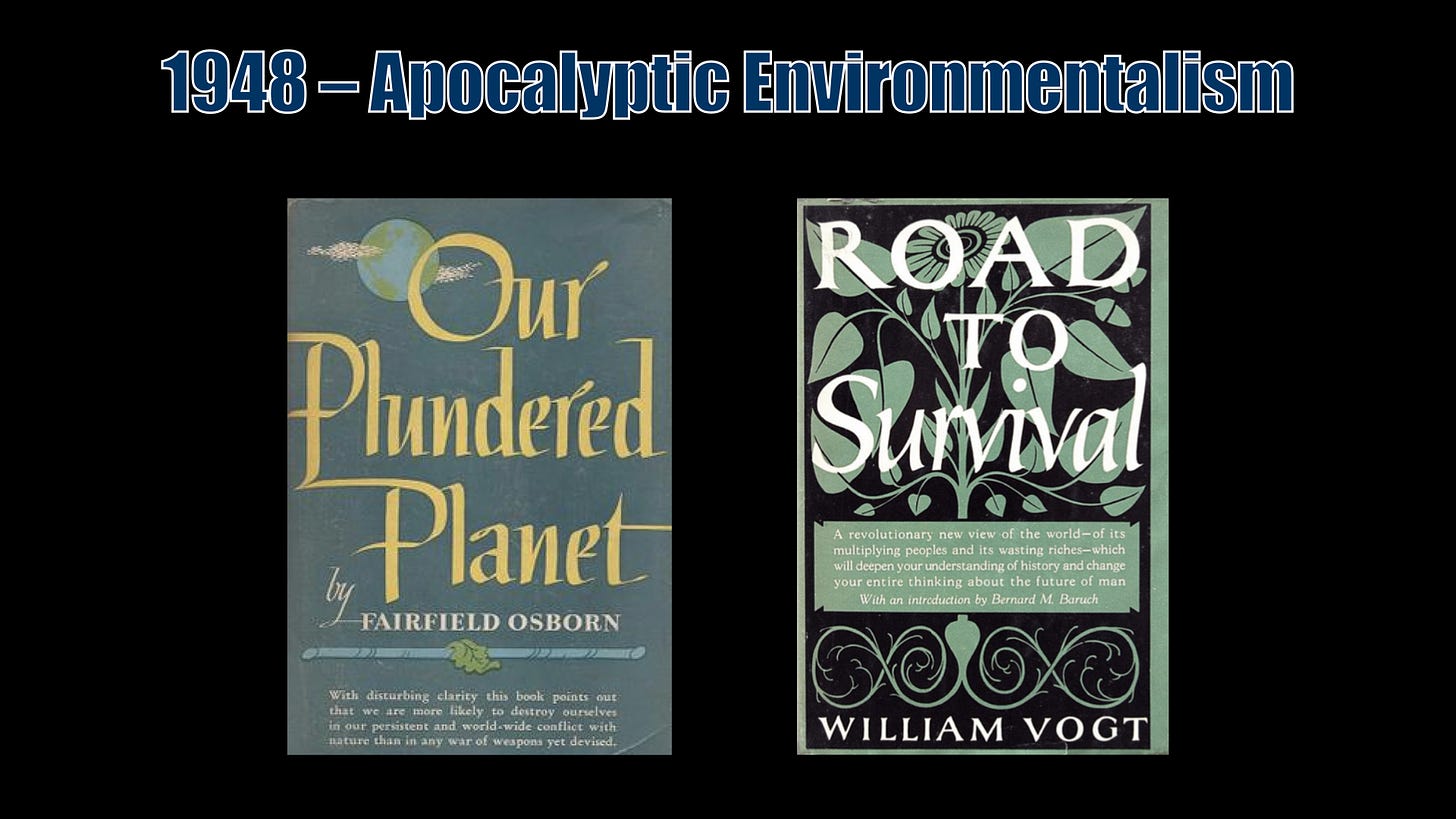
In 1948, the threat of nuclear war was supplemented by apocalyptic environmentalism. Two ground breaking books by Fairfield Osborn Junior and William Vogt were published with a dire message. The expanding global population would bring environmental disaster if not checked with birth control measures.
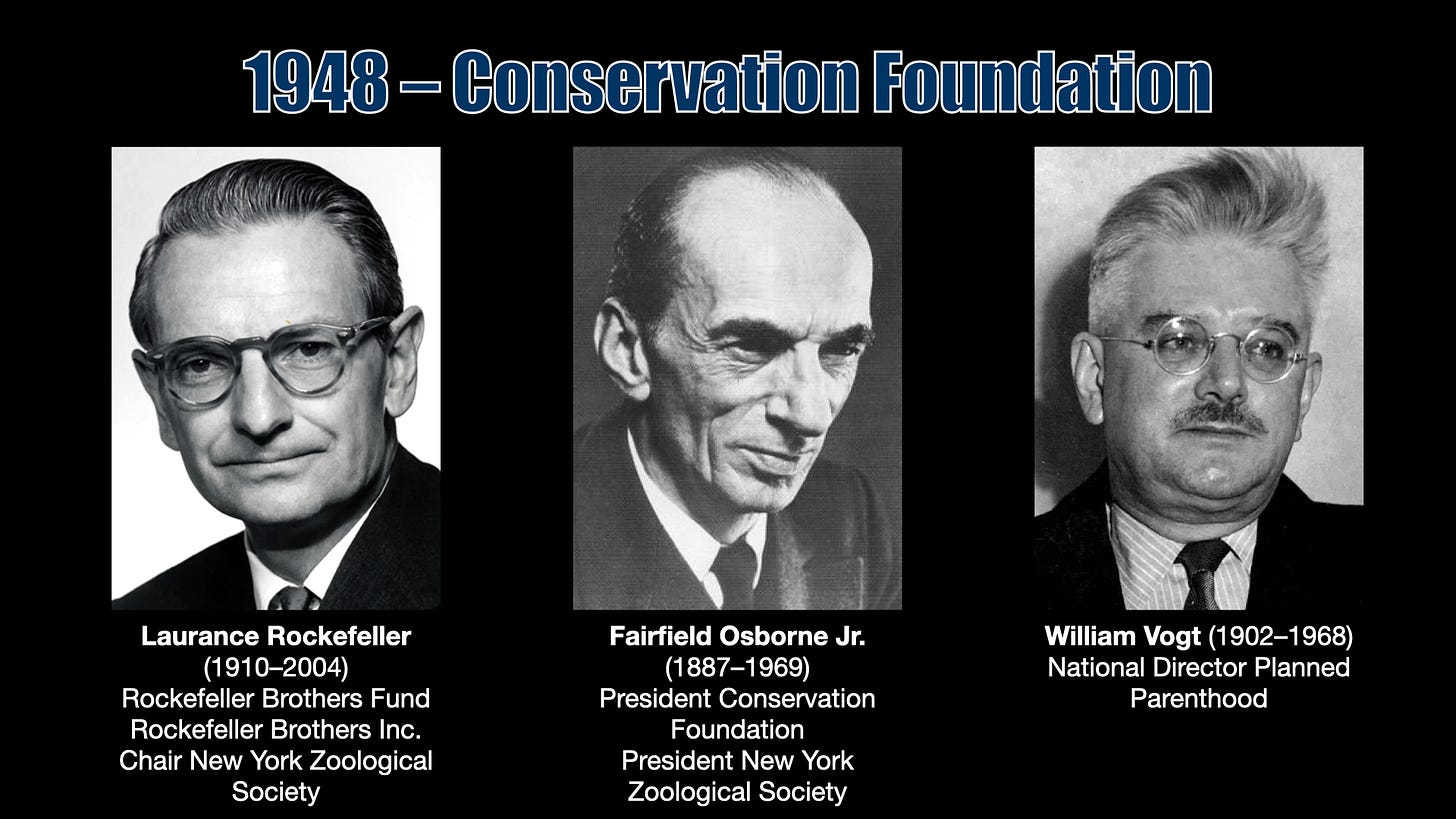
These ideas were spread with the help of The Conservation Foundation. An organisation that Osborne and Vogt founded together with the Oil tycoon John D. Rockefellers grandson Laurance Rockefeller. They all belonged to the American economic elite. Vogt became the National Director of Planned Parenthood Federation in 1951 whereas Osborne was the longtime president of New York Zoological Society (today known as the Wildlife Conservation Society) with Laurance as chairman.
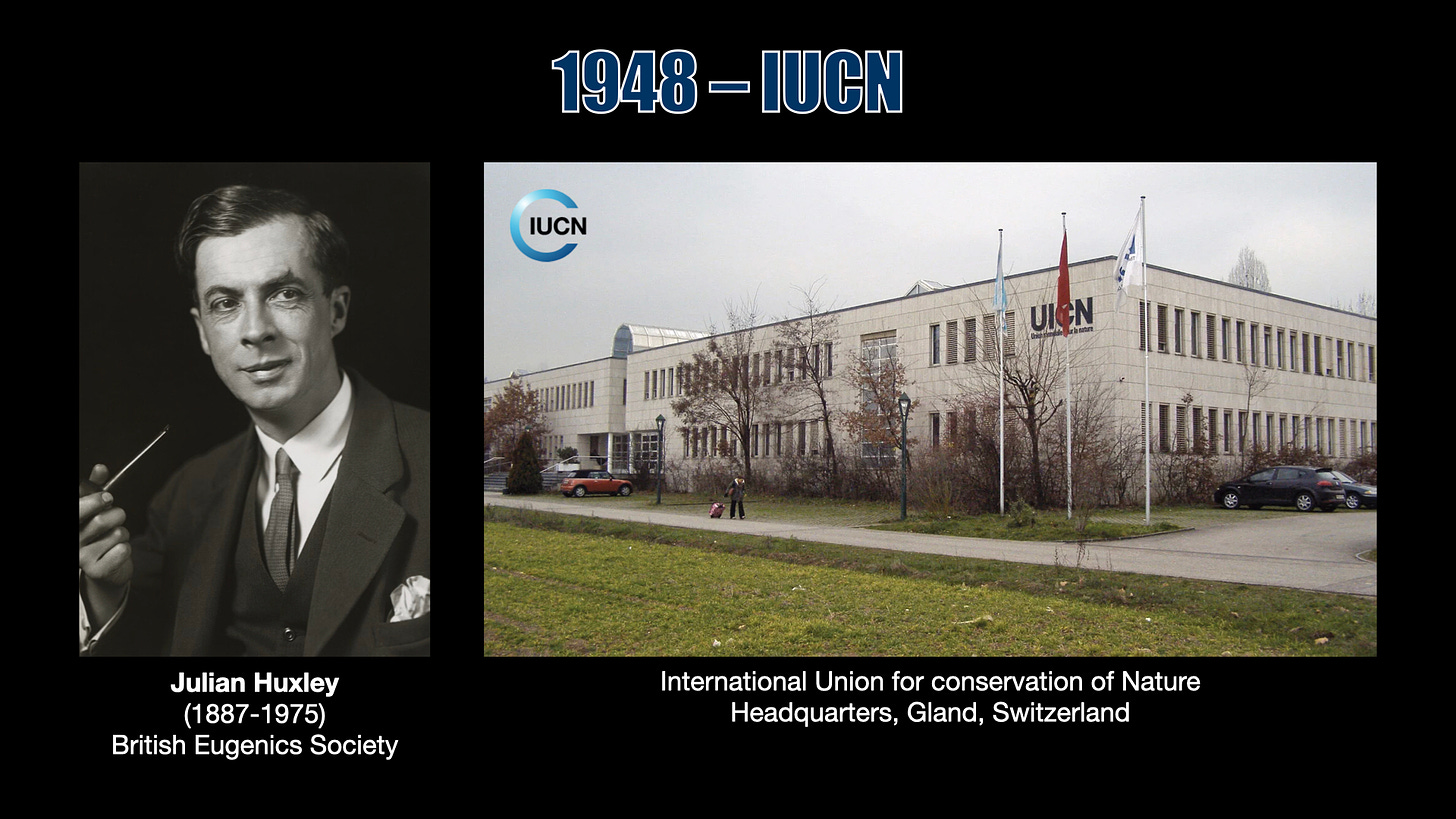
These ideas also made an impact internationally, with the founding of the International Union for the Conservation of Nature by UNESCO director-general Julian Huxley. Both Huxley and IUCN were closely aligned with the Rockefeller Foundation.
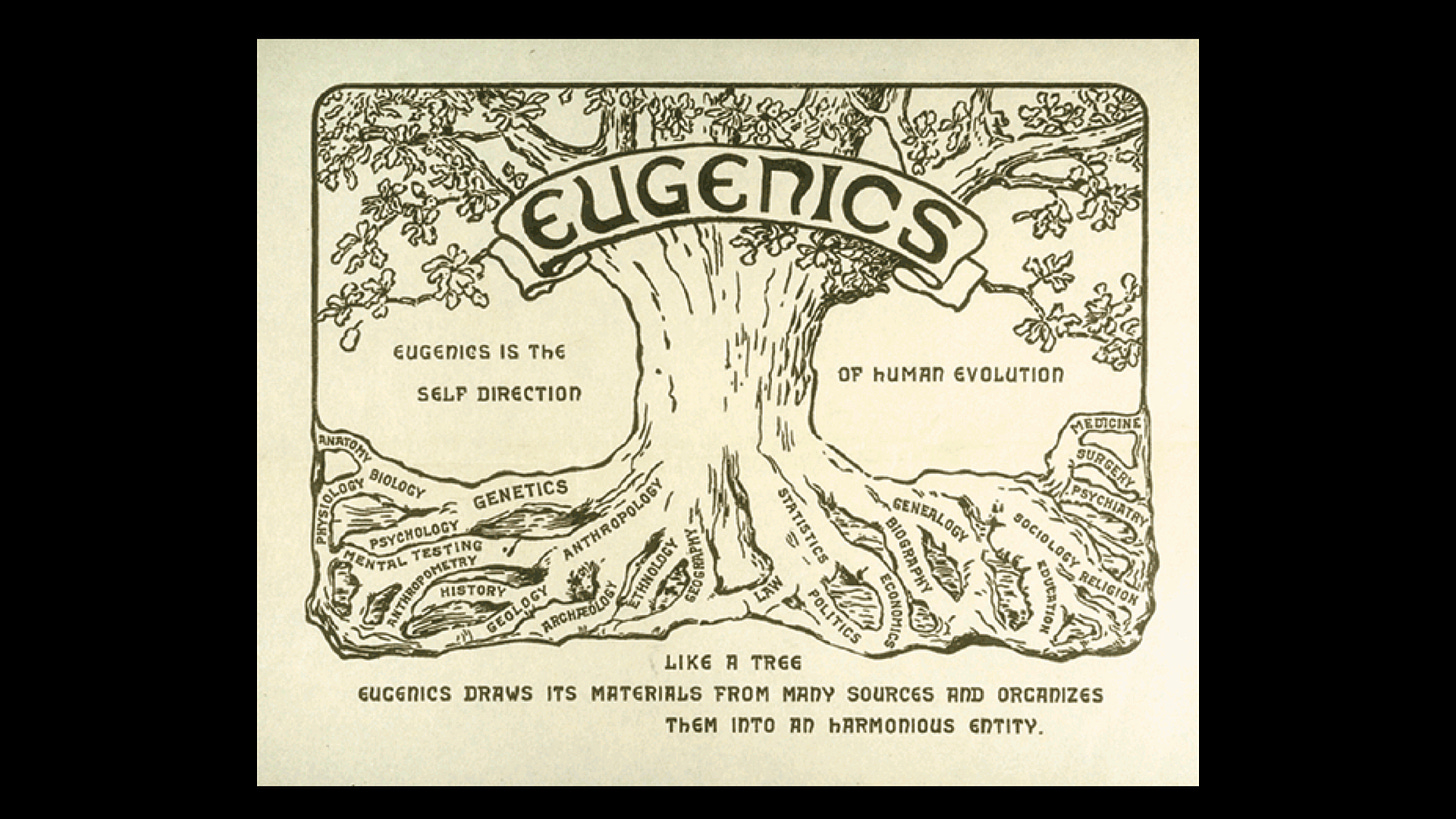
This was environmentalism rooted in eugenics. It meant improving the genetic quality of the human population through selective breeding. The population had to be controlled and the unfit had to go.
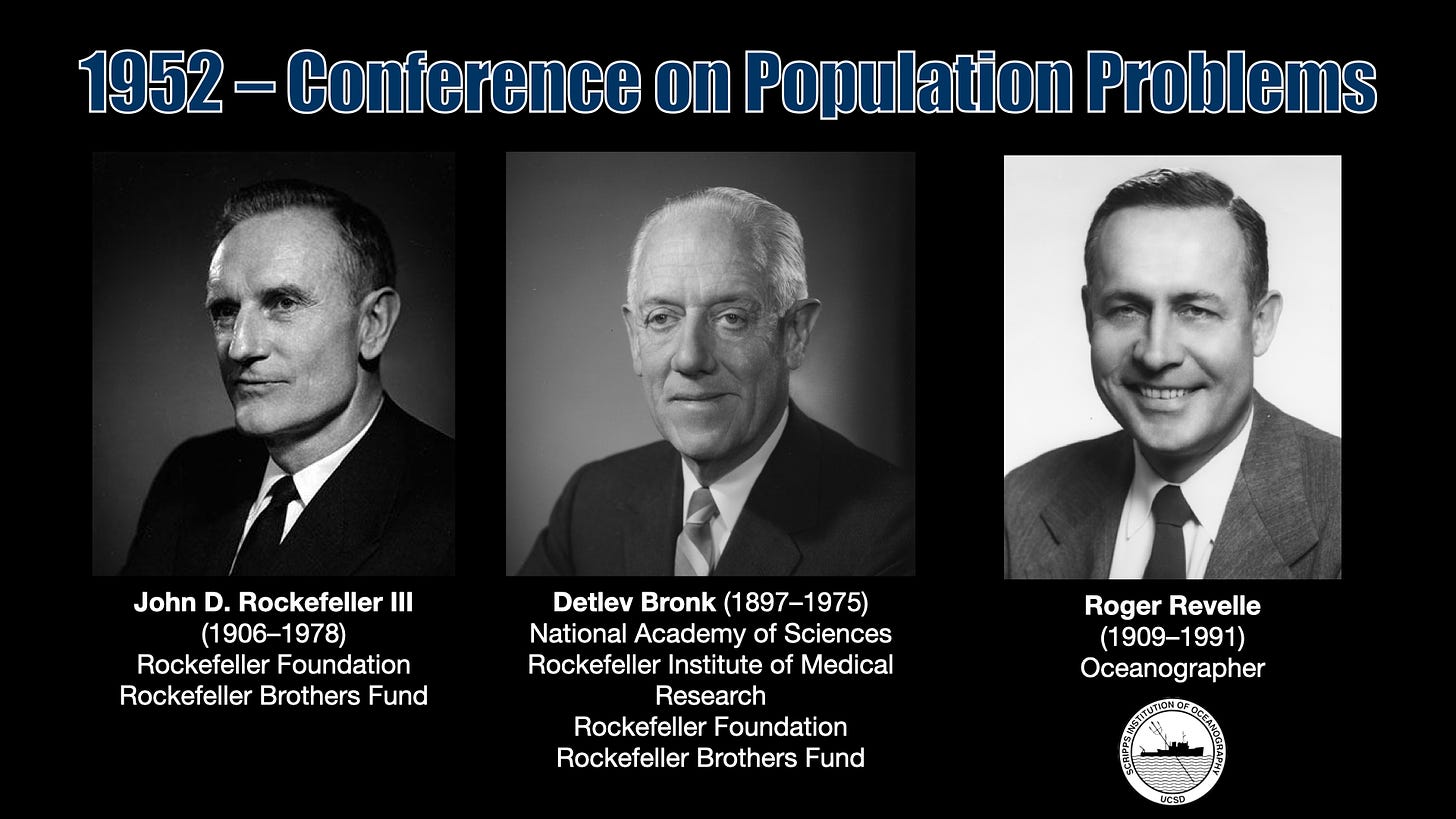
In 1952, Laurance brother John and the president of National Academy of Sciences, Detlev Bronk, arranged the Conference on Population Problems in Williamsburg, with thirty hand-picked proponents for population control. One of these were the oceanographer Roger Revelle from the Scripps Institute of Oceanography. He would soon get an important role to play.
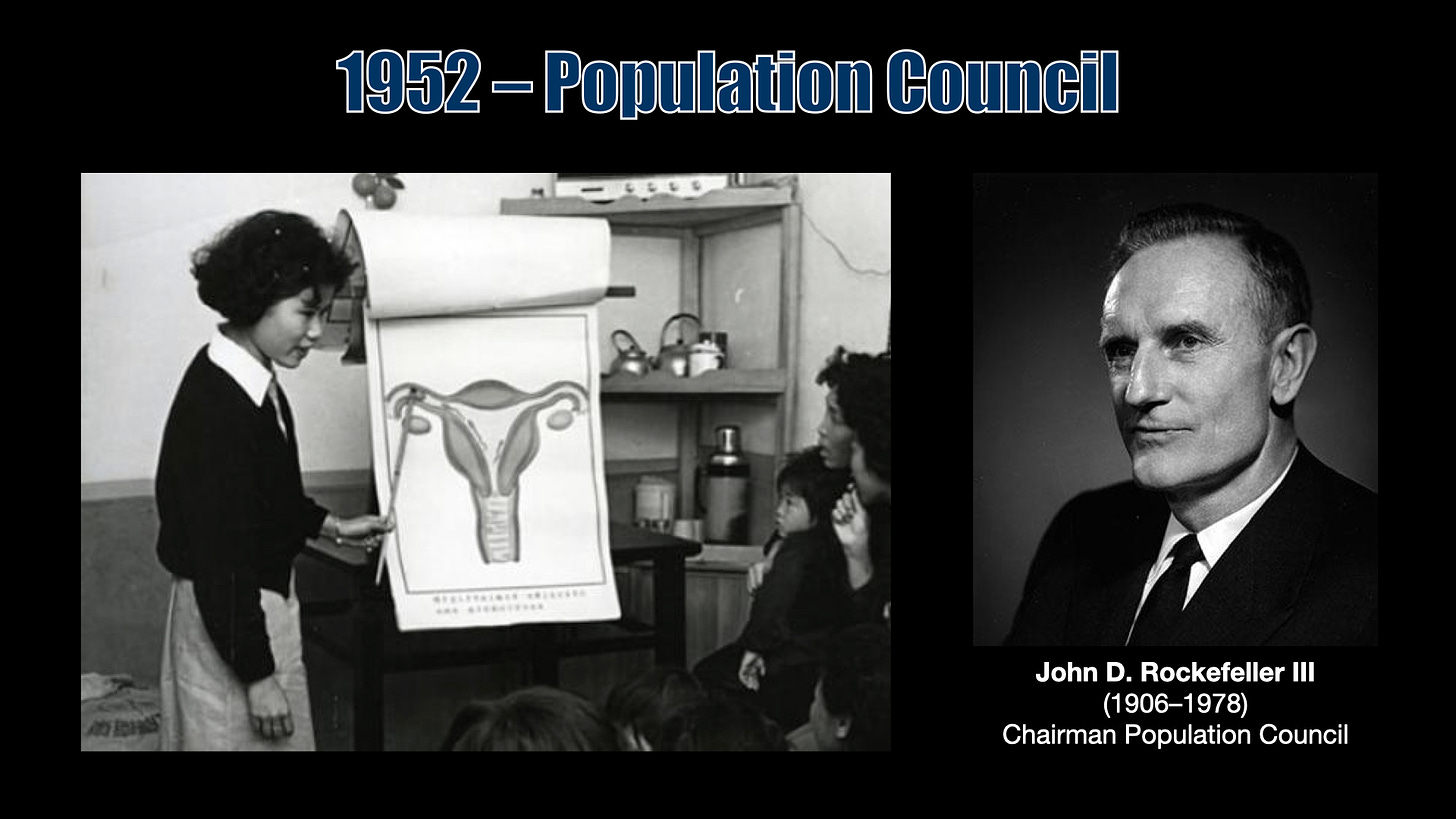
The conference led to the establishment of The Population Council with the mission to develop a plan in order to keep the world’s population growth in check.
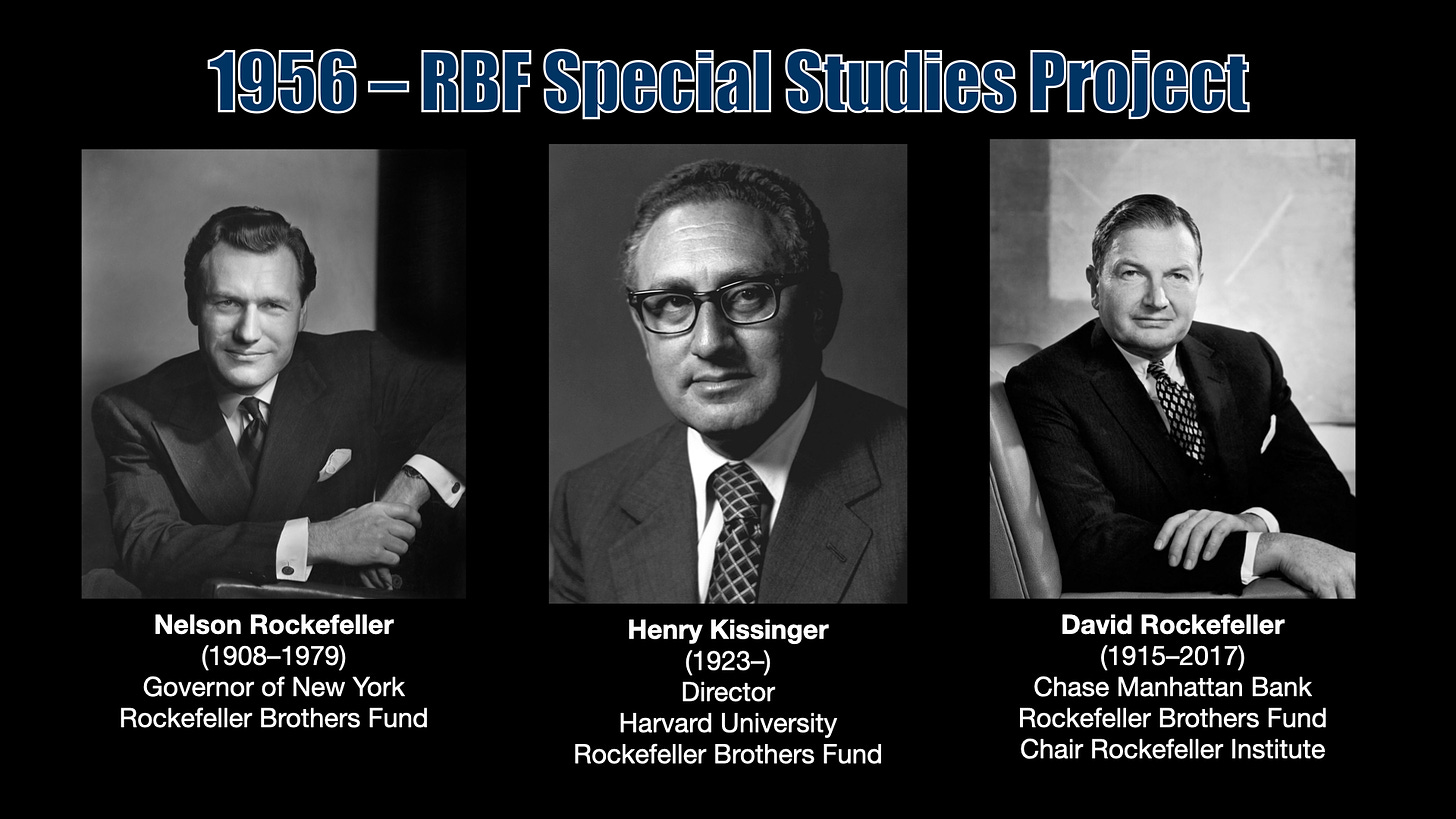
John, Laurance and Bronk thereafter participated in Rockefeller Brothers Funds “Special Studies Project”. This project, which ran between 1956–1960, had been initiated by Nelson Rockefeller with Henry Kissinger as director and the youngest brother David Rockefeller, vice president of Chase Manhattan Bank, as a panelist.
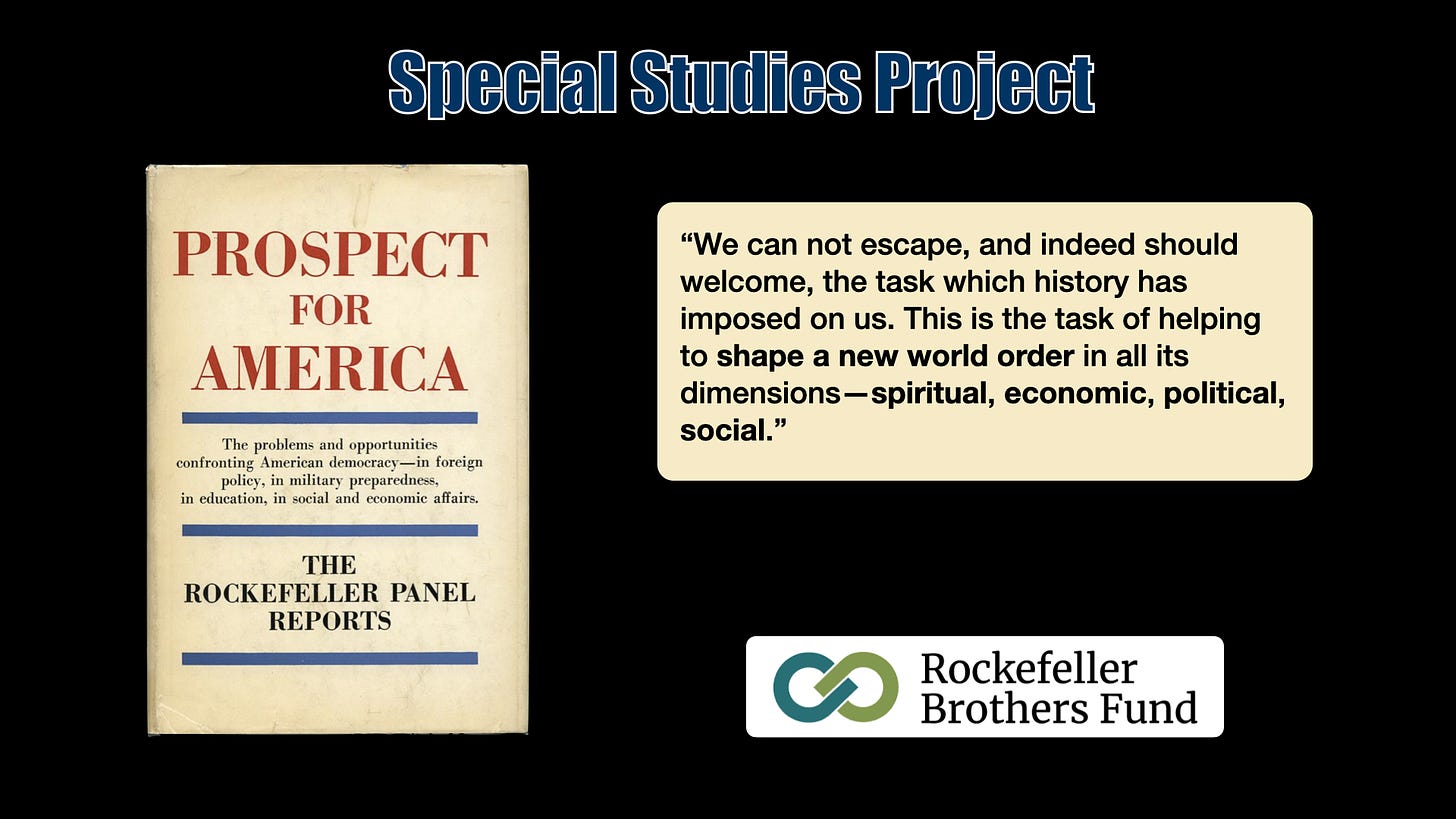
The stated objective with the Special Studies Project was to ”shape a new world order in all its dimensions – spiritual, economic, political, social. The challenge was to quote ”develop an international structure within which the basic human objectives can be realized… and then work steadily toward achieving it.”
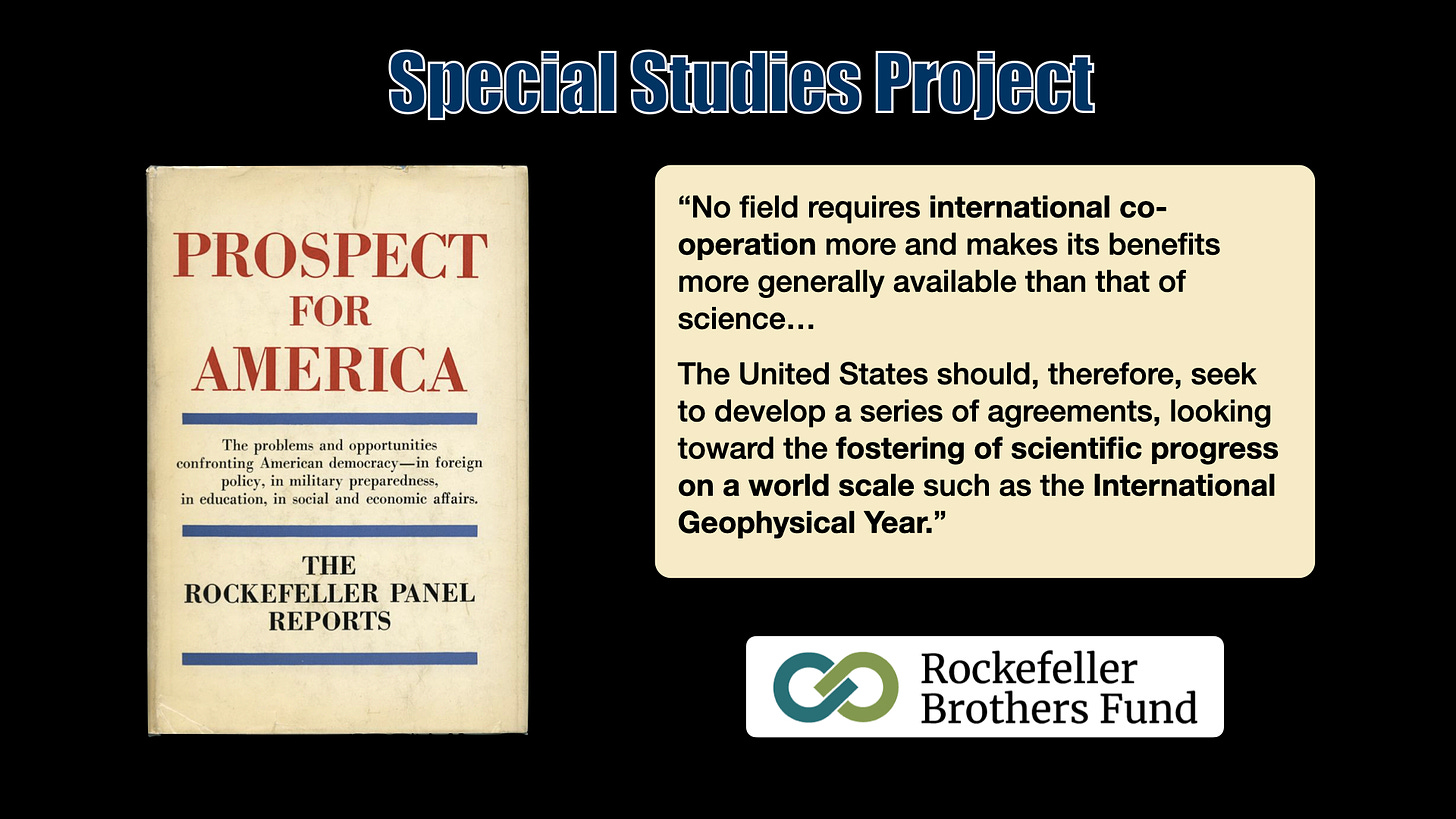
This would be done through science. An area where Rockefeller philanthropy had a big impact. As David Rockefeller’s sub-panel Foreign Economic Policy concluded: ”No field requires international co-operation more and makes its benefits more generally available than that of science… The United States should, therefore, seek to develop a series of agreements, looking toward the fostering of scientific progress on a world scale such as the International Geophysical Year.”
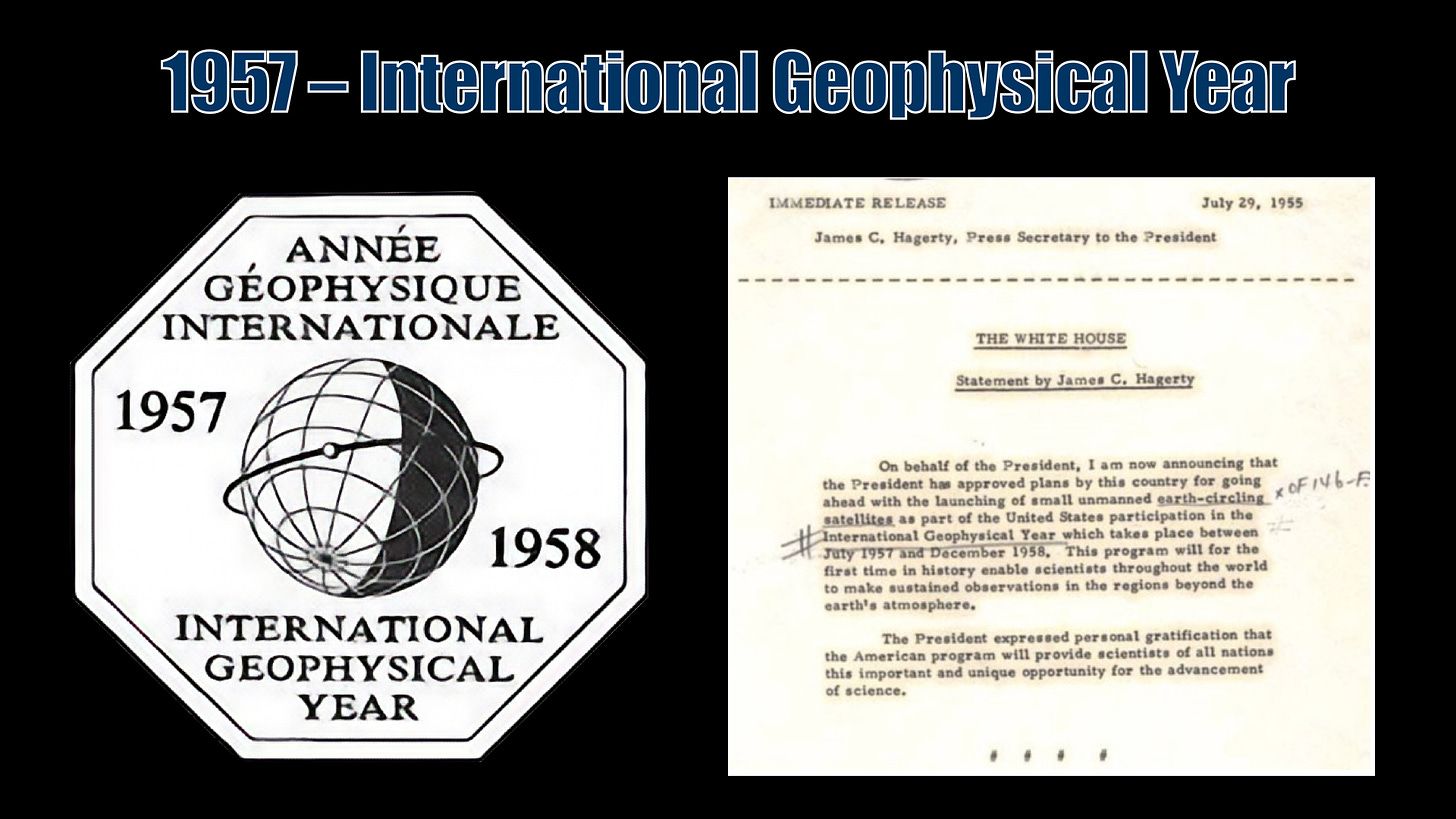
The International Geophysical Year started a process that leads up to our present day.

Of special importance was scientific problems that span across borders. This could be applied to areas like global health, oceanography and meteorology. They wrote: ”If it becomes possible to interfere actively in the big processes with the atmosphere, the results are likely to transcend national boundaries. The problems that will then arise must be handled on an international basis.”
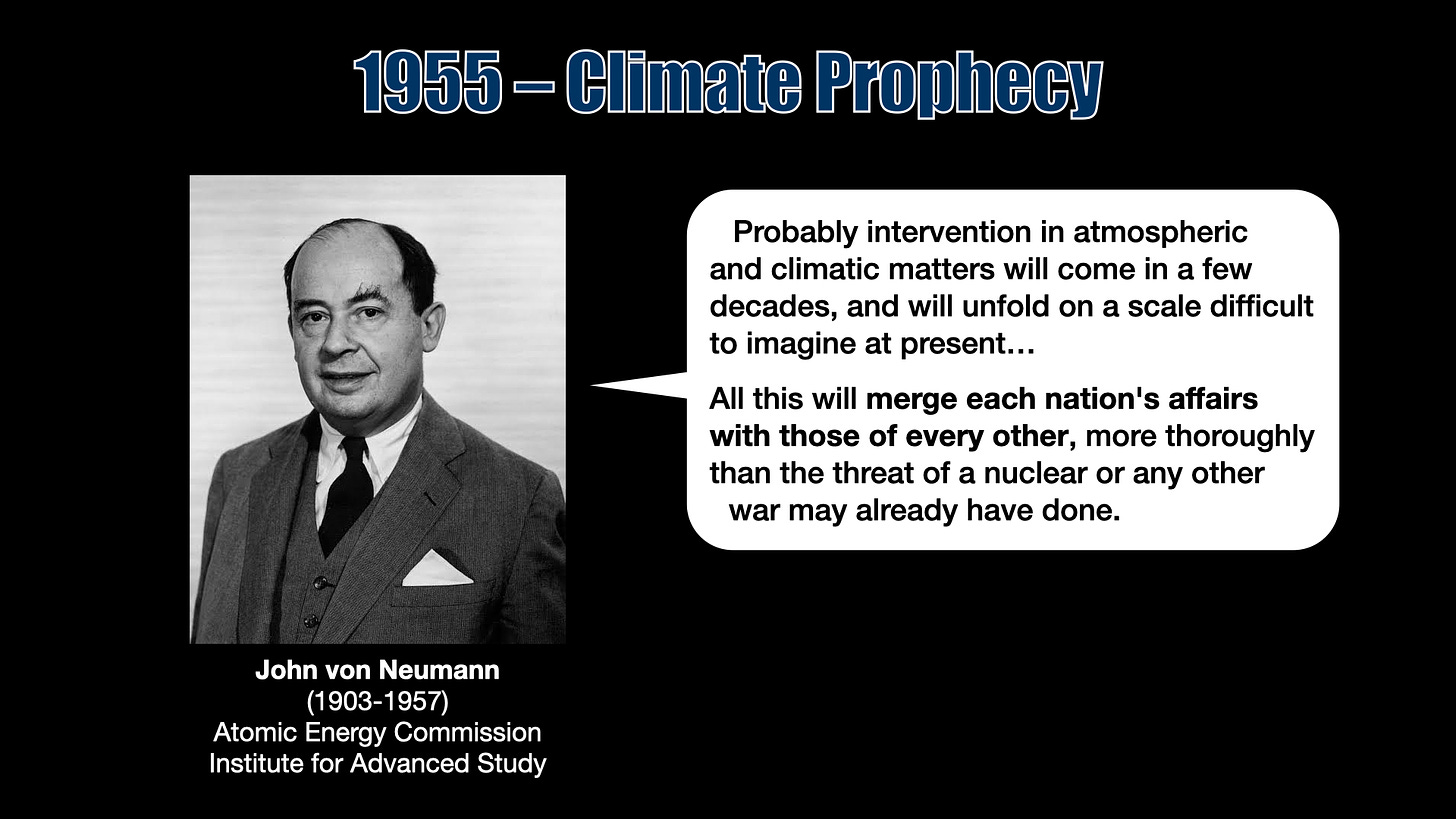
As mathematician and Rockefeller Foundation affiliated scholar John von Neumann prophesied in 1955: ”Probably intervention in atmospheric and climatic matters will come in a few decades, and will unfold on a scale difficult to imagine at present… All this will merge each nation’s affairs with those of every other, more thoroughly than the threat of a nuclear or any other war may already have done.”
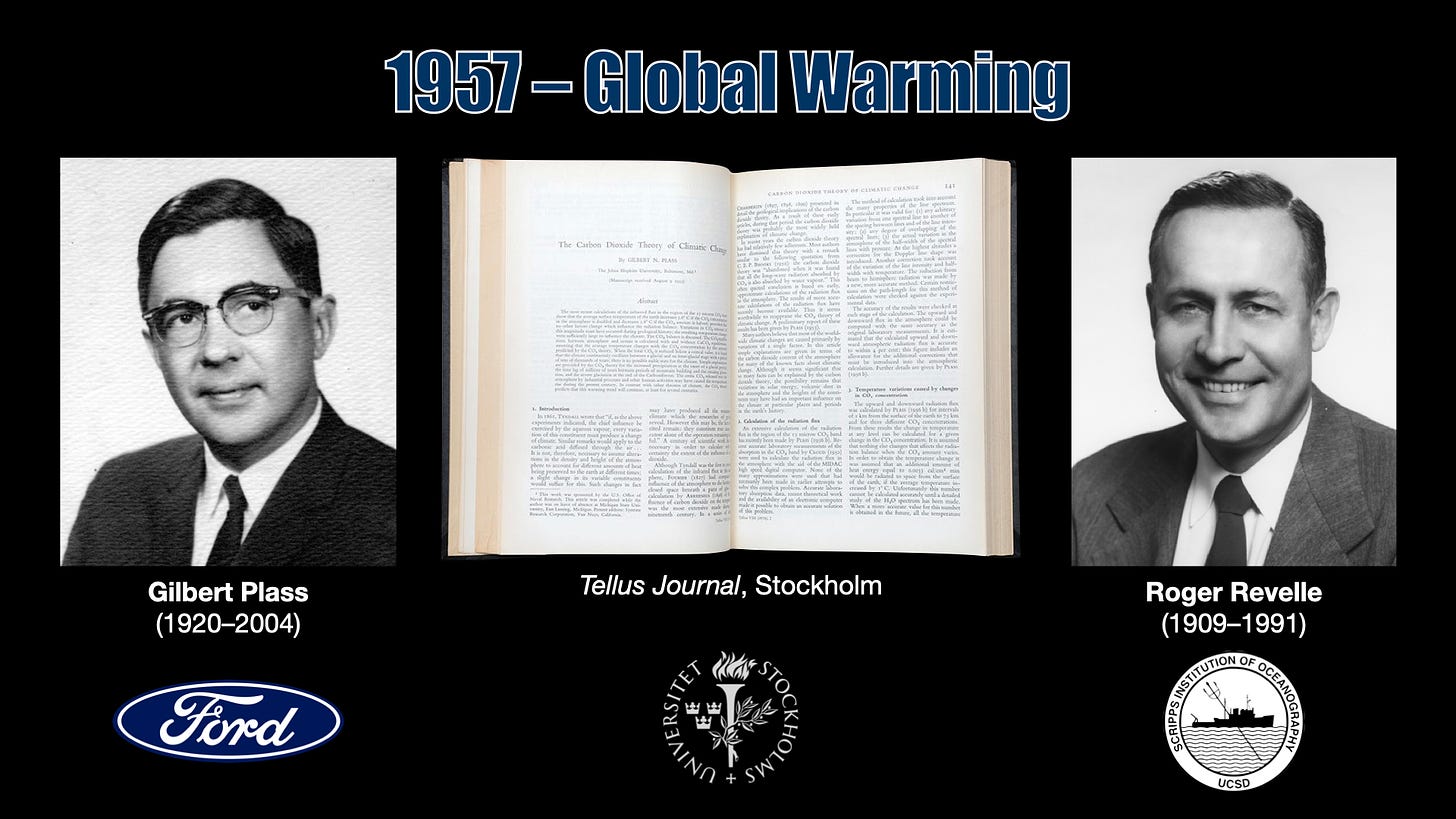
Oceanographer Roger Revelle, with funding from Rockefeller Foundation and the US Military, became an early advocate of the anthropogenic global warming theory together with Gilbert Plass from the Ford Motor Company. Their groundbreaking articles were published in the Swedish scientific journal Tellus Journal in 1956 and 1957 respectively.
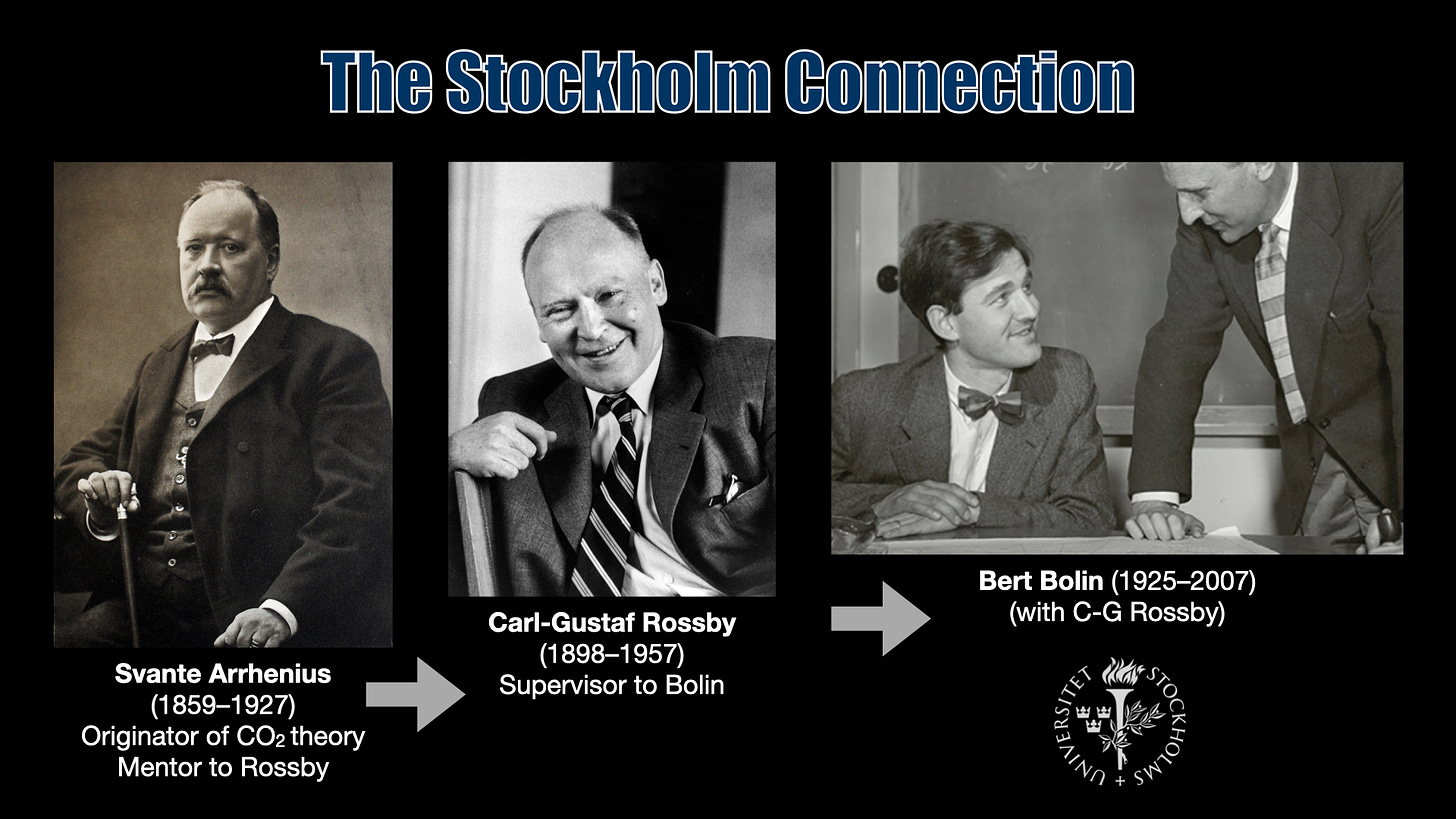
The Tellus Journal is a peer-reviewed journal published by the International Meteorological Institute in Stockholm. It was started by Swedish meteorologist Carl-Gustaf Rossby in 1948. He was a student to Svante Arrhenius, the originator of the carbon dioxide theory, and had made a rocket career at Woods Hole Oceanographic Institution and The University of Chicago during the 30s and 40s. Rossby initiated carbon dioxide measurements in the early 1950s and was the supervisor of Bert Bolin but died of a heart attack at a conference in 1957.
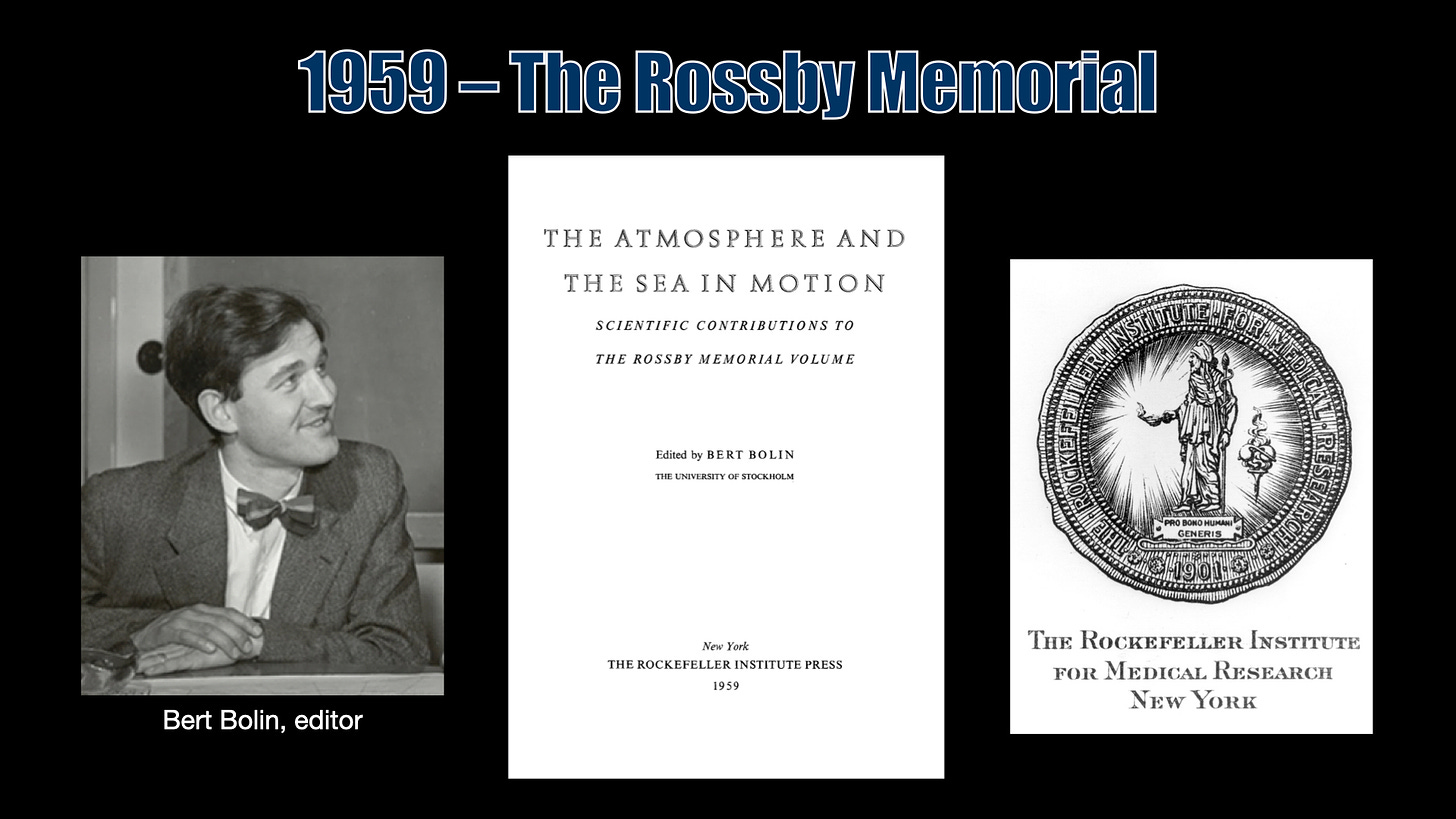
Both Rossby and Bolin were closely aligned to the Rockefeller scientific network. Stockholm would become a focal point for climate related research, with support from the Rockefeller network as well as the Swedish Government. Bolin, who would become the first chairman of IPCC in 1988, was the editor of a memorial book to C-G Rossby that was published by the Rockefeller Institute for Medical Research in 1959. This seemed an odd choice at the time…
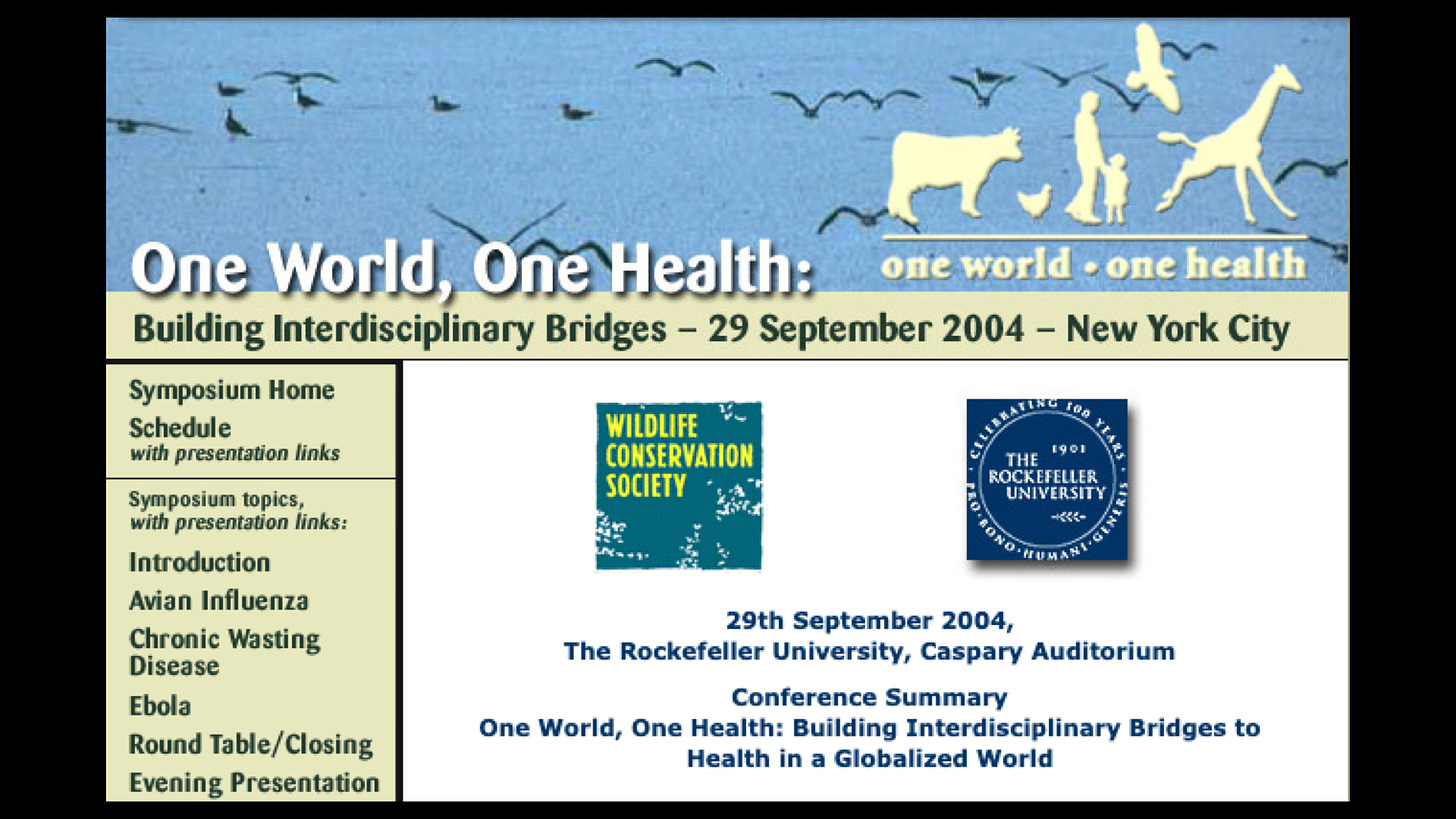
…but in 2004 the One World – One Health concept, combining animal, human and environmental health, was developed at a symposium hosted by the Rockefeller University and organised by the Wildlife Conservation Society. As I mentioned earlier. Once led by Fairfield Osborne Junior and Laurance Rockefeller from the Conservation Foundation.
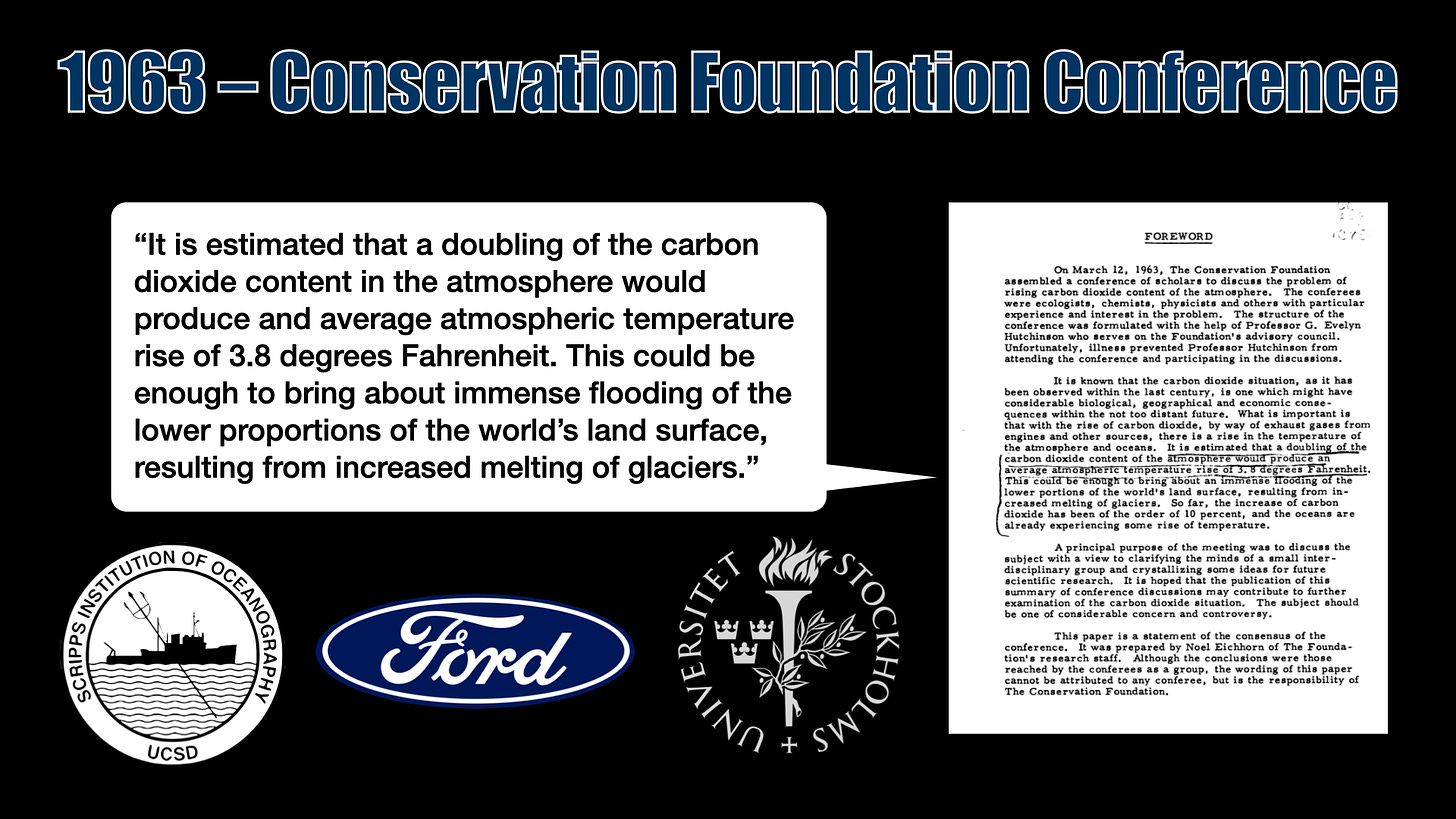
The Conservation Foundation arranged the first international conference about the influence on carbon dioxide on the climate in 1963. Among the seven participants, there were only three real climate scientists. Charles Keeling from Scripps, Erik Eriksson from International Meteorological Institute at Stockholm University and Gilbert Plass from the Ford Motor Company. They concluded that a temperature rise of 3.8 degrees Fahrenheit ”could be enough to bring about immense flooding of the lower proportions of the world’s land surface, resulting from increased melting of glaciers.” and recommended a watchdog on CO2.
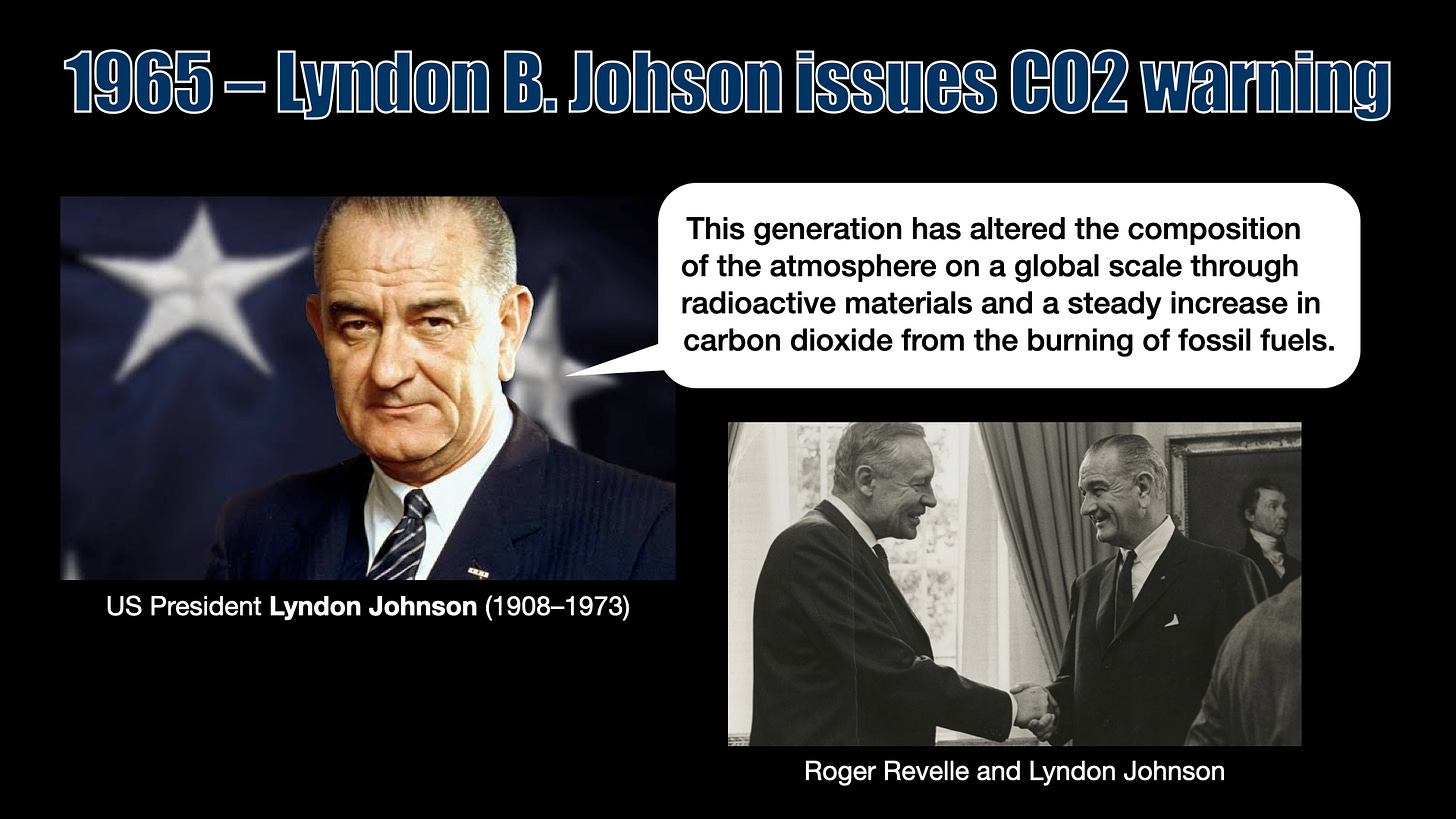
In 1965, US President Lyndon Johnson became the first president to warn about the effects of carbon dioxide from the burning of fossil fuel. Roger Revelle served as his scientific advisor.
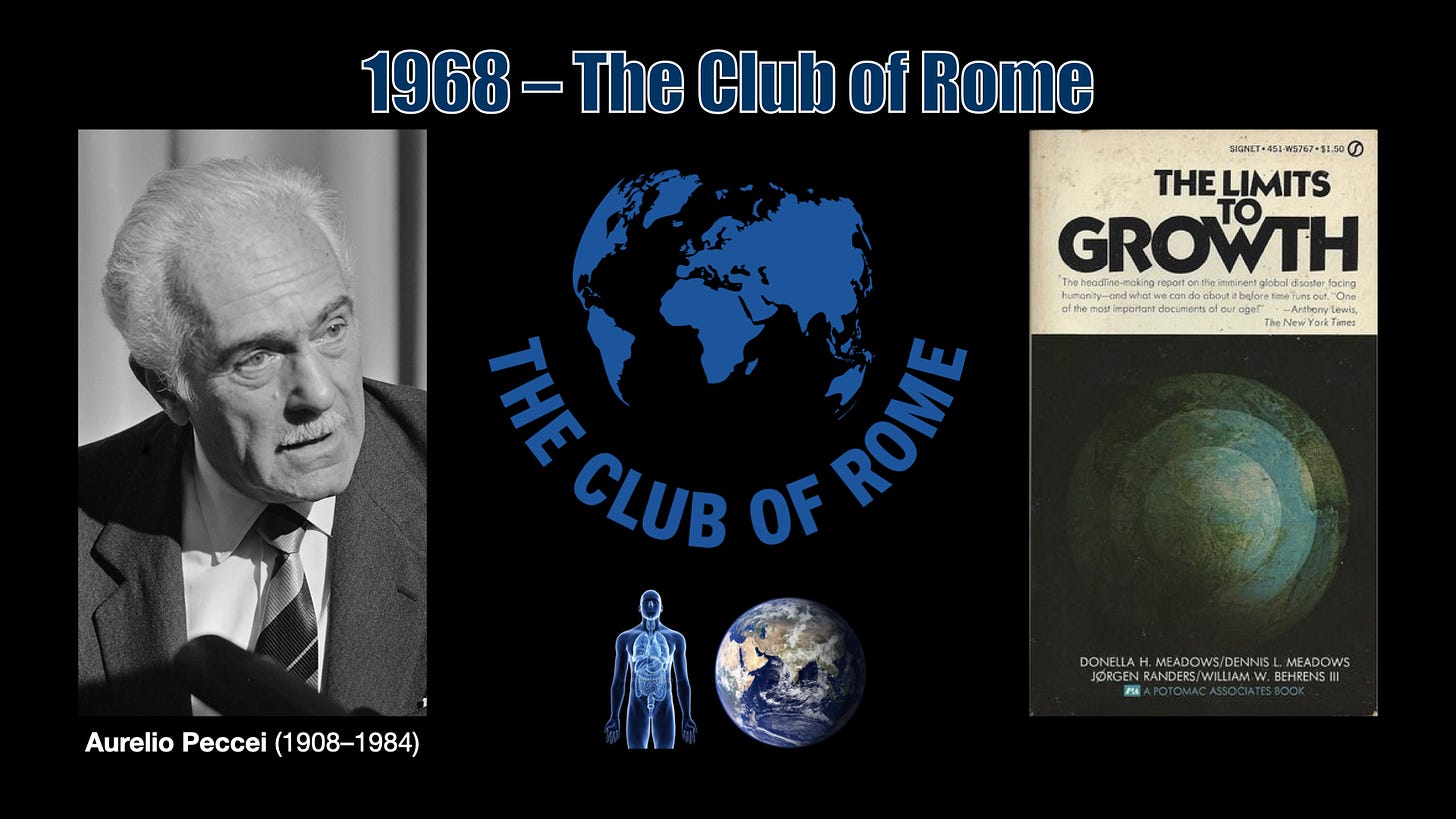
The climate issue was then picked up by the neo-malthusian environmental think tank Club of Rome, led by Italian industrialist Aurelio Peccei, that had been started with a grant from Peccei’s boss from the car-manufacturer Fiat, Giovanni Agnelli. A close business associate and friend of David Rockefeller’s.
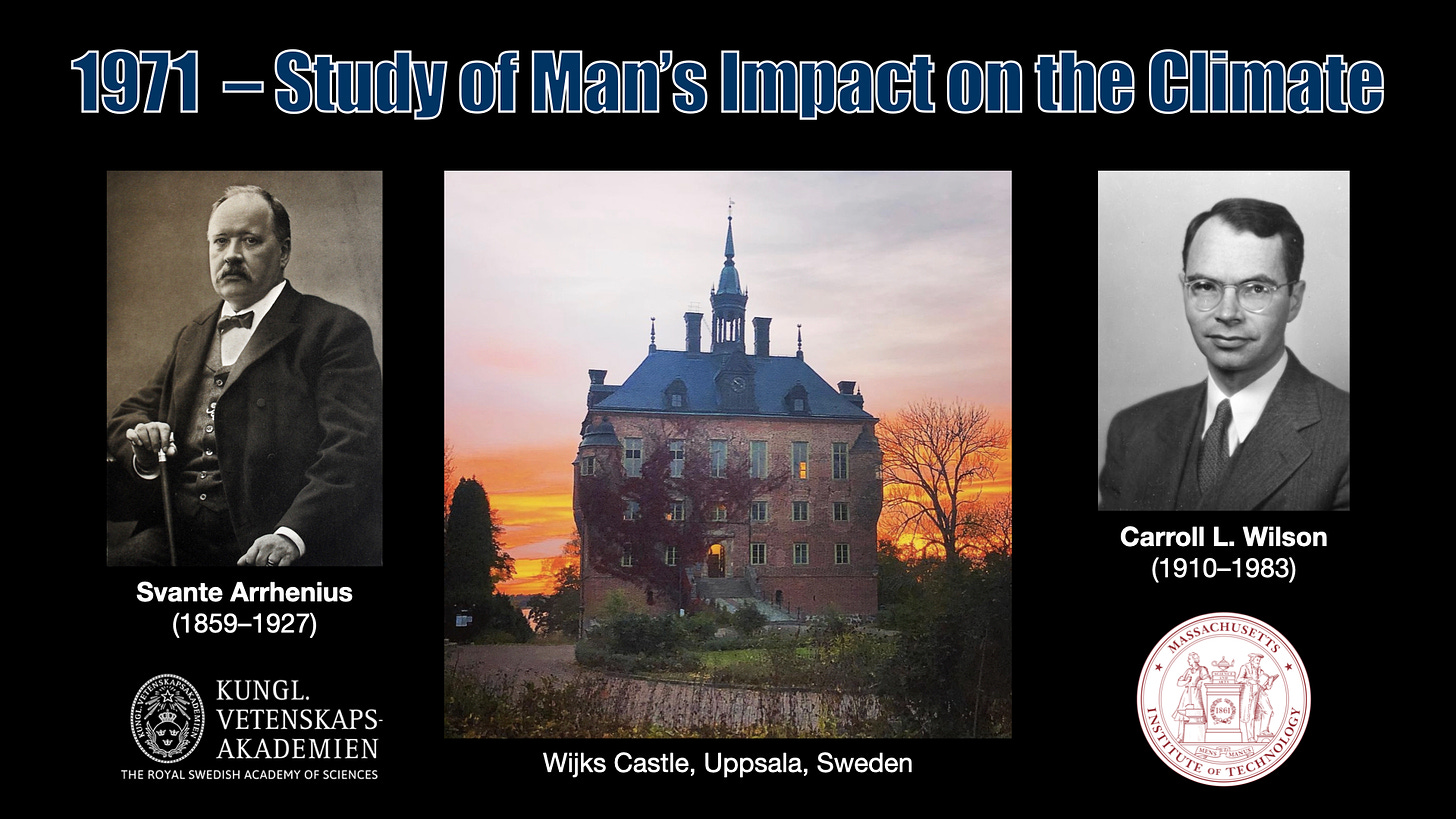
In 1971, Club of Rome board member Carrol L. Wilson from MIT anchored the climate issue, in collaboration with The Royal Swedish Academy of Sciences, during the conference Study of Man’s Impact on the Climate at Svante Arrhenius birthplace Wijks Castle outside of Uppsala in Sweden. Wilson had been a member of the Special Studies Project and was a close friend of Nelson Rockefeller.
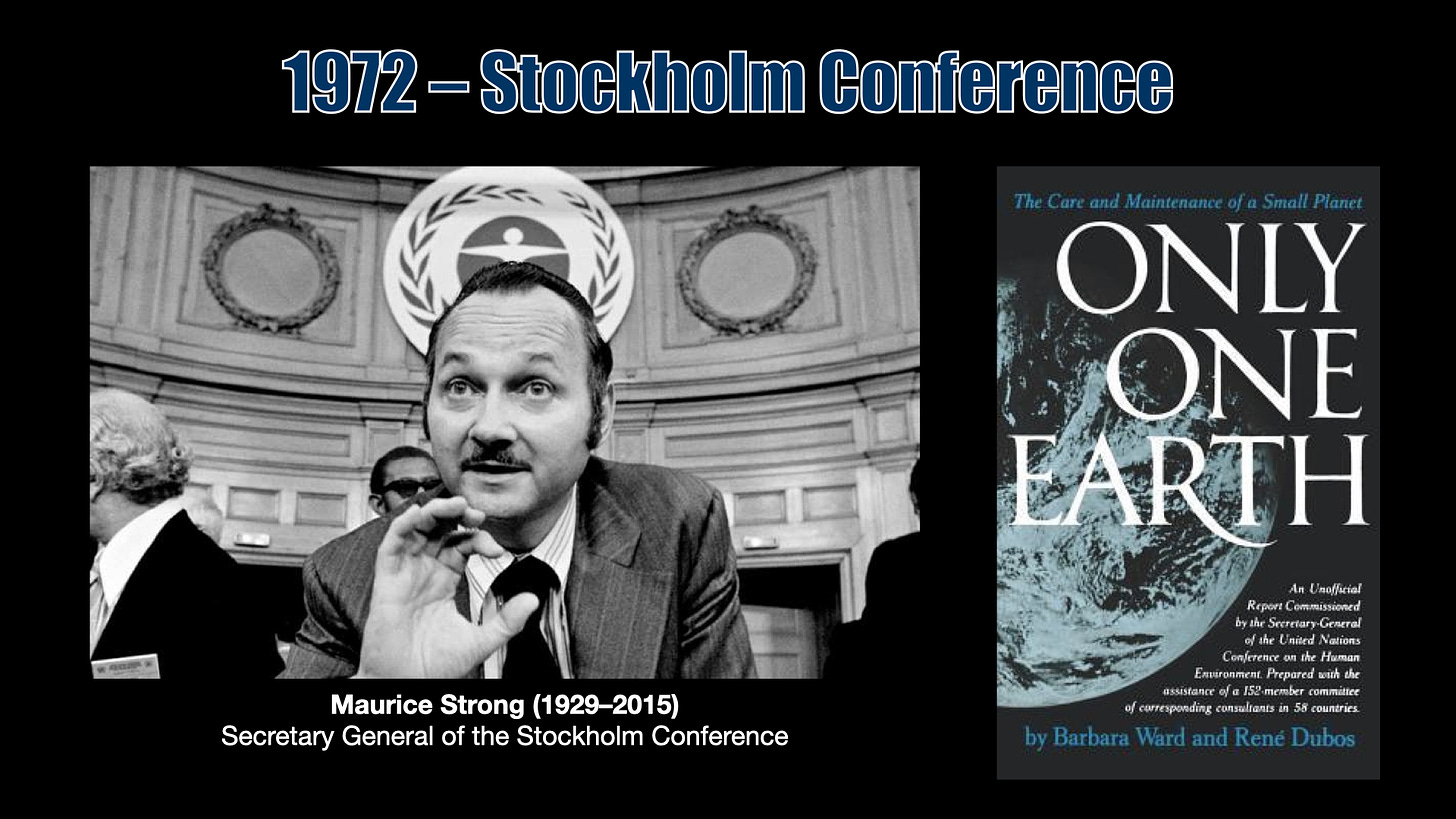
The conference report was widely distributed at United Nations Conference on the Human Environment in Stockholm the following year. A conference that was led by secretary general Maurice Strong with Wilson as an advisor. Strong was a member of the Club of Rome and a Rockefeller Foundation trustee.
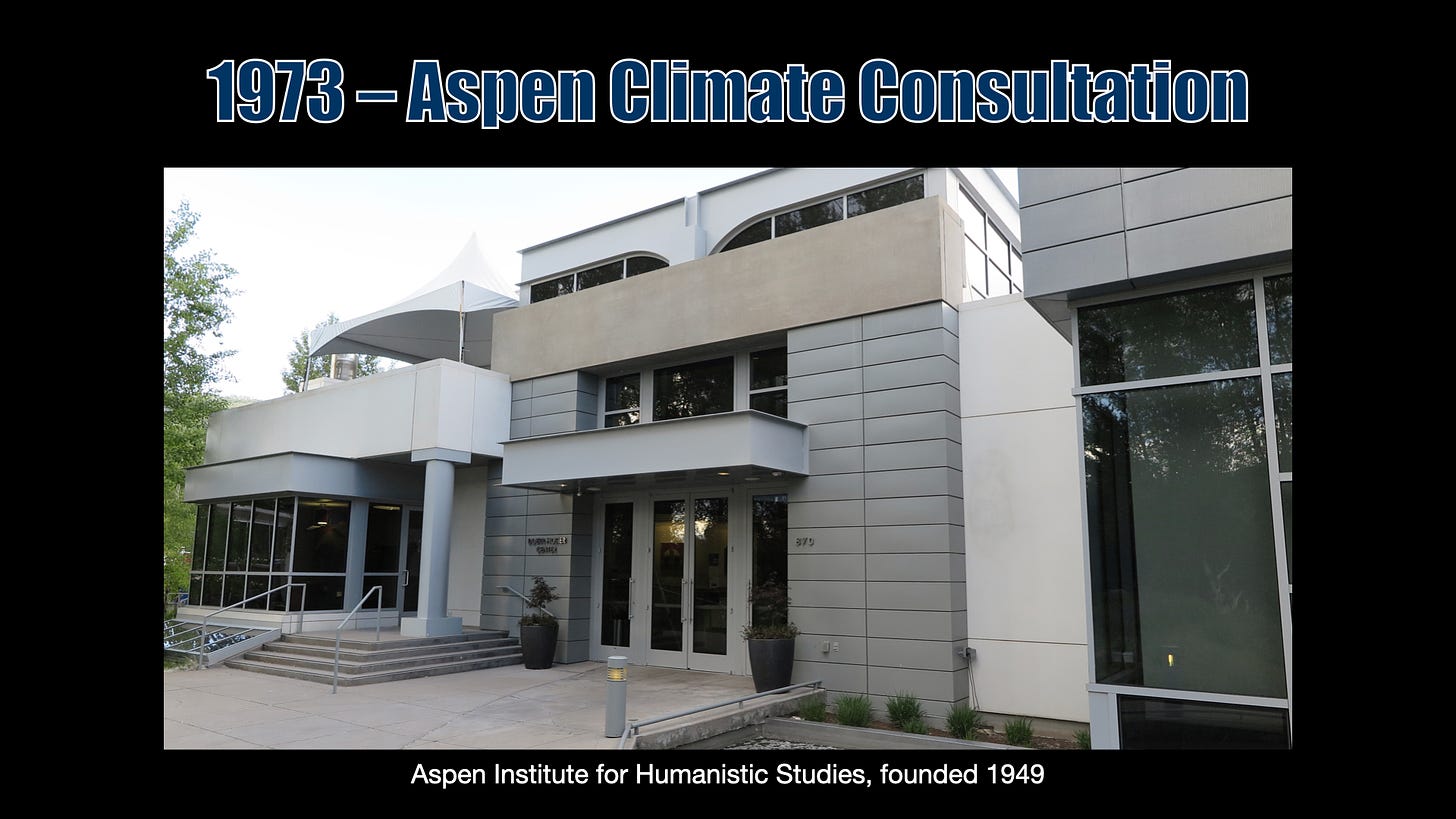
Strong got educated in matters involving the climate and planetary boundaries at the Aspen Institute in Colorado by leading scientists like Carrol L. Wilson. Aspen, that was led by oil magnate Robert O. Anderson, had been deeply involved in the preparations of the Stockholm Conference.
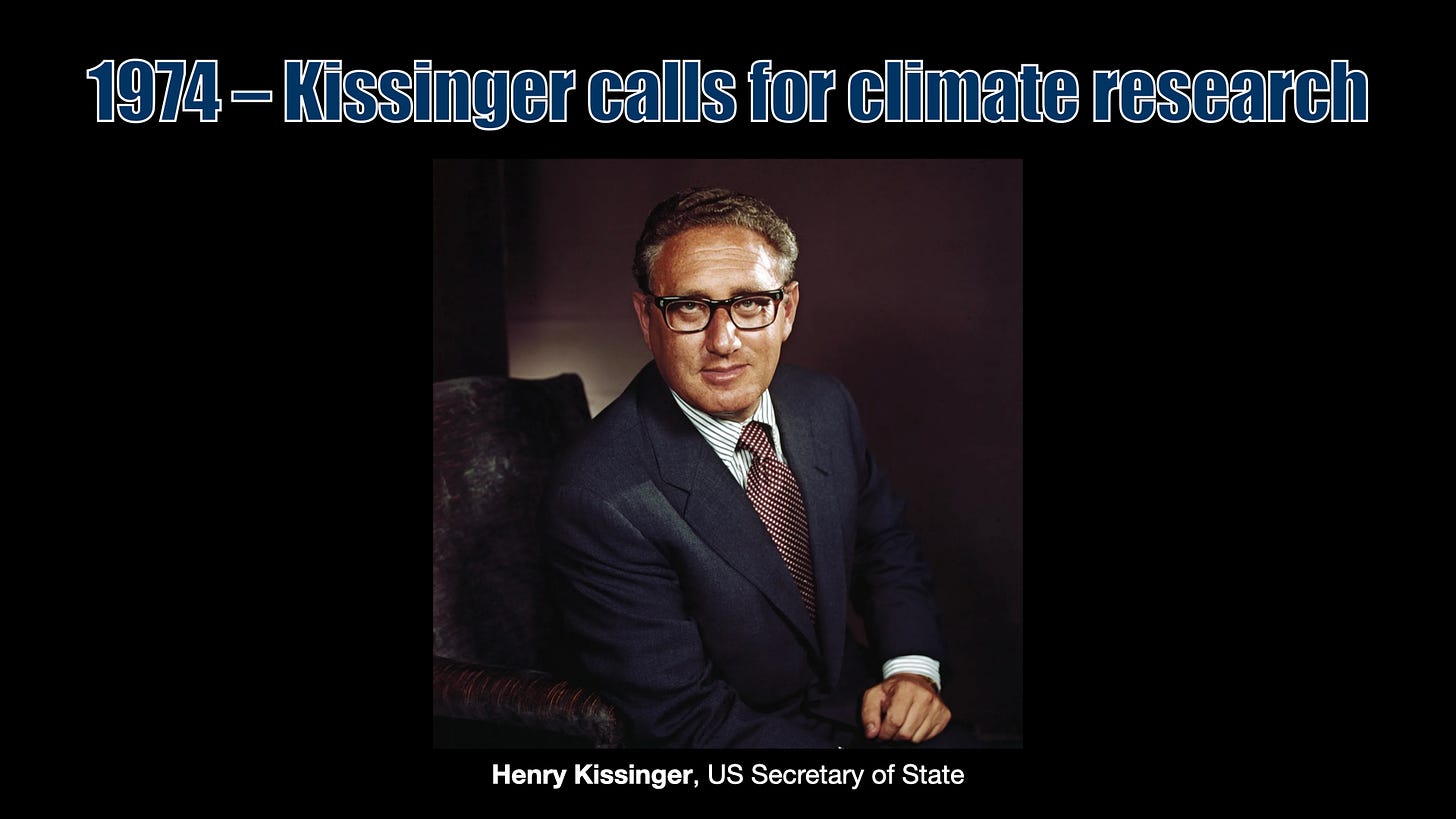
A year later, the newly appointed US Secretary of State Henry Kissinger called for better climate research in a speech at the United Nations.
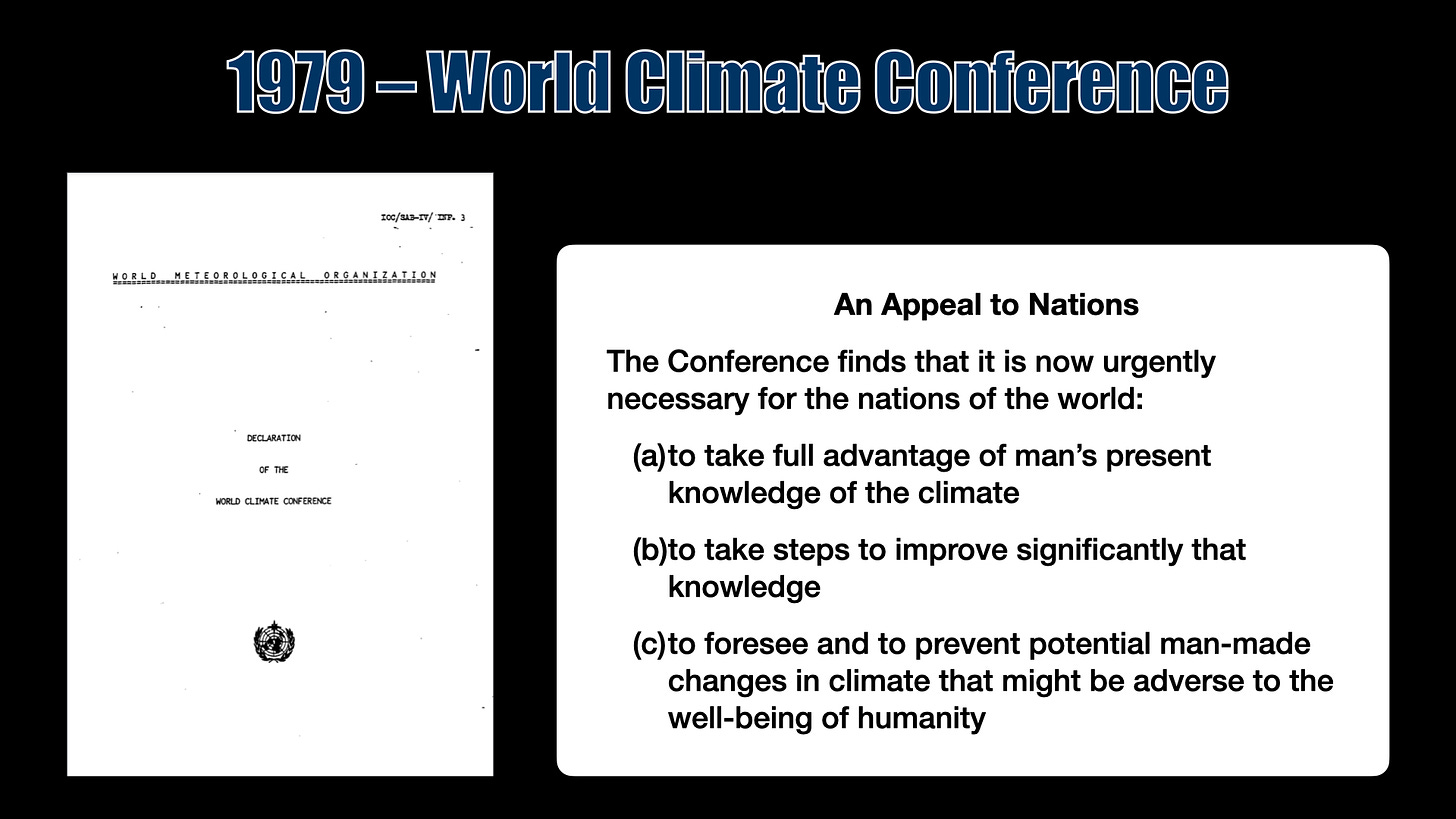
His call was heeded. At the World Climate Conference in Geneva in 1979 the ball started to roll. An appeal was made ”to foresee and to prevent potential man-made changes in climate that might be adverse to the well-being of humanity”. It initiated the World Climate Programme that arranged conferences about man-made climate change during the 1980s with Bert Bolin in a leading role.
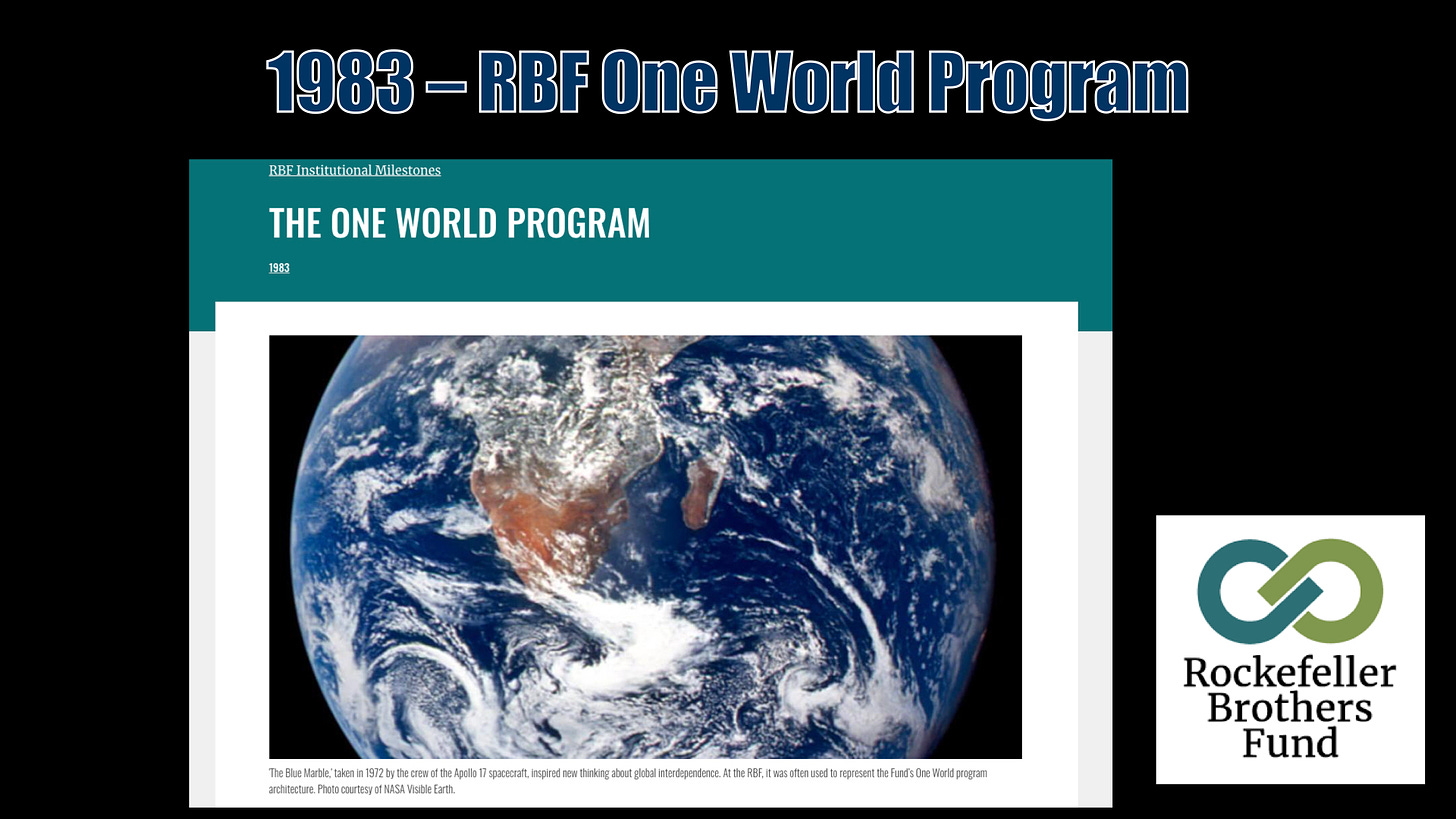
Rockefeller Brothers Fund jumped on the bandwagon and started to allocate money to climate change policy. It was a part of their One World Program, and a continuation of the work they had started with Special Studies Project 25 years earlier.
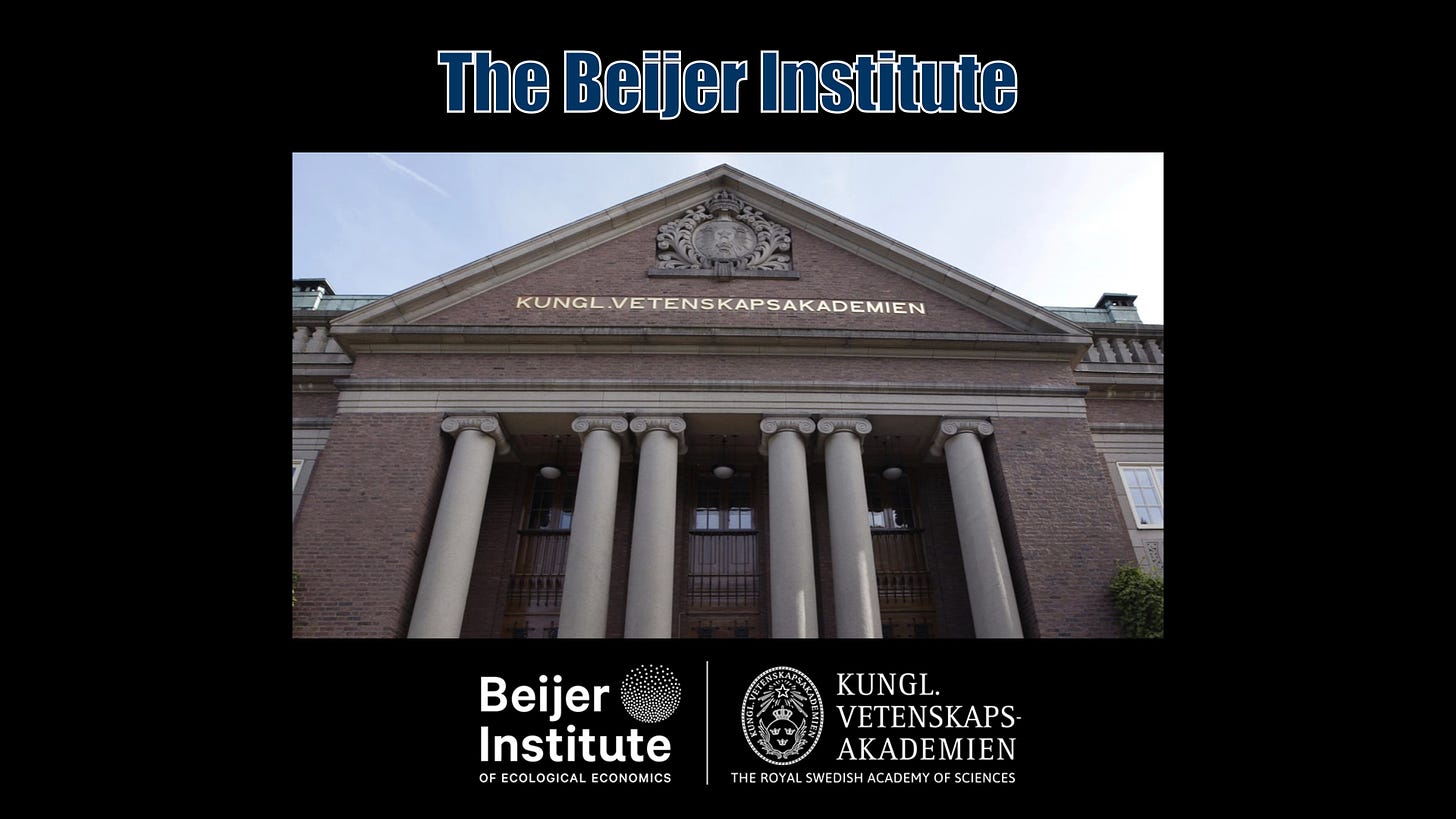
One of the recipients was the Beijer Institute in Stockholm. Founded in 1977 by the private Beijer Foundation and The Royal Swedish Academy of Sciences with the British ecologist Gordon Goodman as the founding director. He would become one of Rockefeller Brother Fund’s most important asset during the 80s.
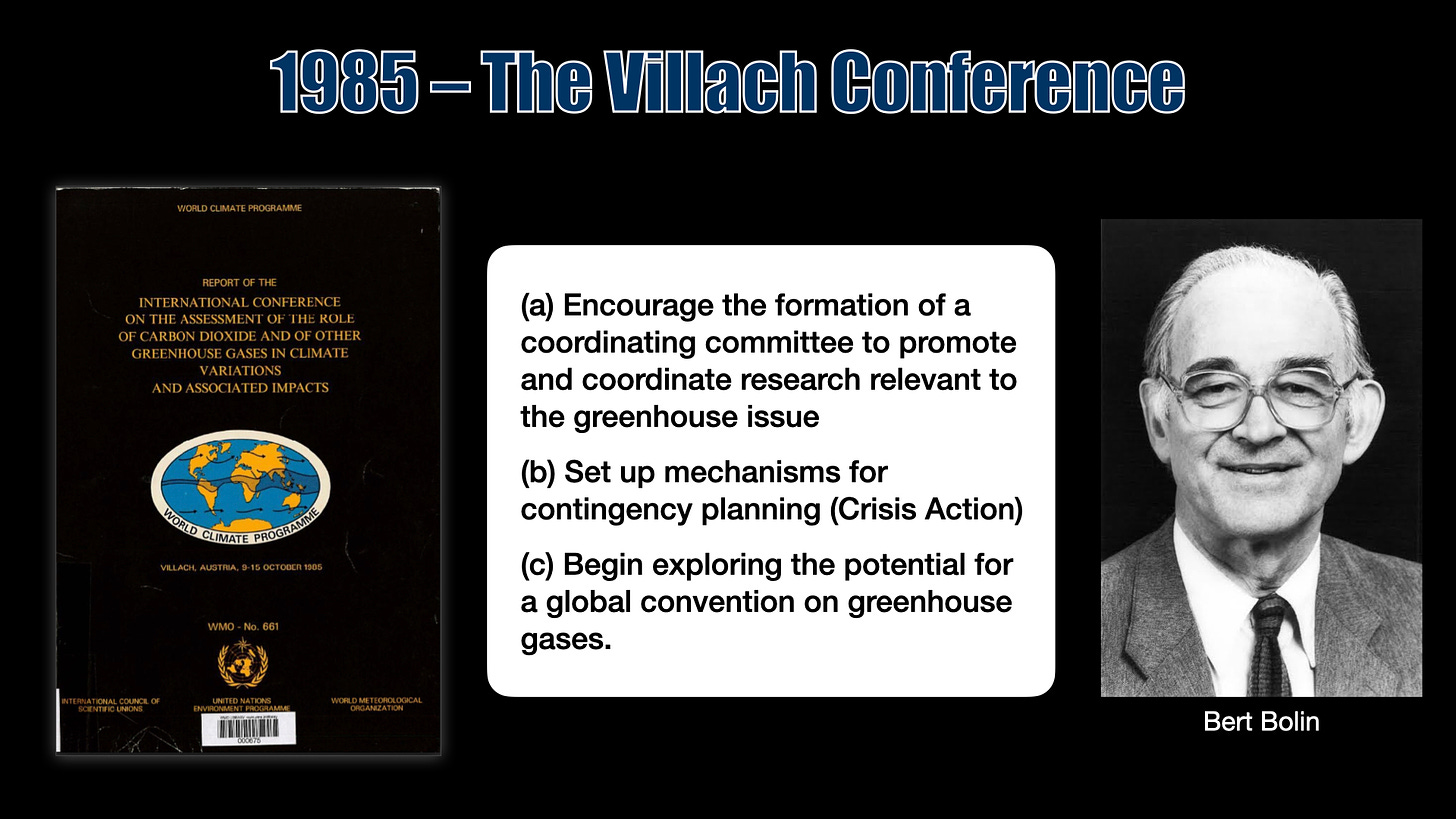
Goodman and Bolin became a powerful duo. The Villach Conference in 1985 was a decisive conference with both of them as conductors. Bolin had prepared the background paper and Gordon Goodman was the chair of the working group on CO2 emissions. Their recommendations was to: a) encourage the formation of a coordinating committee to promote and coordinate research relevant to the greenhouse issue, b) set up mechanisms for contingency planning and c) begin exploring the potential for a global convention on greenhouse gases. This had huge implications on future development.
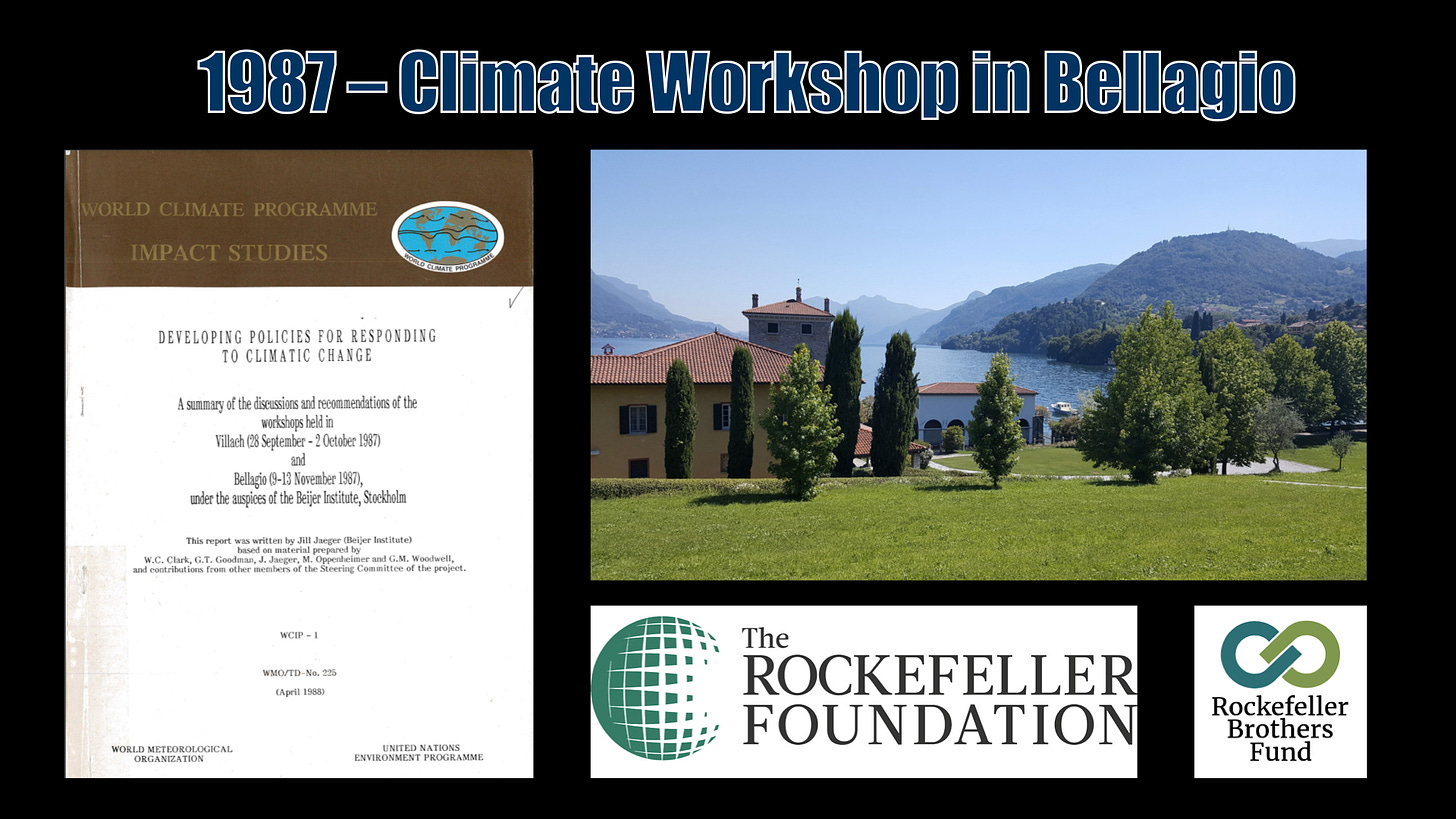
The Beijer Institute and Gordon Goodman was then responsible for two workshops that was held in Villach, and at Rockefeller Foundations Bellagio Center in the autumn of 1987. These were sponsored by RBF, Rockefeller Foundation and UNEP with the mission to develop polices for responding to climatic change. Bert Bolin was a member of the steering committee.
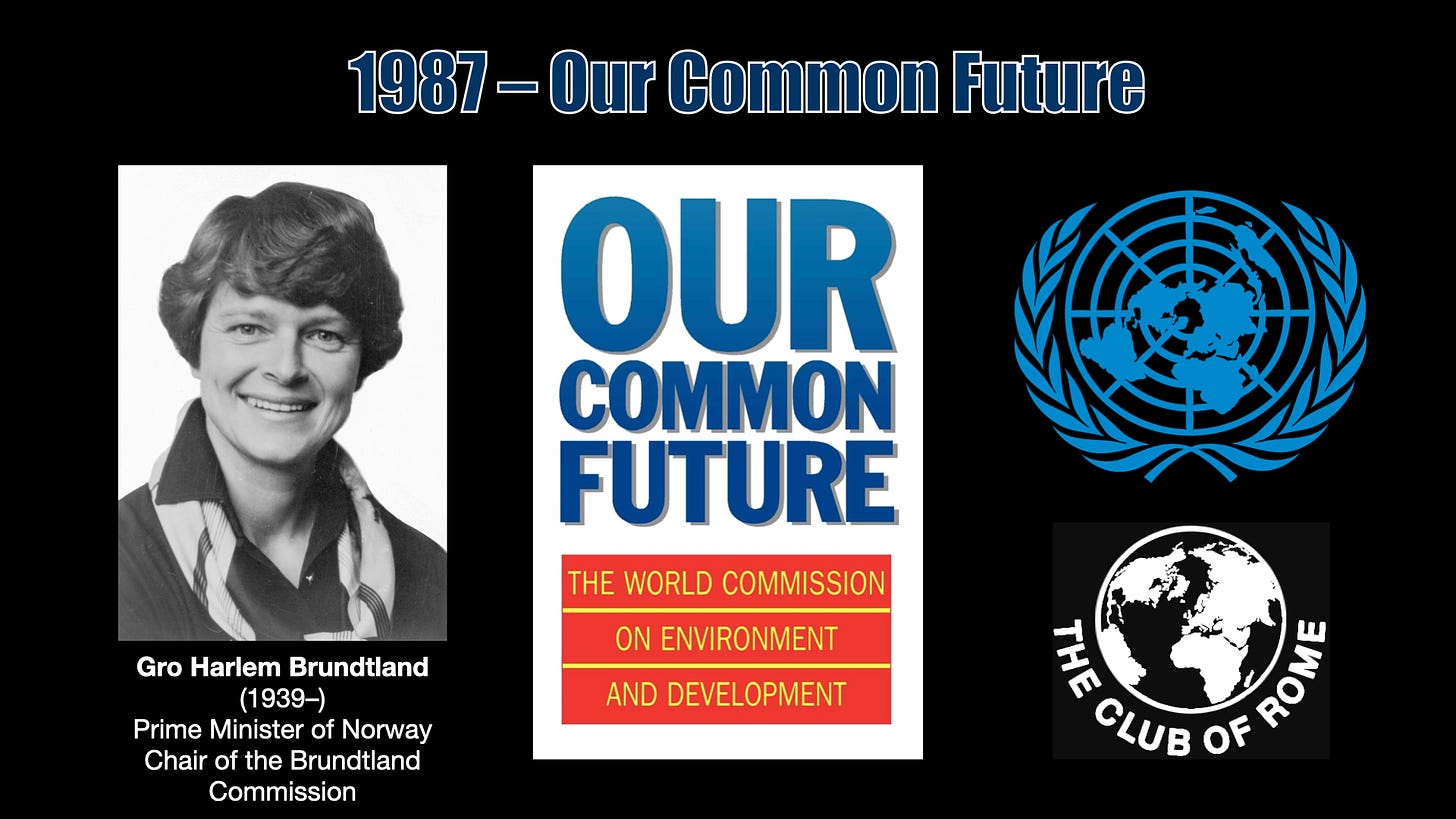
Goodman also wrote the chapter about energy in the Brundtland report, Our Common Future, and added the part about anthropogenic climate change upon the request and funding from the Rockefeller Brothers Fund.
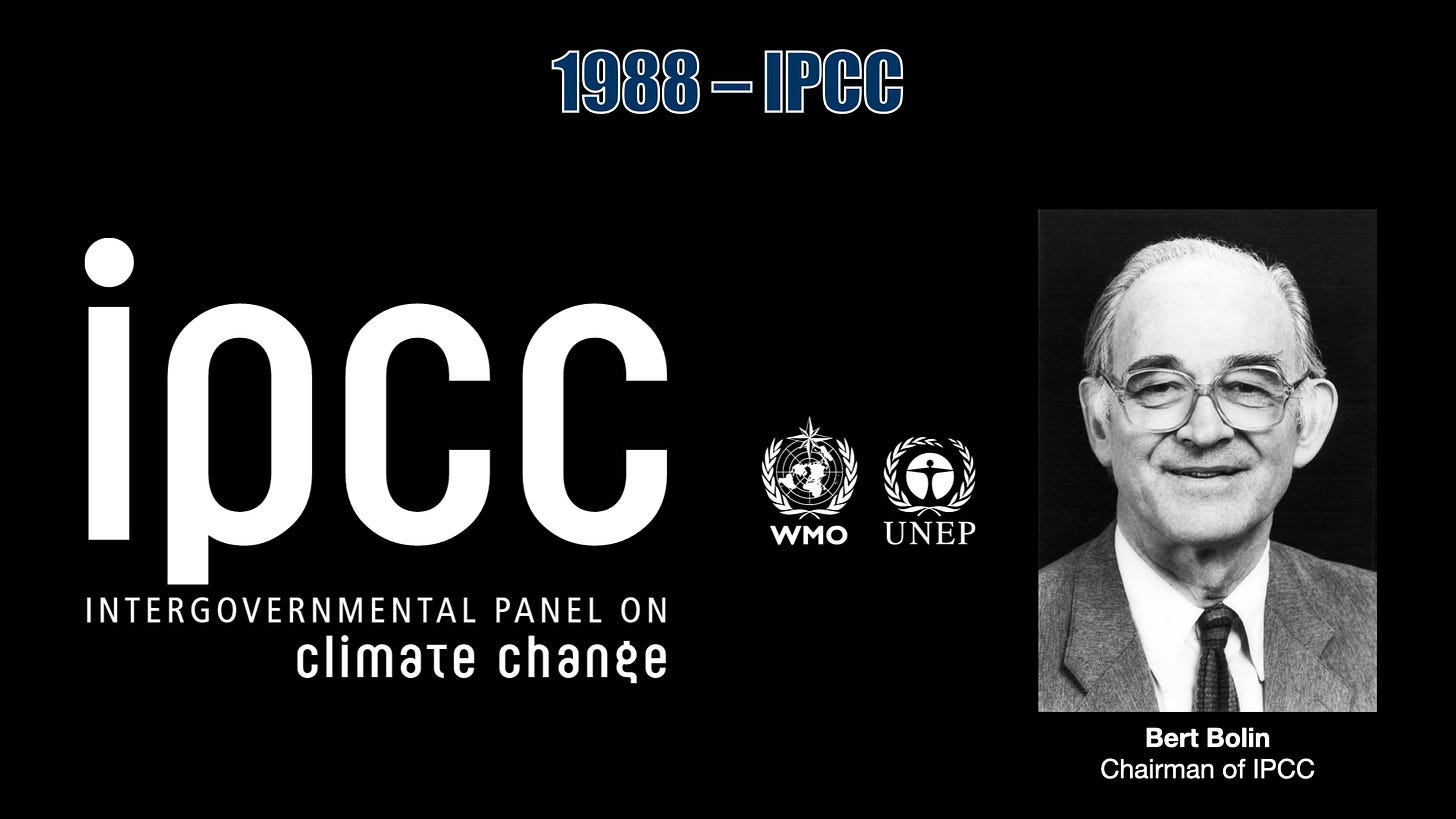
All this work gave the desired result. After the Reagan Administration and US Secretary of State George Schultz had sent a draft proposal about an intergovernmental panel on climate science to WMO, the International Panel on Climate Change was founded in 1988 with Bert Bolin as chairman. United Nations General Assembly declared that climate change was a common concern of mankind.
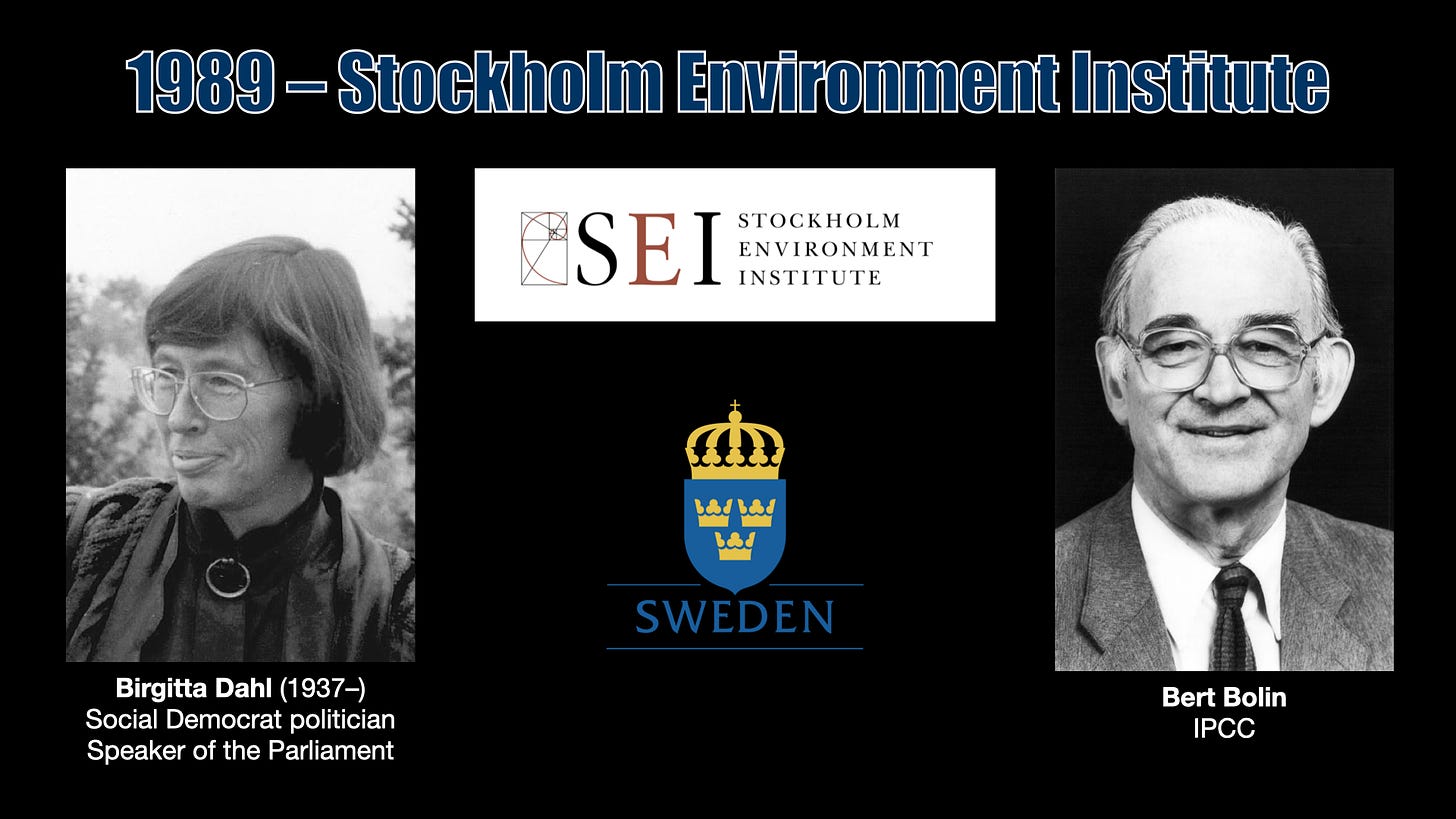
In January 1989, the Stockholm Environment Institute was founded by the Swedish Government with the aim of bridging science, policy and practice. Social Democrat politician Birgitta Dahl and Bert Bolin were co-founders with Gordon Goodman assuming the role as the first director. Offices were started in Stockholm, Boston and York. This was a political project. Bolin was a government advisor and had been a close friend with former Swedish Prime Minister Olof Palme.
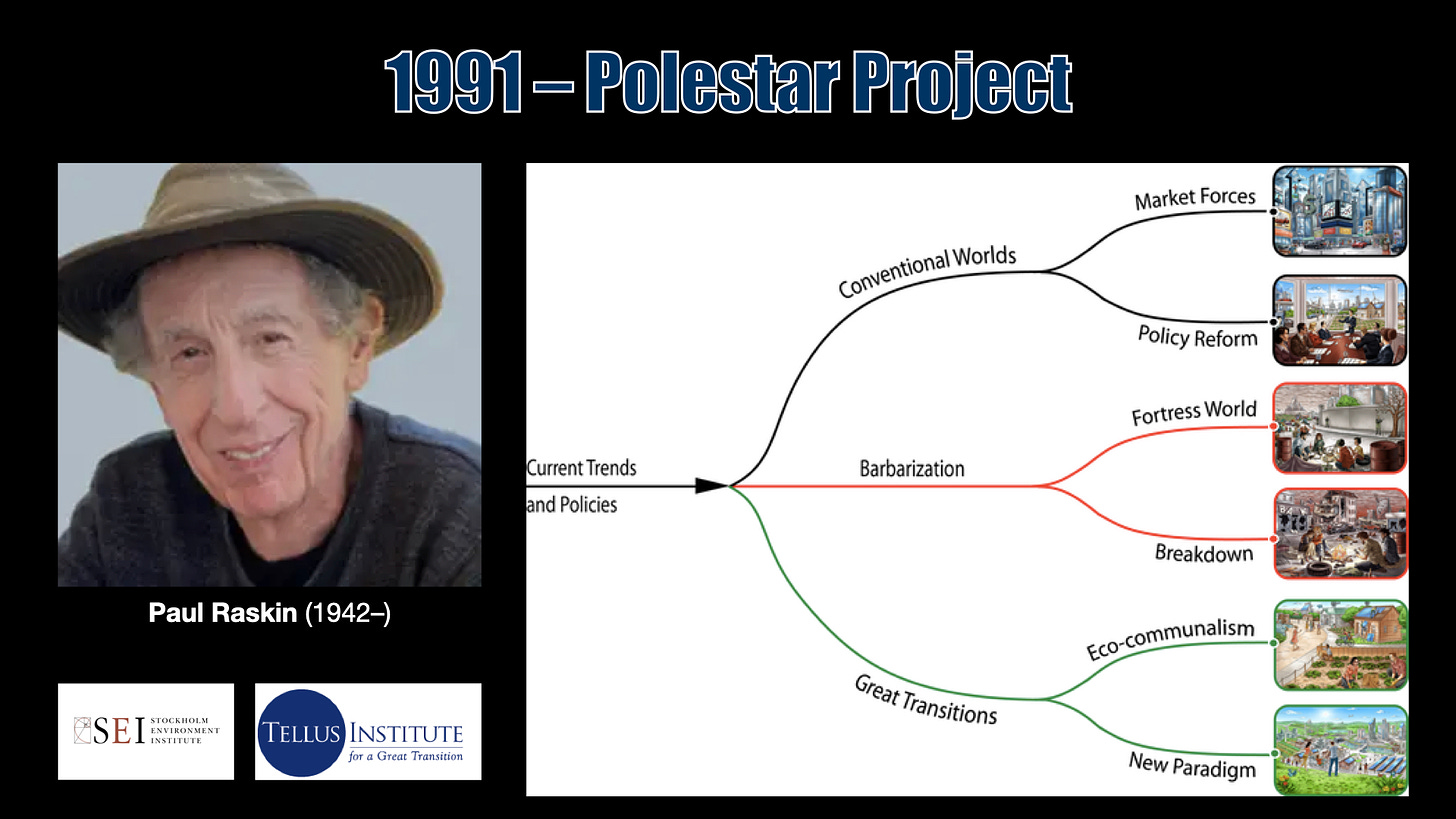
SEI started the Polestar Project together with the American Tellus Institute in 1991 with the aim to develop scenarios for how a planetary civilisation with a global authority could be achieved. They analysed possible paths towards the new world order that RBF had envisioned in 1956. Funding came from Rockefeller Foundation and UNEP. Gordon Goodman was leading the project together with Tellus Institute director Paul Raskin. Bert Bolin served as a reviewer. This project later evolved into The Great Transition Initiative.
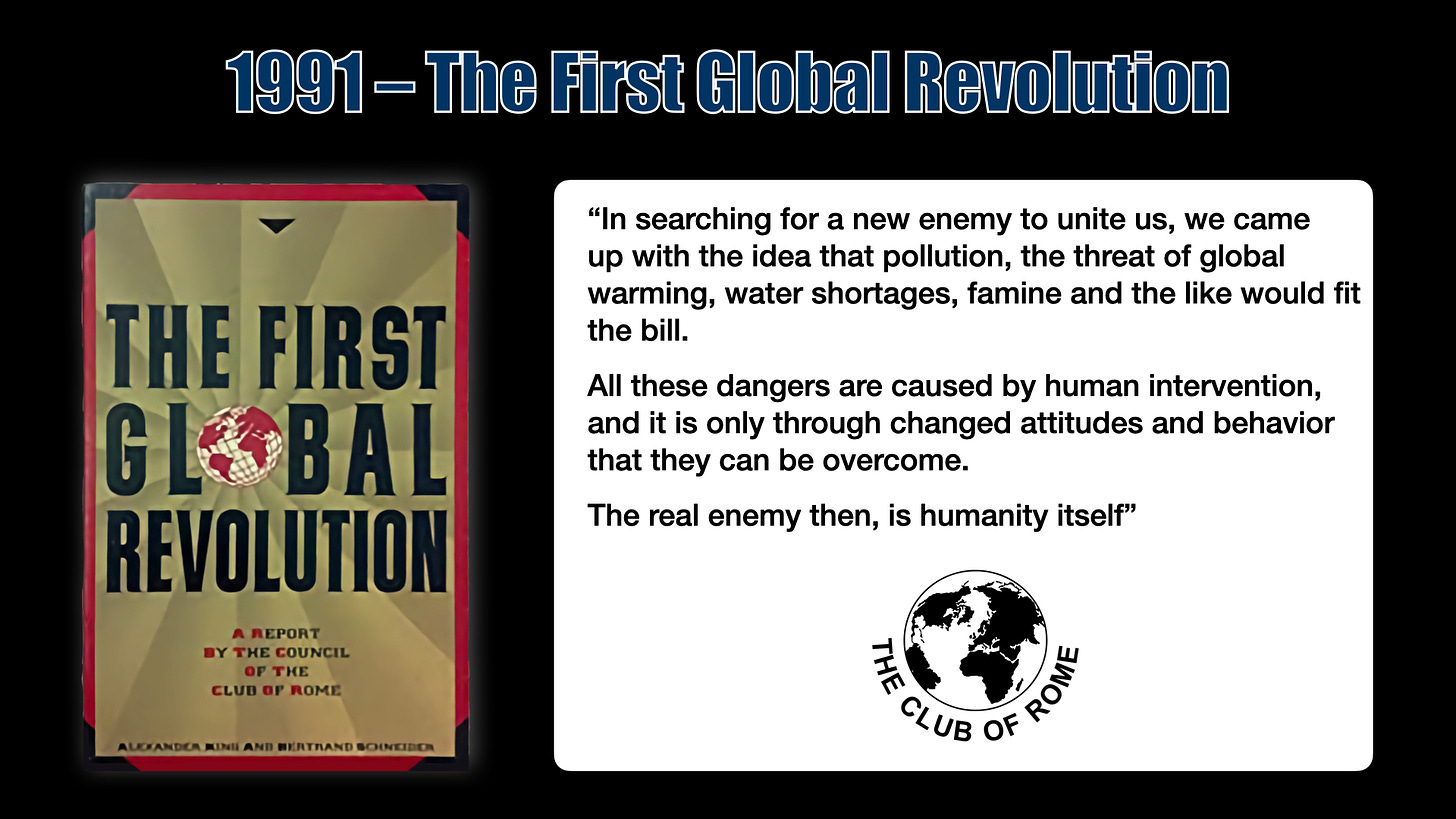
Raskin is a member of the Club of Rome.That same year the club admitted in The First Global Revolution that global warming was a threat that was used to unite the world and that the real enemy was humanity itself.
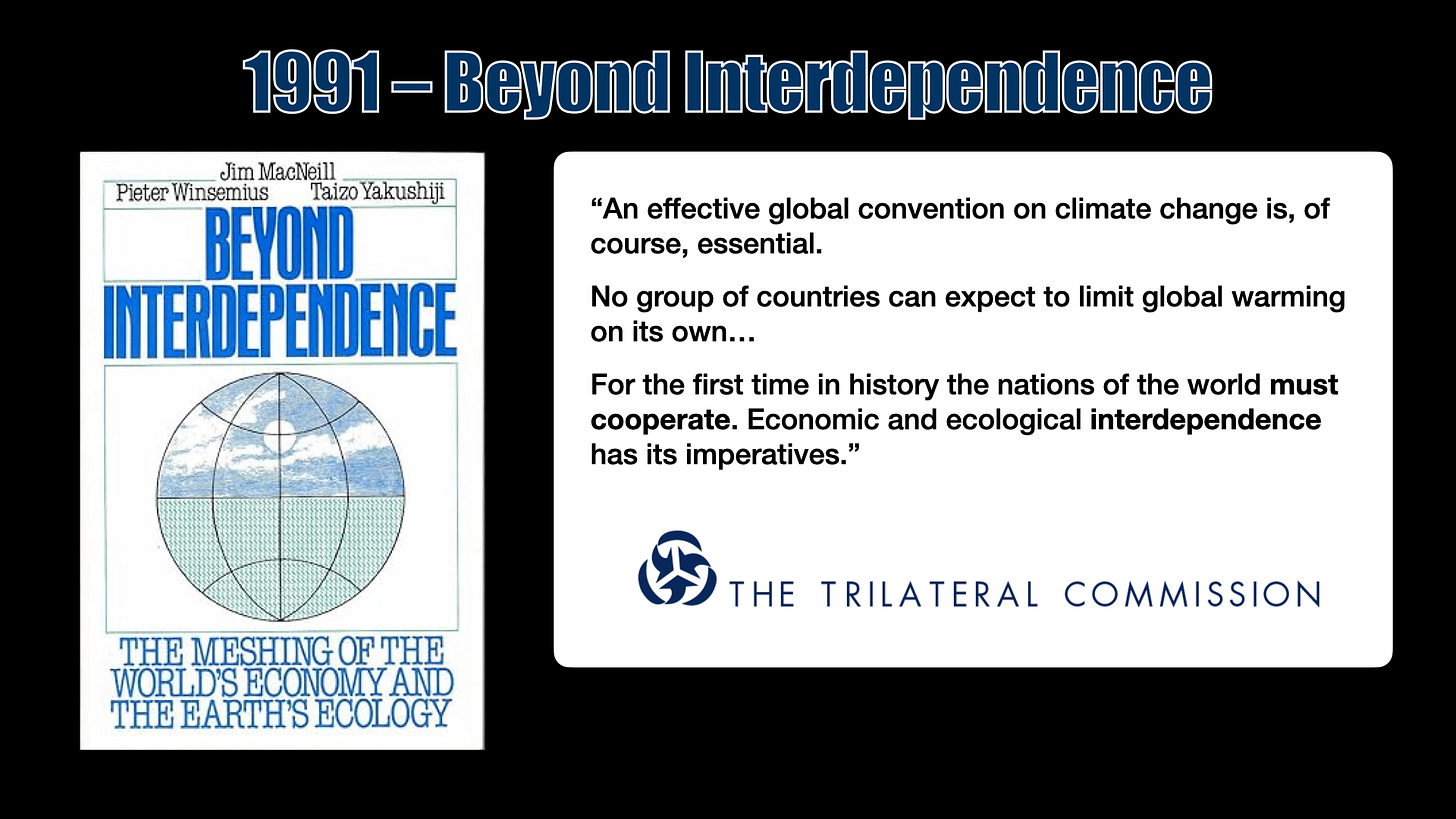
The Rockefeller network had now achieved their first goal. David Rockefeller’s powerful think tank the Trilateral Commission released the report Beyond Interdependence to set the course for the future and presented an action plan. They stated that Global Warming couldn’t be limited by countries on their own. They had to cooperate. The next step was to develop an effective global convention on the climate.
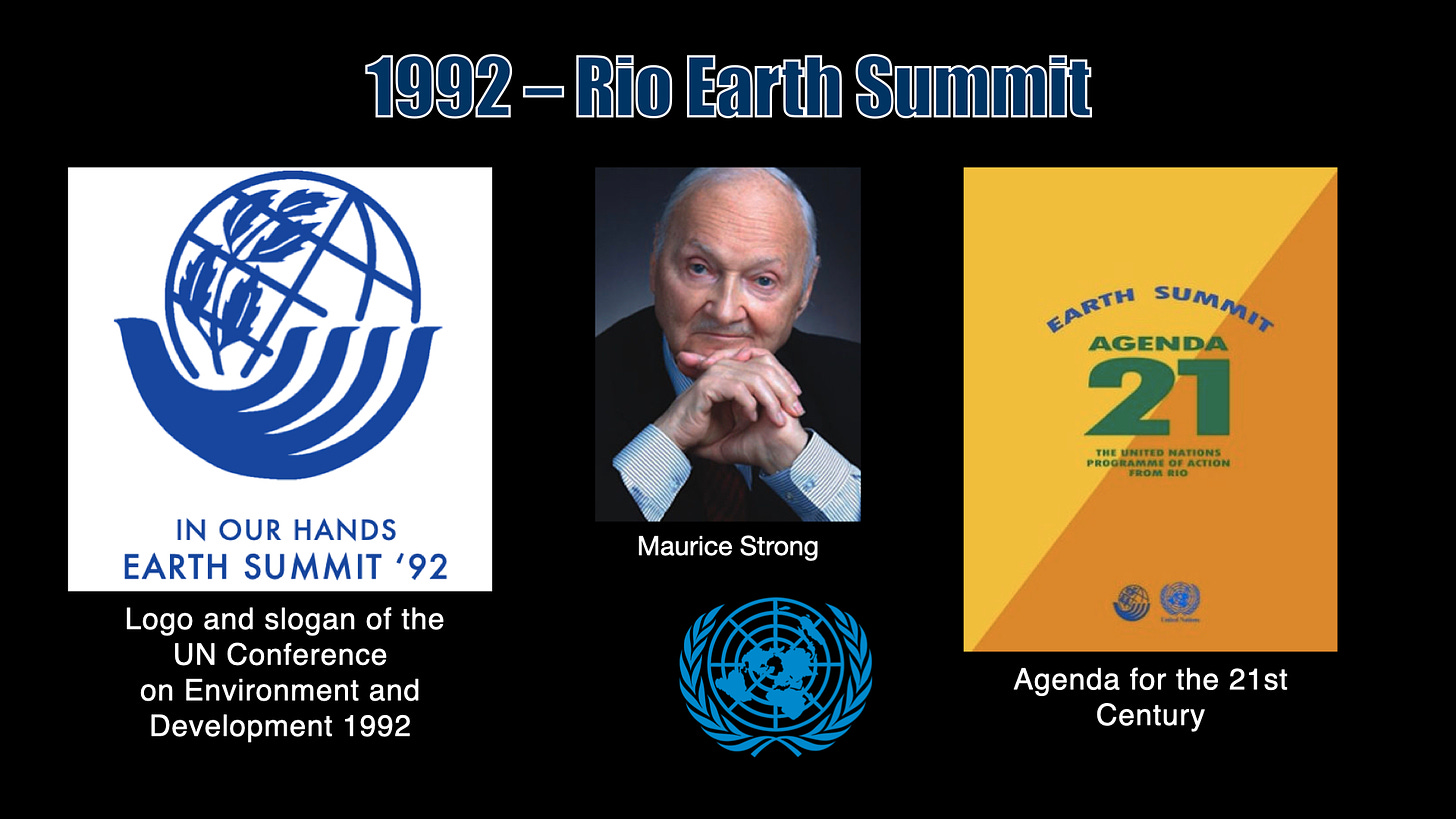
This was a part of the agenda at the Earth Summit in Rio De Janeiro in 1992. A summit led by Rockefeller henchman Maurice Strong.
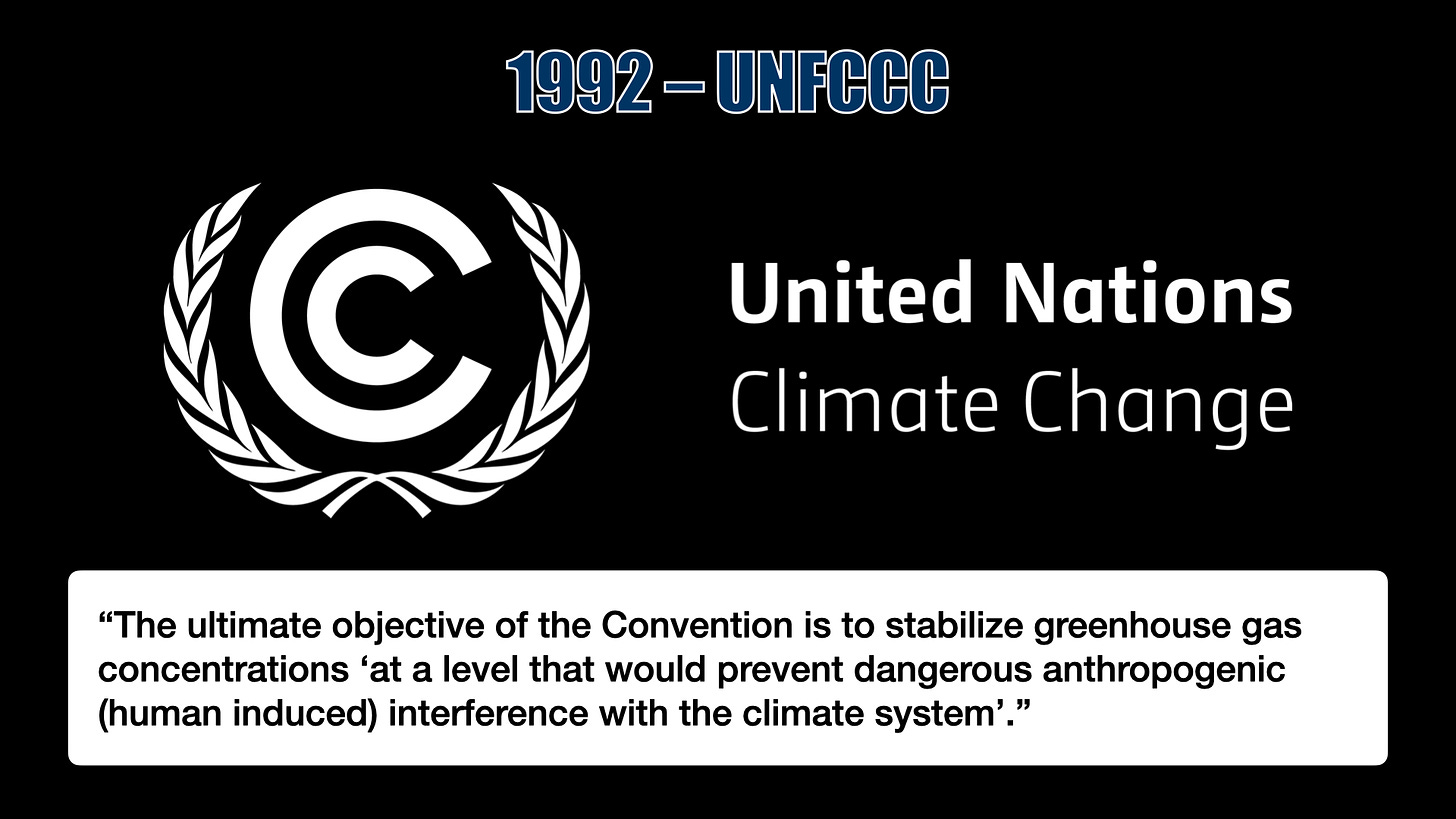
At the summit the United Nations Framework Convention on Climate Change was signed by 154 states and came into effect in 1994. It has been followed by an endless number of climate summits. The ultimate objective of the Convention is to stabilize greenhouse gas concentrations “at a level that would prevent dangerous anthropogenic (human induced) interference with the climate system.”
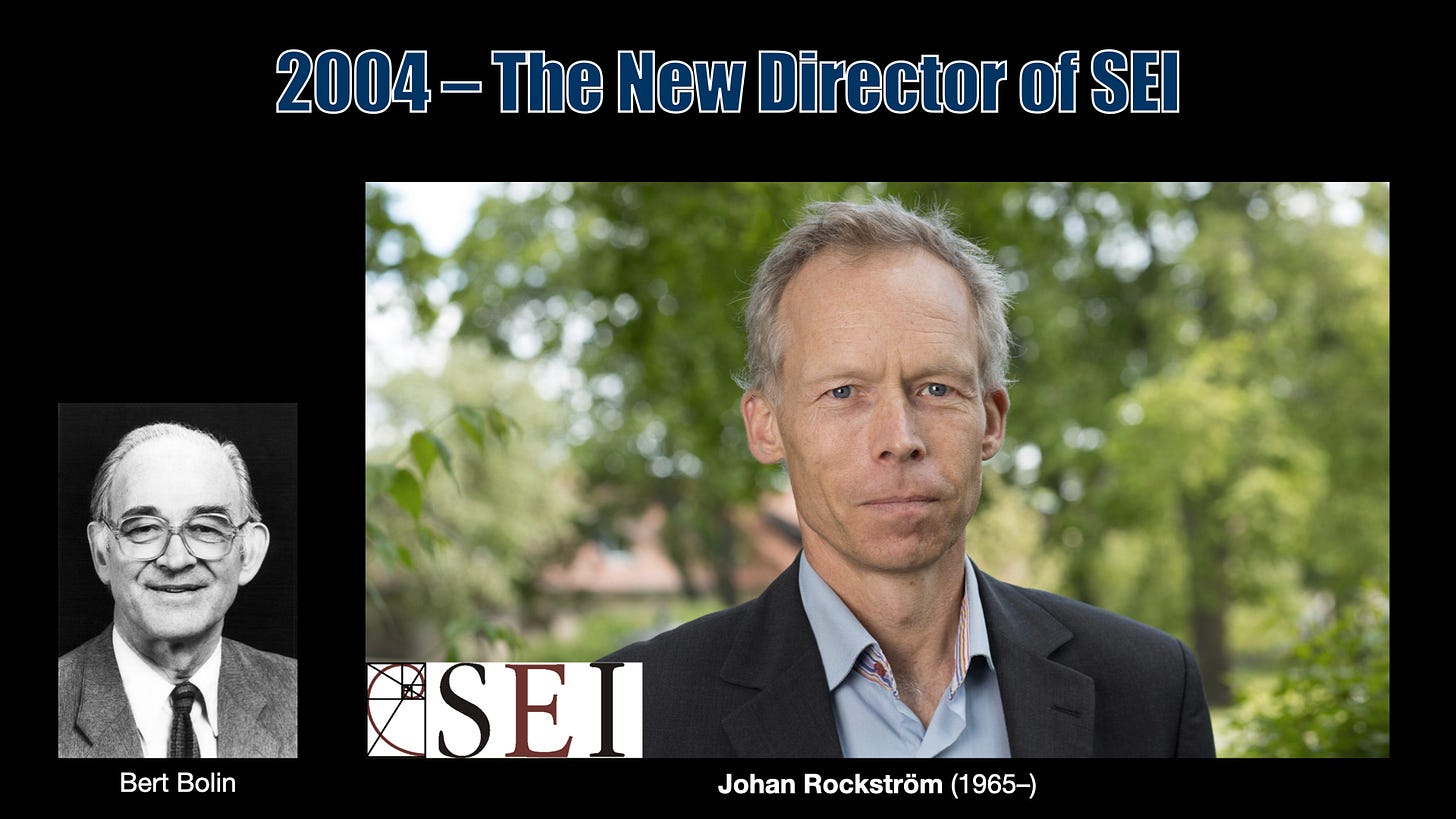
In 2003, Bert Bolin asked agronomist Johan Rockström to take over the position as director of Stockholm Environment Institute. Rockström had been recommended by his former colleague Carl Folke at The Beijer Institute. He accepted and assumed as director in 2004. A new chapter had begun with Rockström at the steering wheel.
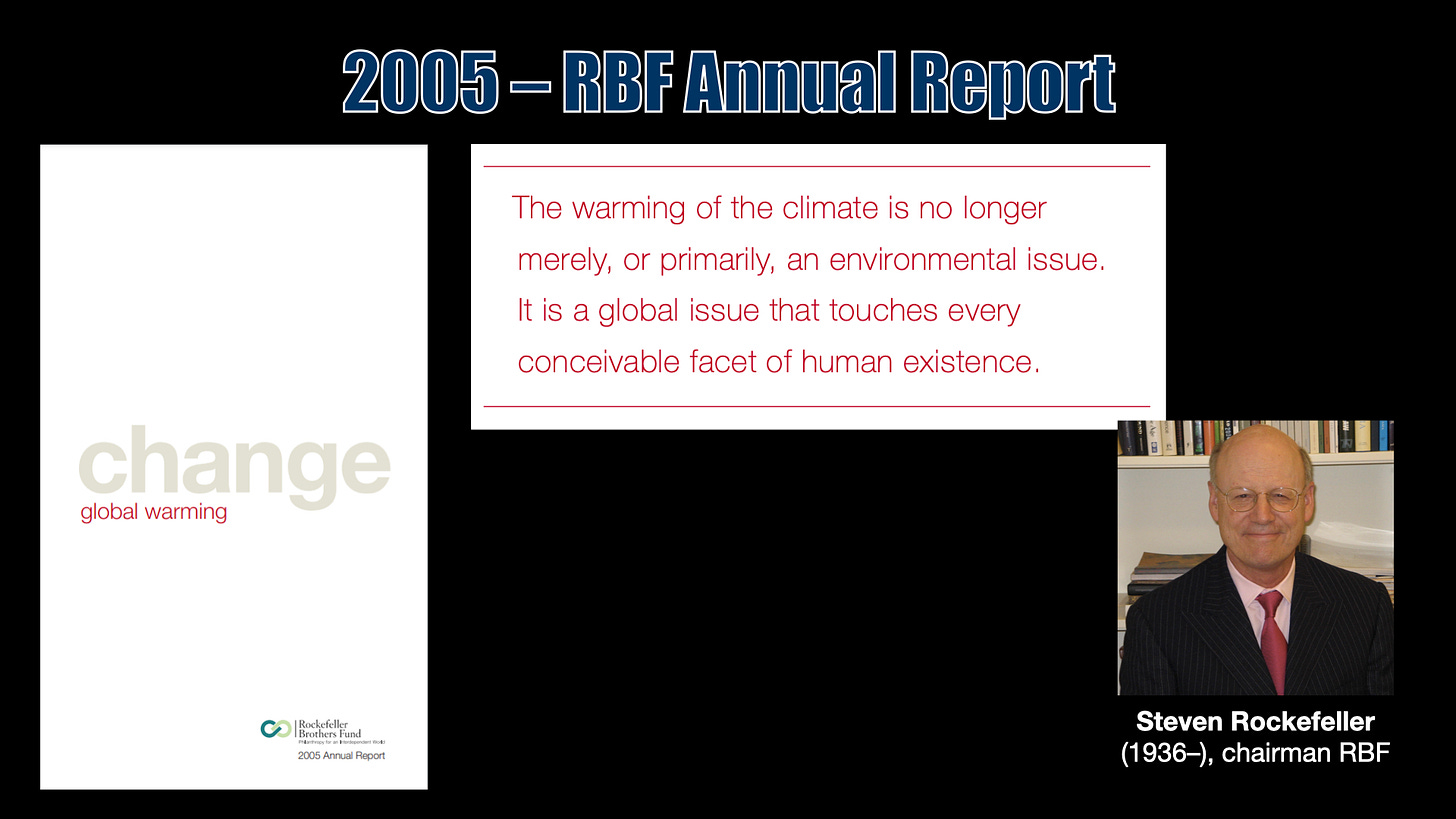
Rockefeller Brothers Fund made climate change their overarching issue and proclaimed: “The warming of the climate is no longer merely, or primarily, an environmental issue. It is an energy issue; a business issue; an investor issue; a moral issue; a security issue; an agricultural issue; a coastal issue; a religious issue; an urban issue; in short, a global issue that touches every conceivable facet of human existence. It is a matter of universal concern that cuts across party lines, religious affiliations, class divisions, and demographic distinctions. Therein lies our current opportunity.”
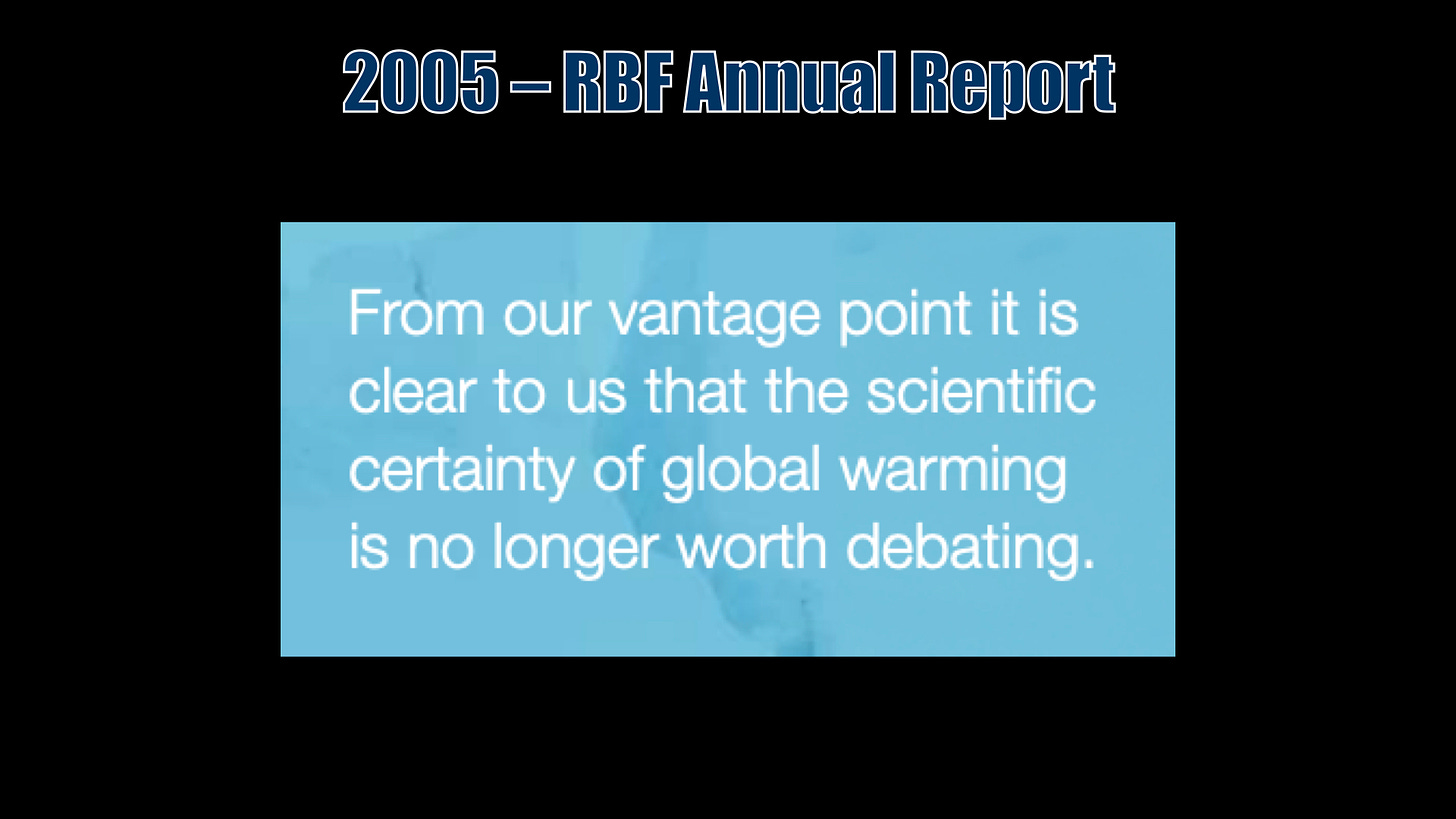
The debate was over.
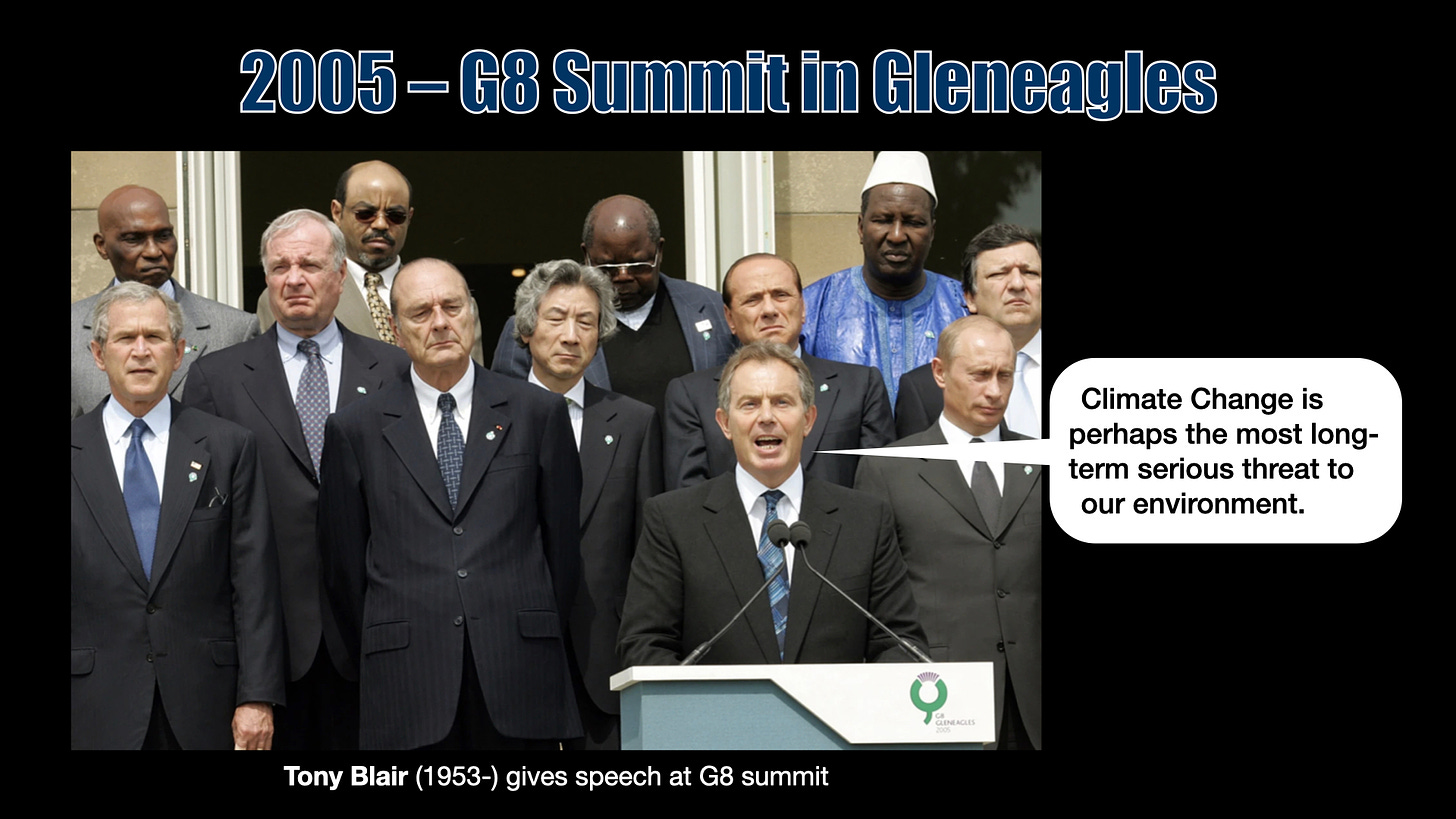
At the G8 Summit in Gleneagles in 2005 British Prime Minister Tony Blair declared that Climate Change was the most serious threat to the environment. Action was needed.
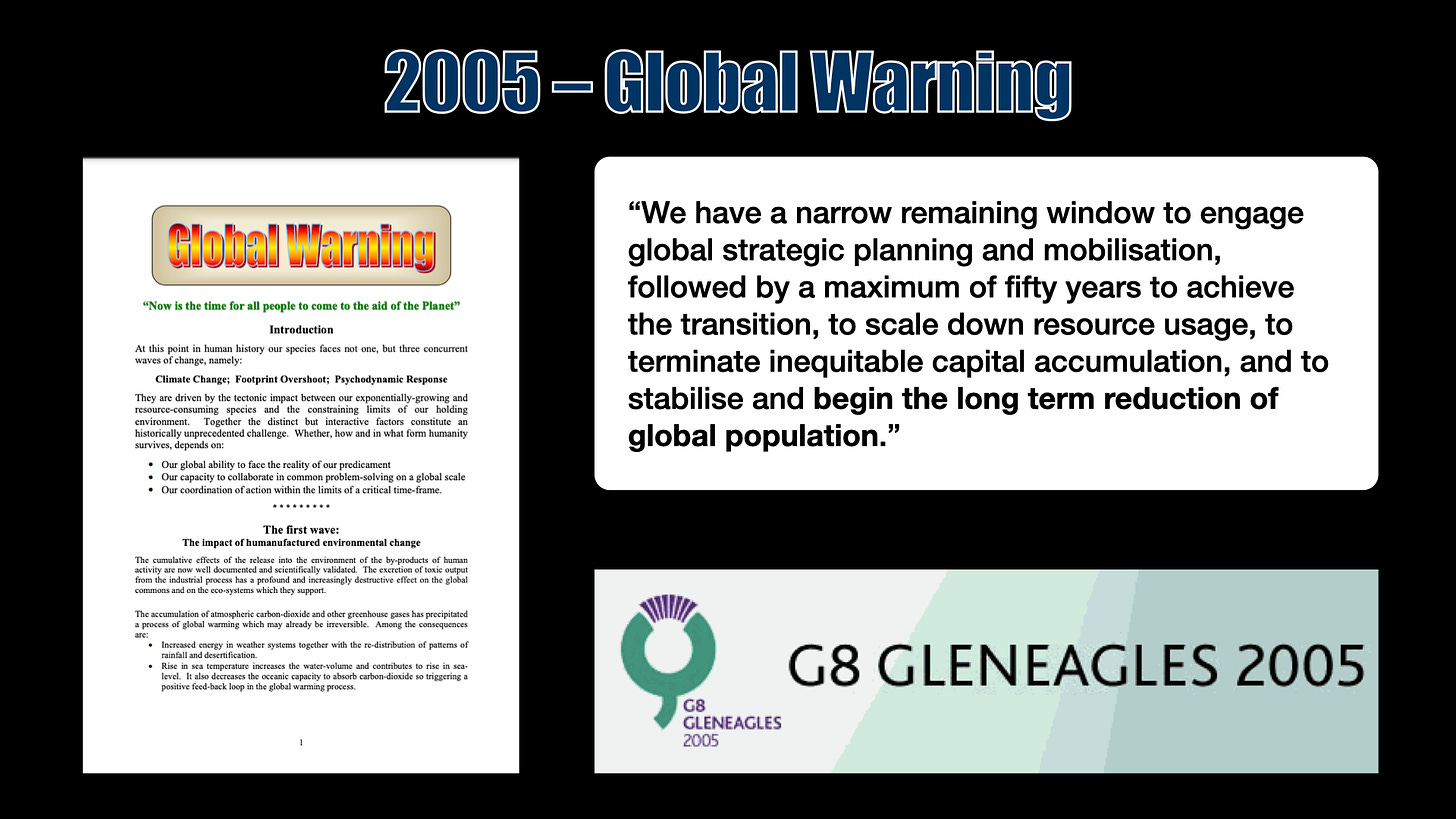
Before the meeting a position paper has been circulated among the participants with a urgent message: ”We have a narrow remaining window to engage global strategic planning and mobilisation, followed by a maximum of fifty years to achieve the transition, to scale down resource usage, to terminate inequitable capital accumulation, and to stabilise and begin the long term reduction of global population.”
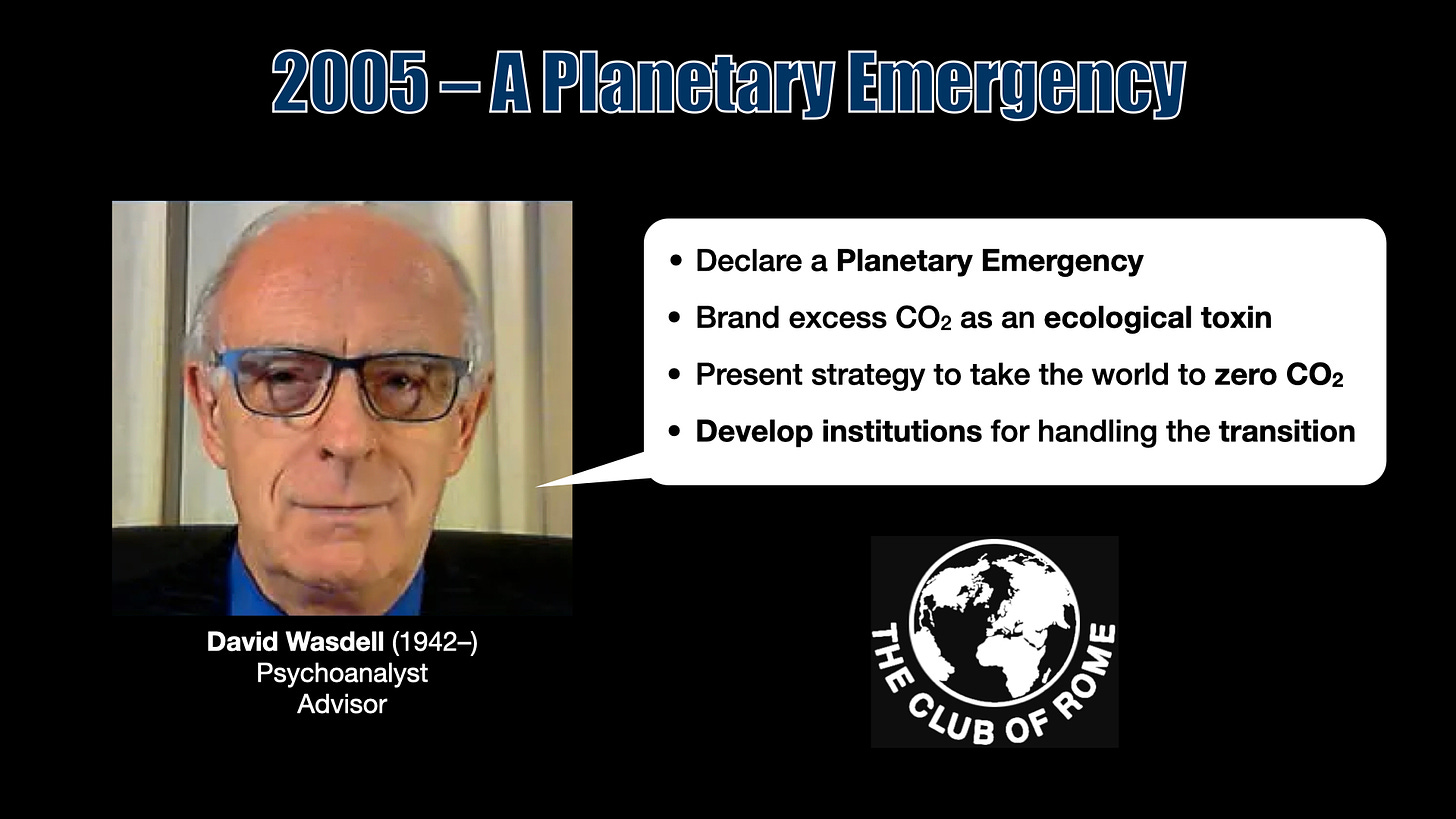
Author was the British government advisor and psychoanalyst David Wasdell. Trained at Tavistock. At the annual meeting of the Club of Rome in the autumn of 2005 he advised them to: Declare a Planetary Emergency, Branding excess CO2 as an eco-toxin, Present strategy to take the world to zero CO2 and Develop institutions for handling the transition. Earth Stewardship was needed.
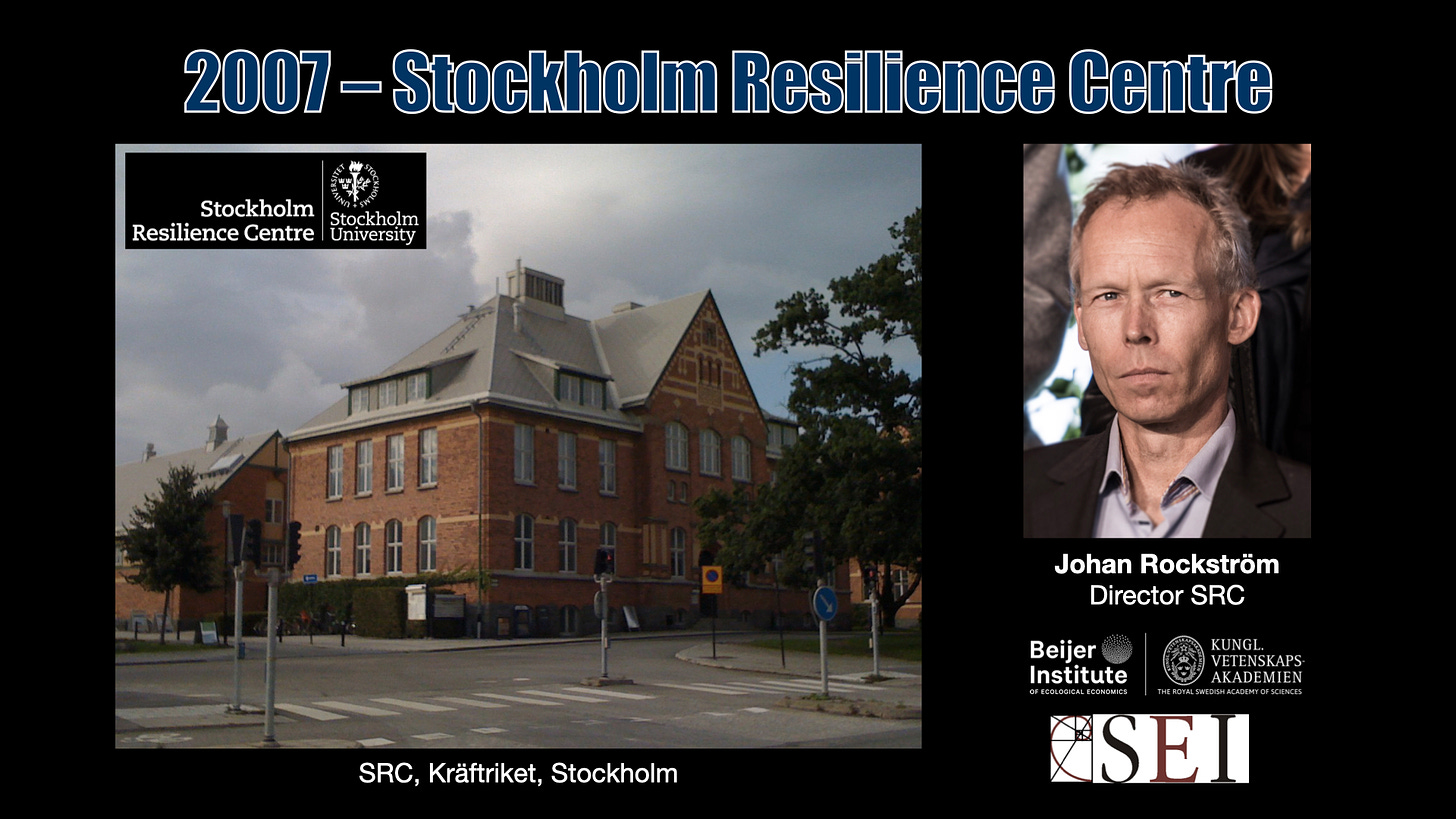
The following year The Swedish foundation for strategic environmental research (MISTRA), together with the Beijer Institute and Stockholm Environment Institute, launched the Stockholm Resilience Centre with the mission ”advance the scientific understanding of the complex, dynamic interactions of people and nature in the biosphere”. Johan Rockström was chosen as director.
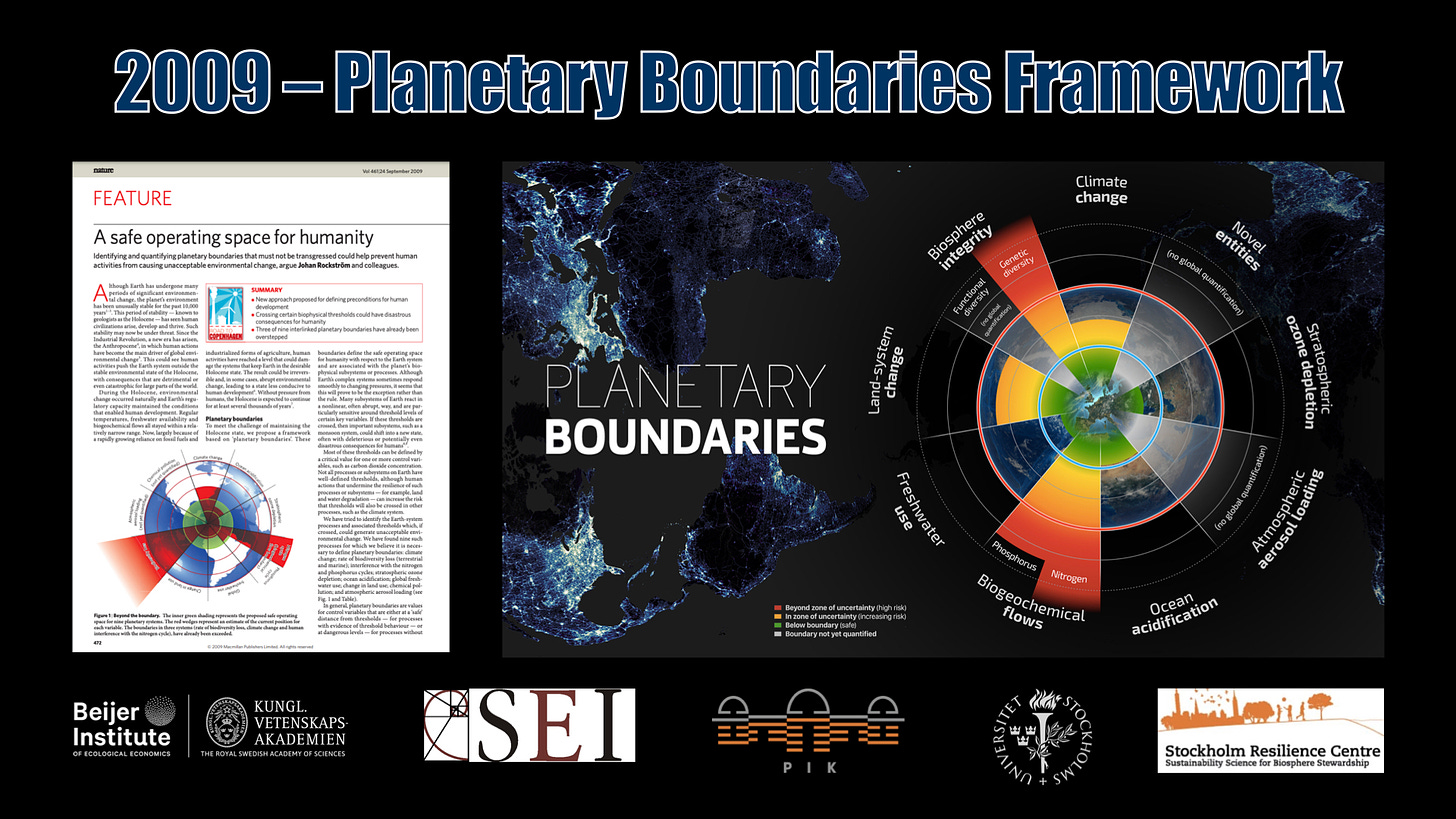
Three years later. In September 2009, Johan Rockström and a team of scientists presents the Planetary Boundaries Framework in Nature. This defines nine boundaries for human activities that will trigger dangerous tipping points if over-stepped.
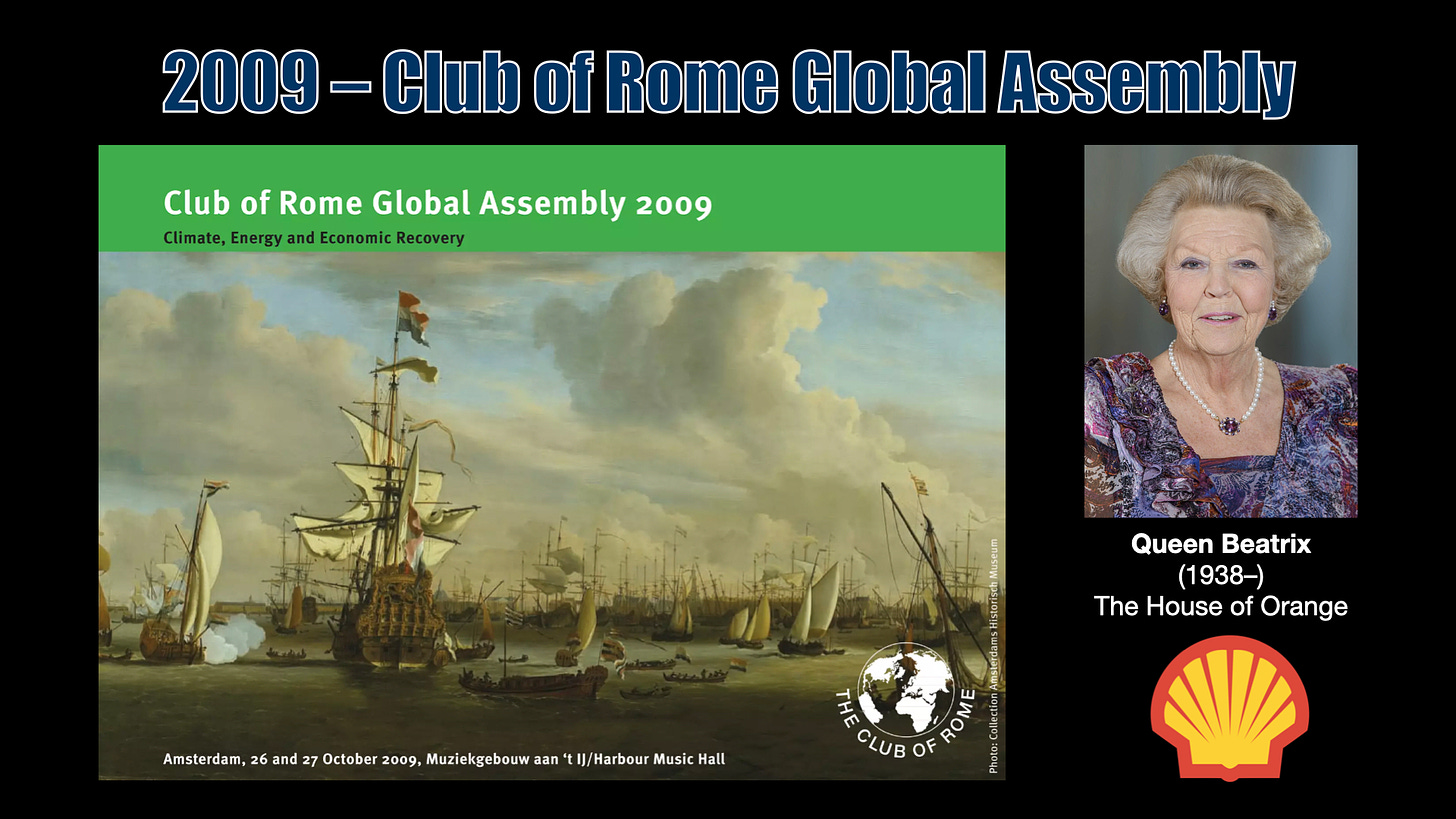
The framework is presented at the Club of Rome’s Global Assembly in October 2009 with attendance from the patron Queen Beatrix of the Netherlands and Michael Gorbachev.
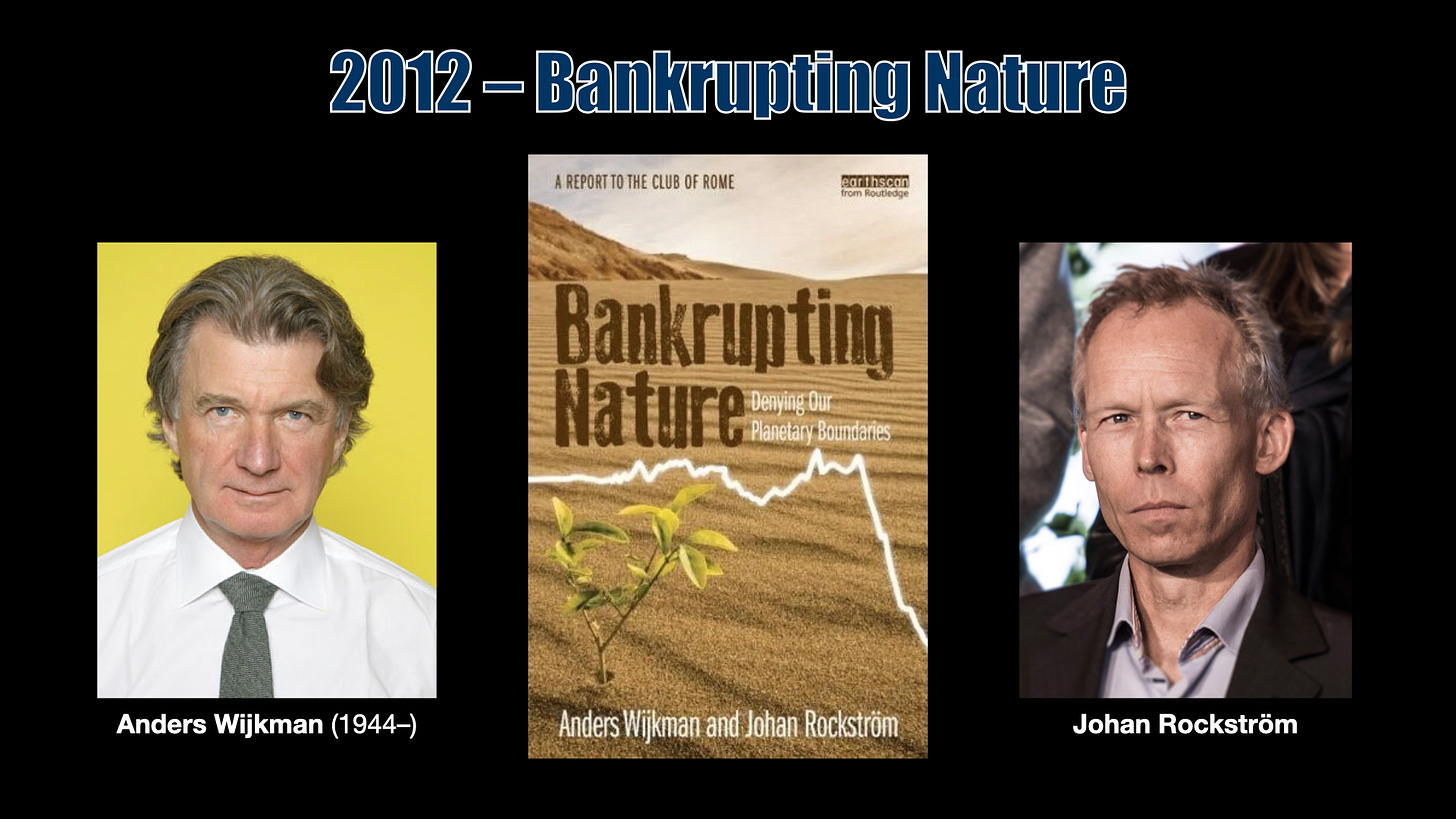
They are also included in Johan Rockström’s and the then President of Club of Rome Anders Wijkman’s book Bankrupting Nature: Denying our Planetary Boundaries. The message starts to spread within the scientific community.
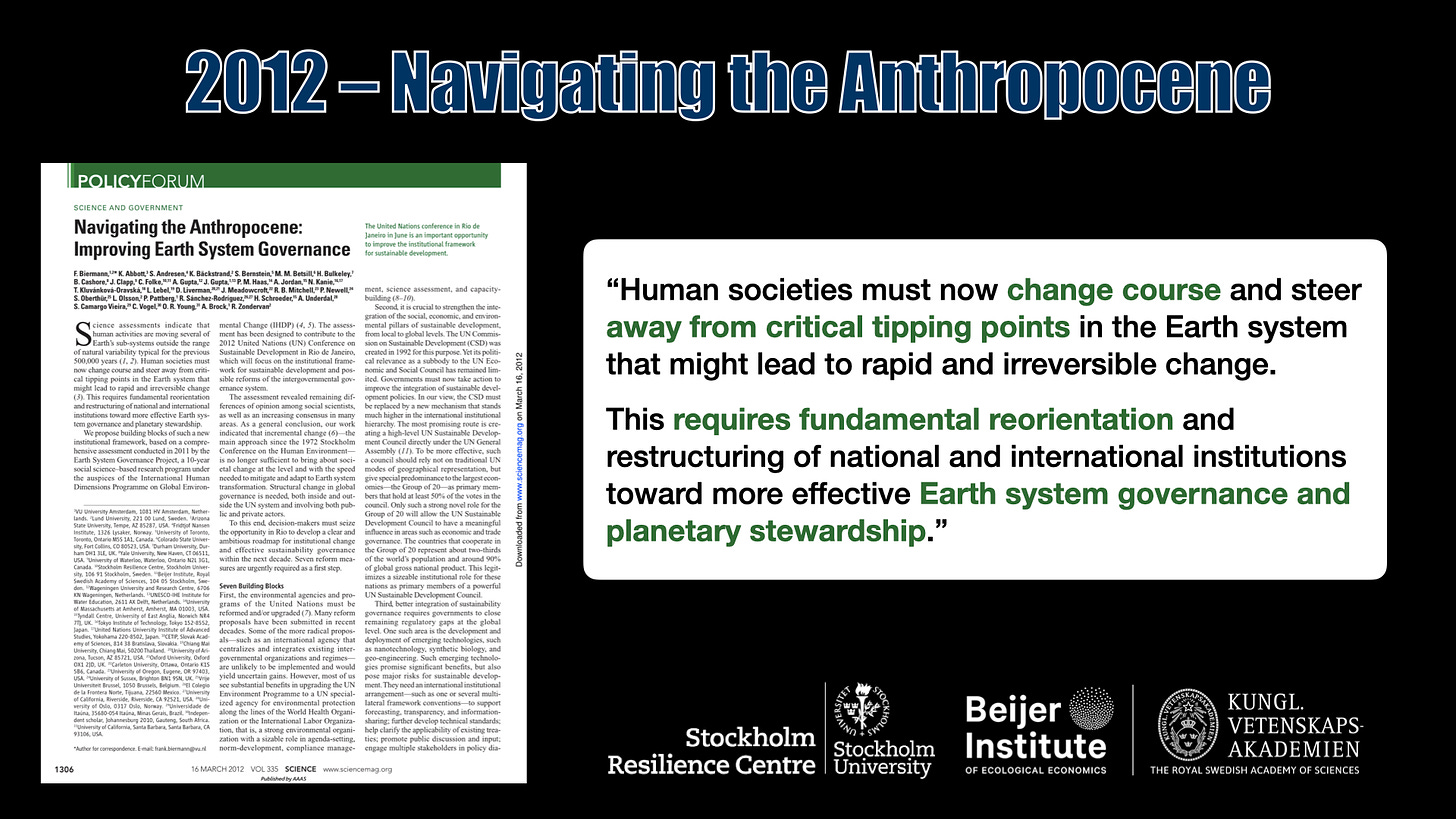
In order to safeguard the planet, 32 scientists demands that: “Human societies must now change course and steer away from critical tipping points in the Earth system that might lead to rapid and irreversible change. This requires fundamental reorientation and restructuring of national and international institutions toward more effective Earth system governance and planetary stewardship.” The article was published in Science.
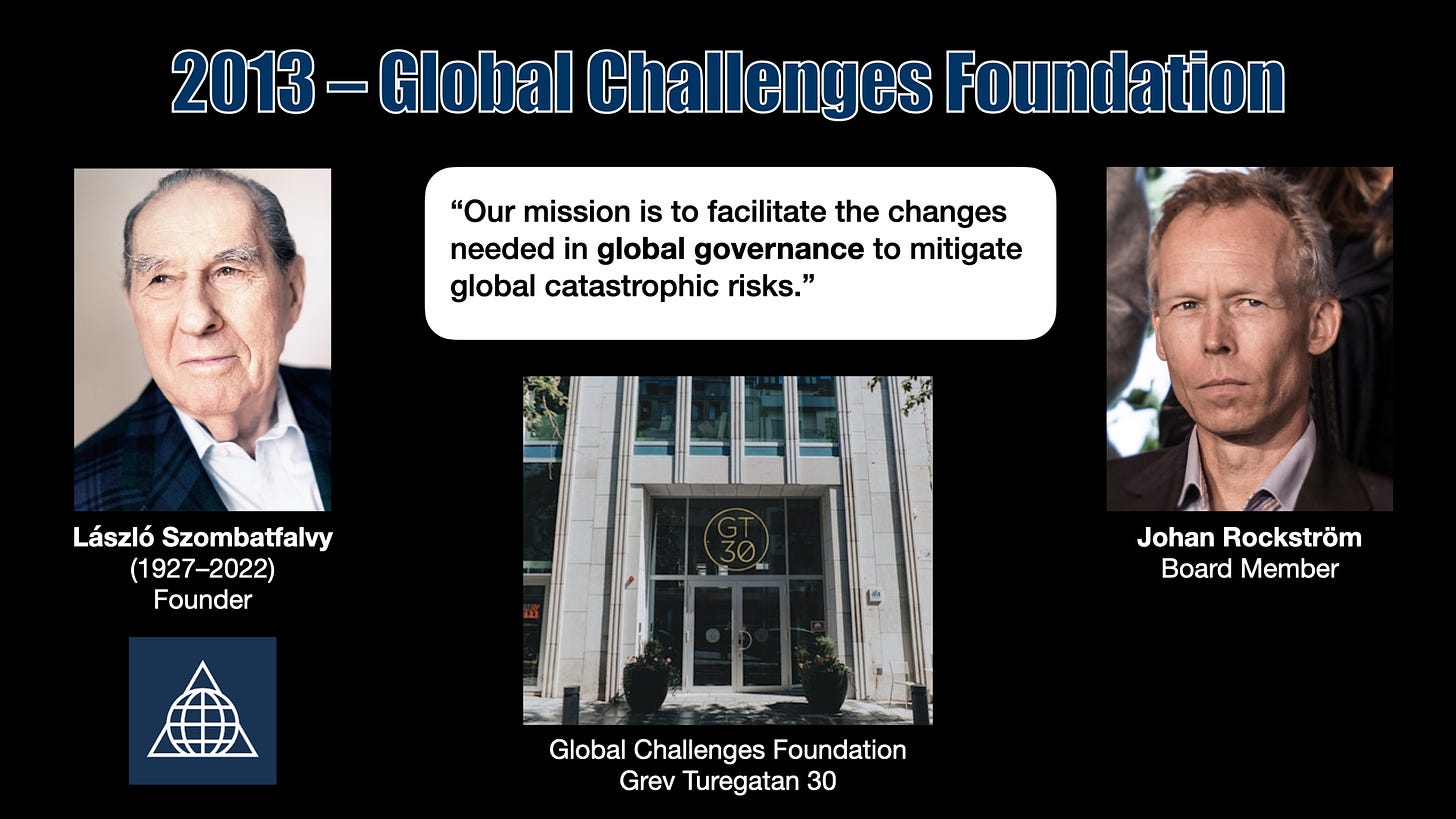
Shortly thereafter, the Stockholm based Global Challenges Foundation is being set up to achieve this. Founded by billionaire and financier László Szombatfalvy,with Johan Rockström on the board of trustees, it has the mission to facilitate the changes needed in global governance to mitigate global catastrophic risks. Swedish social democrat politician Margot Wallström becomes a spokesperson.
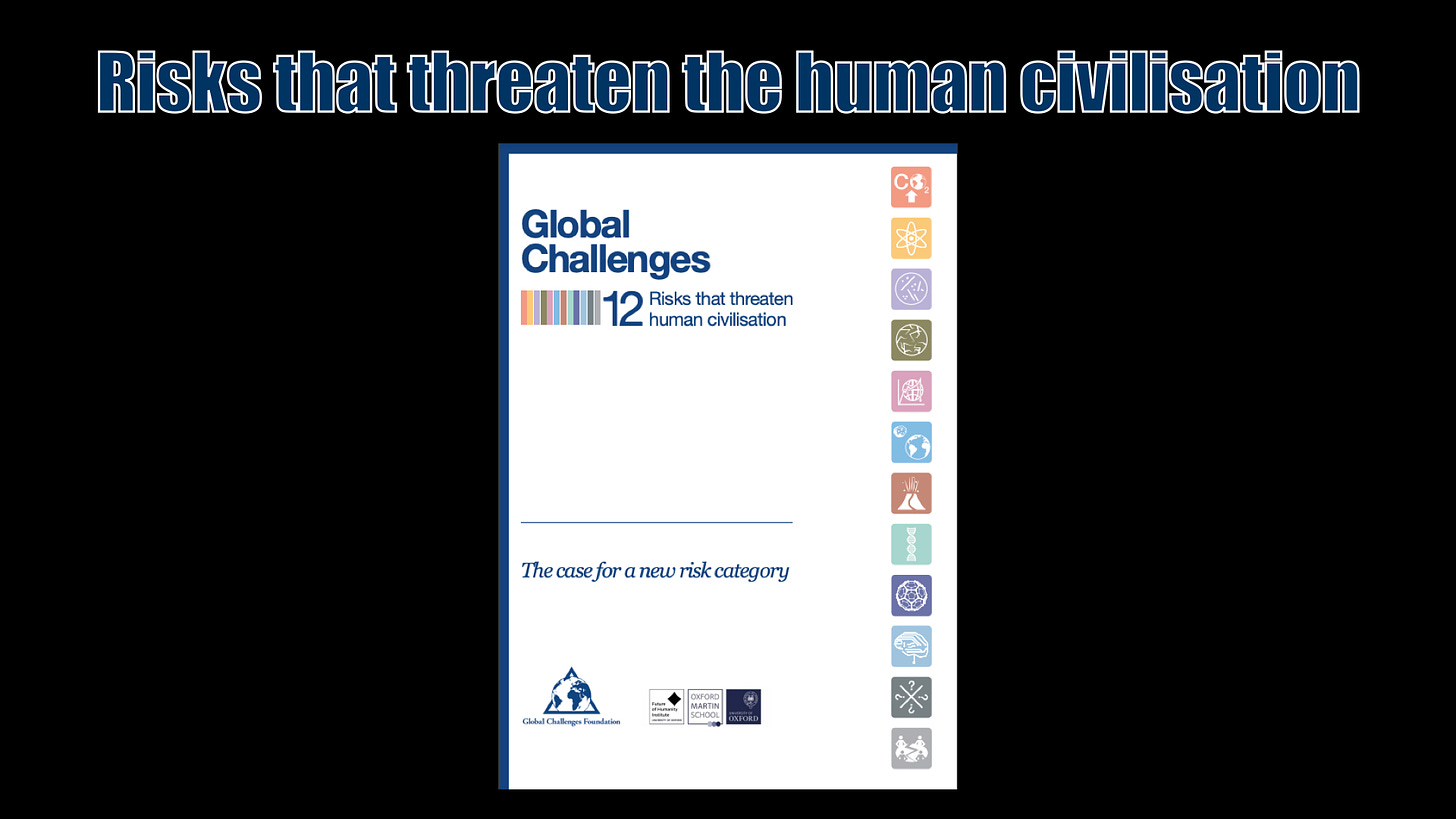
They start by releasing a report about global catastrophic risks that threatens the human civilisation as well as ”promote the creation of networks, collaborations and initiatives aimed at developing governance solutions and moving the conversation forward.”
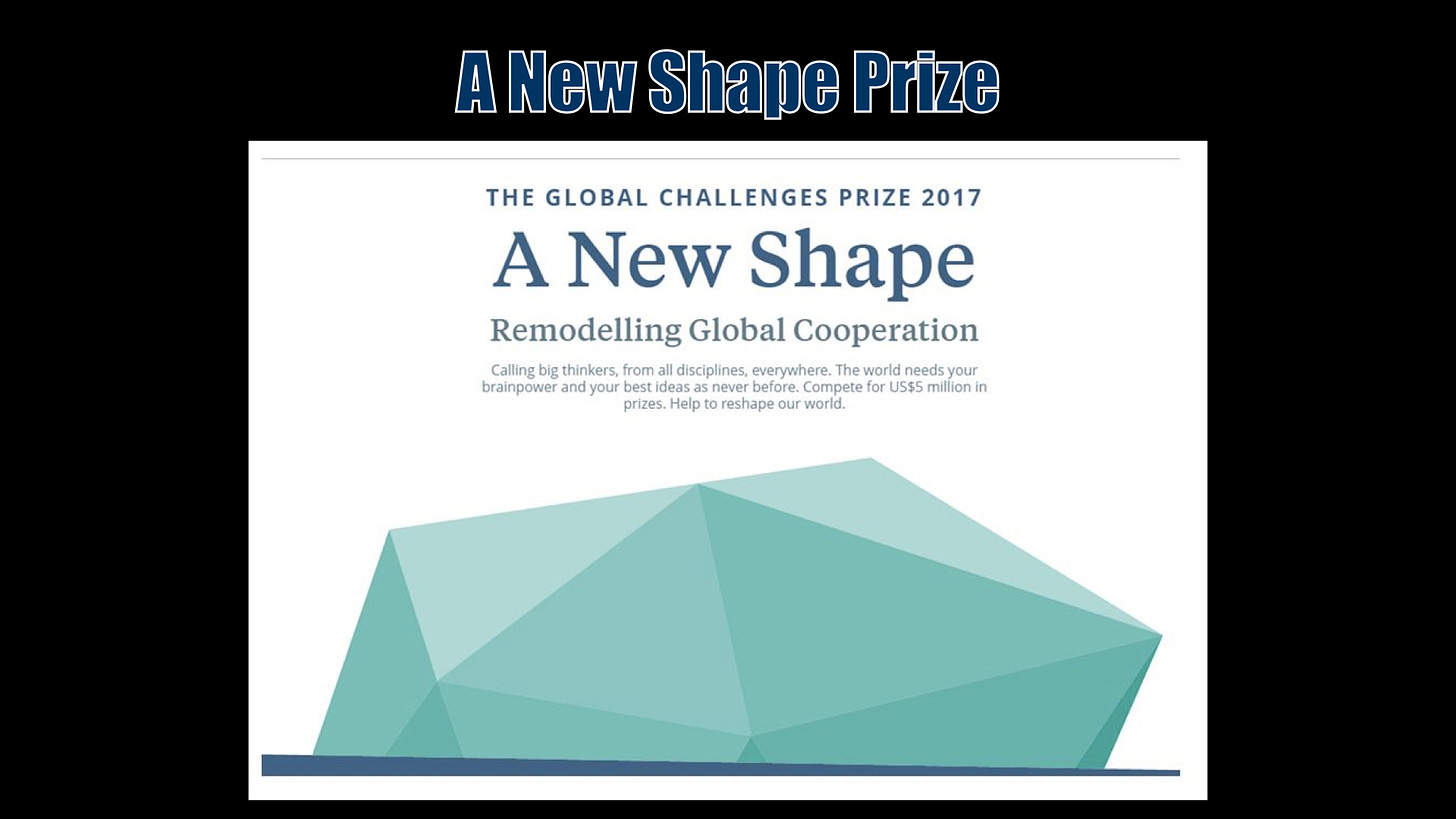
For this aim they also announce a $5 million dollar award for anyone who can successfully create a “UN 2.0.”
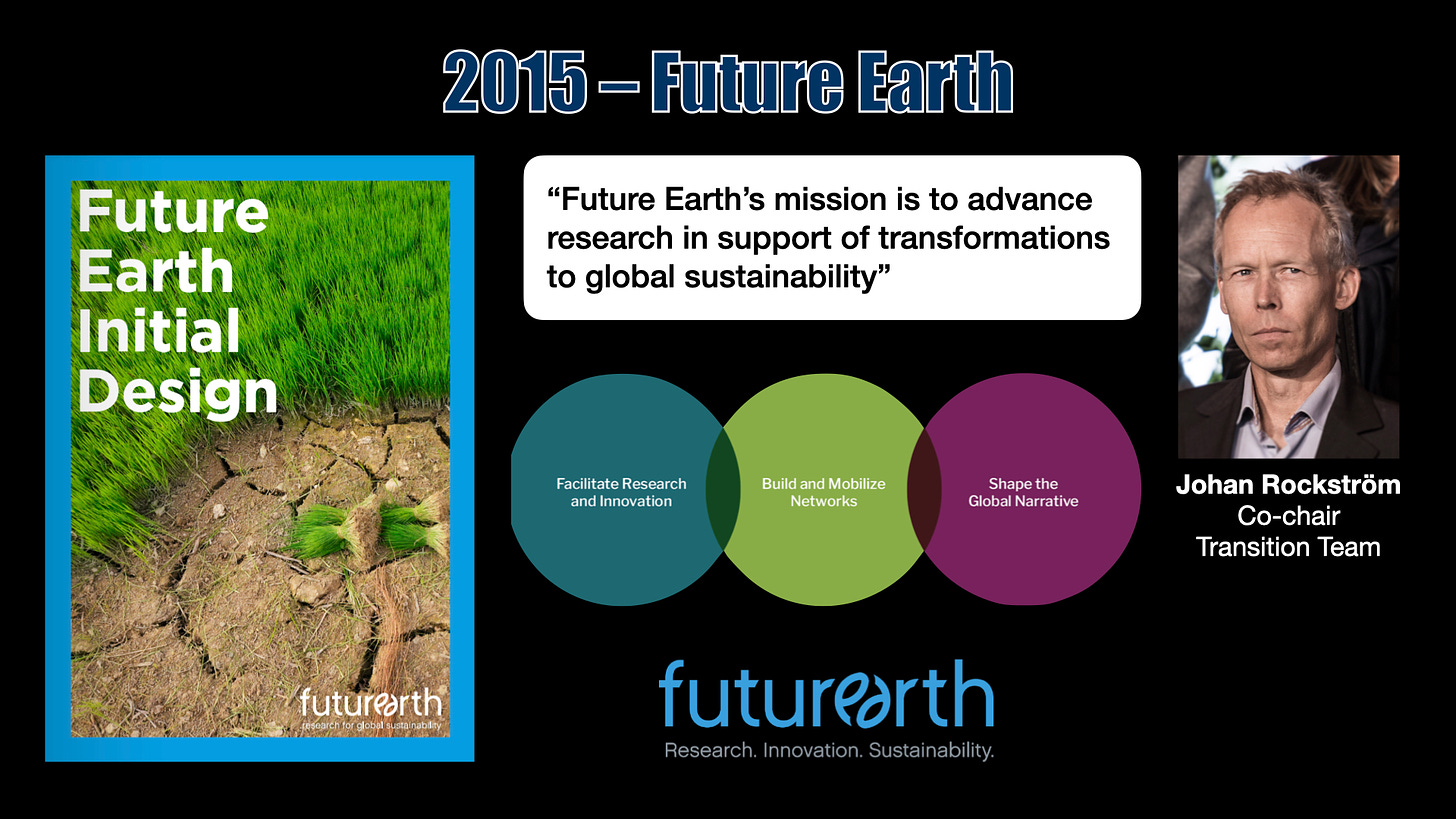
Johan Rockström continues his work with defining the aims of the global research program Future Earth that had been set up after the UN Conference on Sustainable Development in 2012 to advance research in support of transformations to global sustainability. Future Earth will become an important hub in the new global governance architecture.
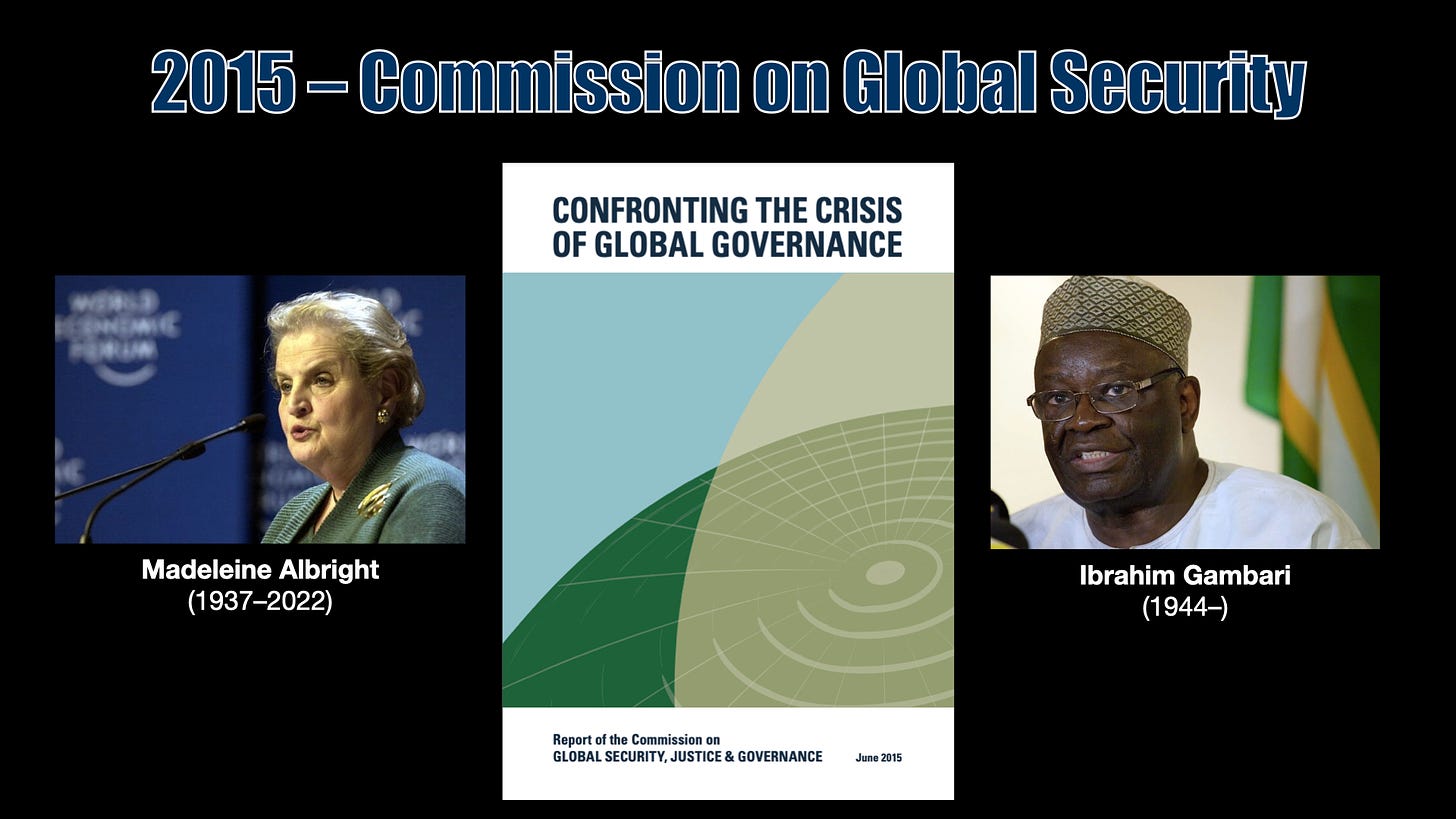
In June 2015, the Commission on Global Security, Justice and Governance release their report Confronting the Crisis of Global Governance. The commission is headed by former US Secretary of State Madeleine Albright and former Nigerian Diplomat Ibrahim Gambari and presents recommendations on how ”to better respond to 21st century threats, challenges, and opportunities”. They seek ”to encourage a broad-based global policy dialogue and an institutional reform agenda aimed at 2020.”
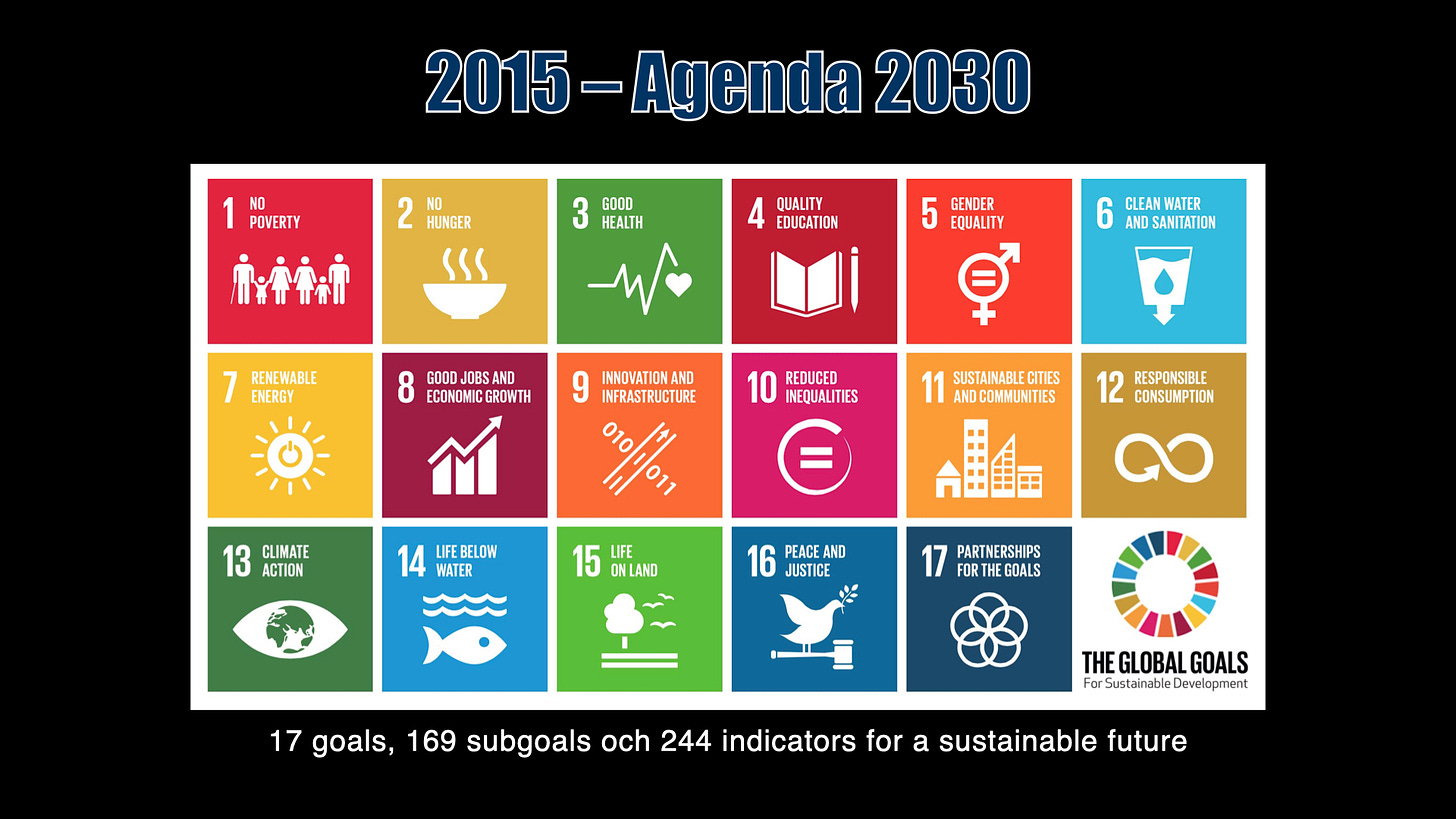
A few months later the United Nations Agenda 2030 with its 17 Global Goals for Sustainable Development is adopted by the UN member states.
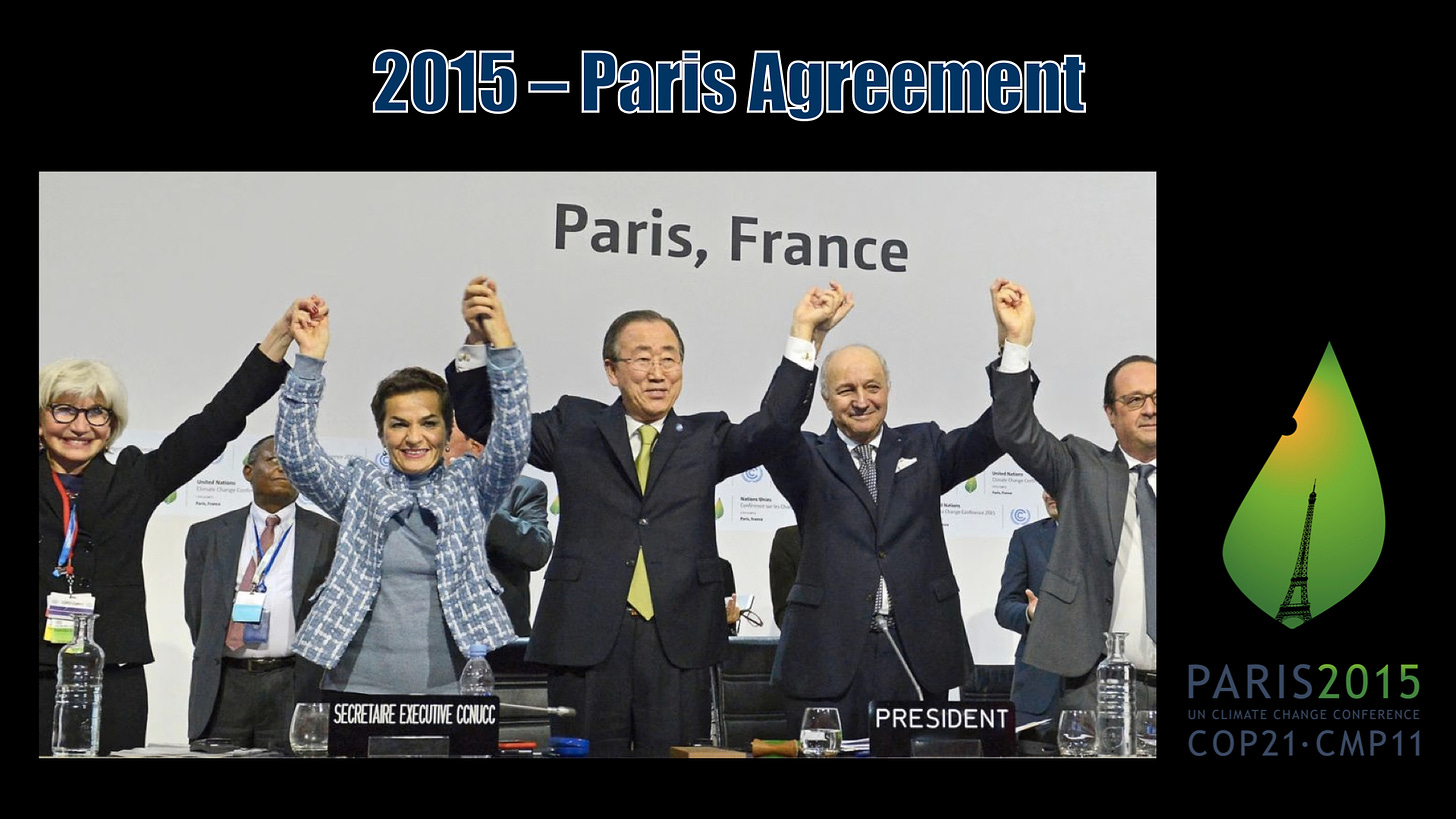
It is followed by signing of the Paris Agreement during the 21st UN climate meeting in Paris in December 2015.

This means that it is an urgent need with global institutional changes. In 2016 Johan Rockström and IIASA director Nebojsa Nakicenovic states that: ”We must now find new institutions, new governance arrangements and, as Mary Robinson, former president of Ireland and UN Ambassador says, “new Guardian Angels” for the Global Commons in the Anthropocene.”
At the World Economic Forum annual meeting in Davos in 2018, Rockström is talking about how Global Challenges Foundations new prize can achieve this. ”The New Shape Prize is the first ever attempt to invite the whole world to come up with the best possible innovative ideas of how we can find a New World Order, a global governance pathway that will enable us to transition into a desired future there we avoid potentially global catastrophic risks, ranging from the risk of nuclear war, pandemics, inequality, all the down to climate system collapse.”
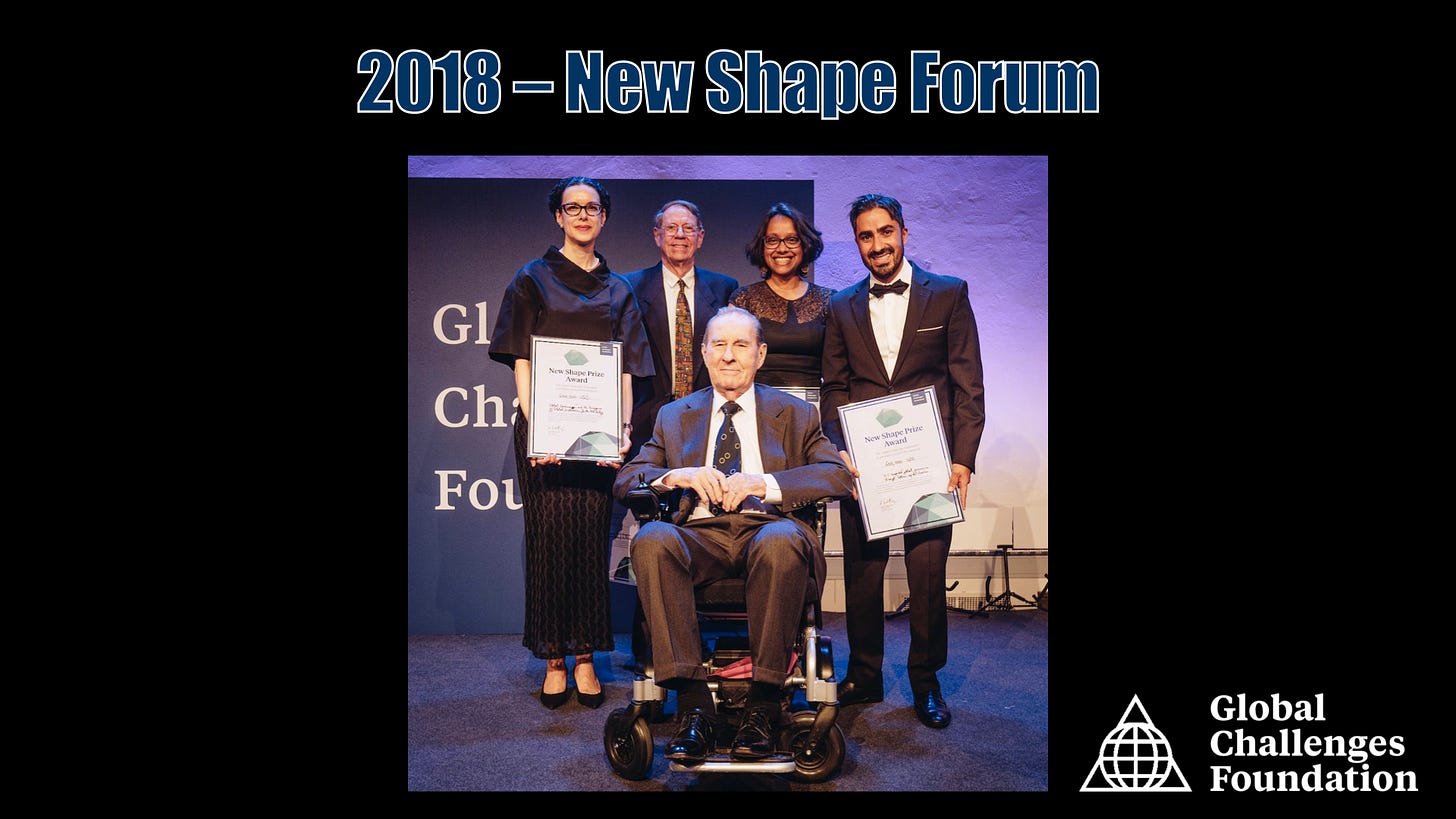
In May 2018 the New Shape Forum is held in Stockholm. Three winning proposals are chosen.
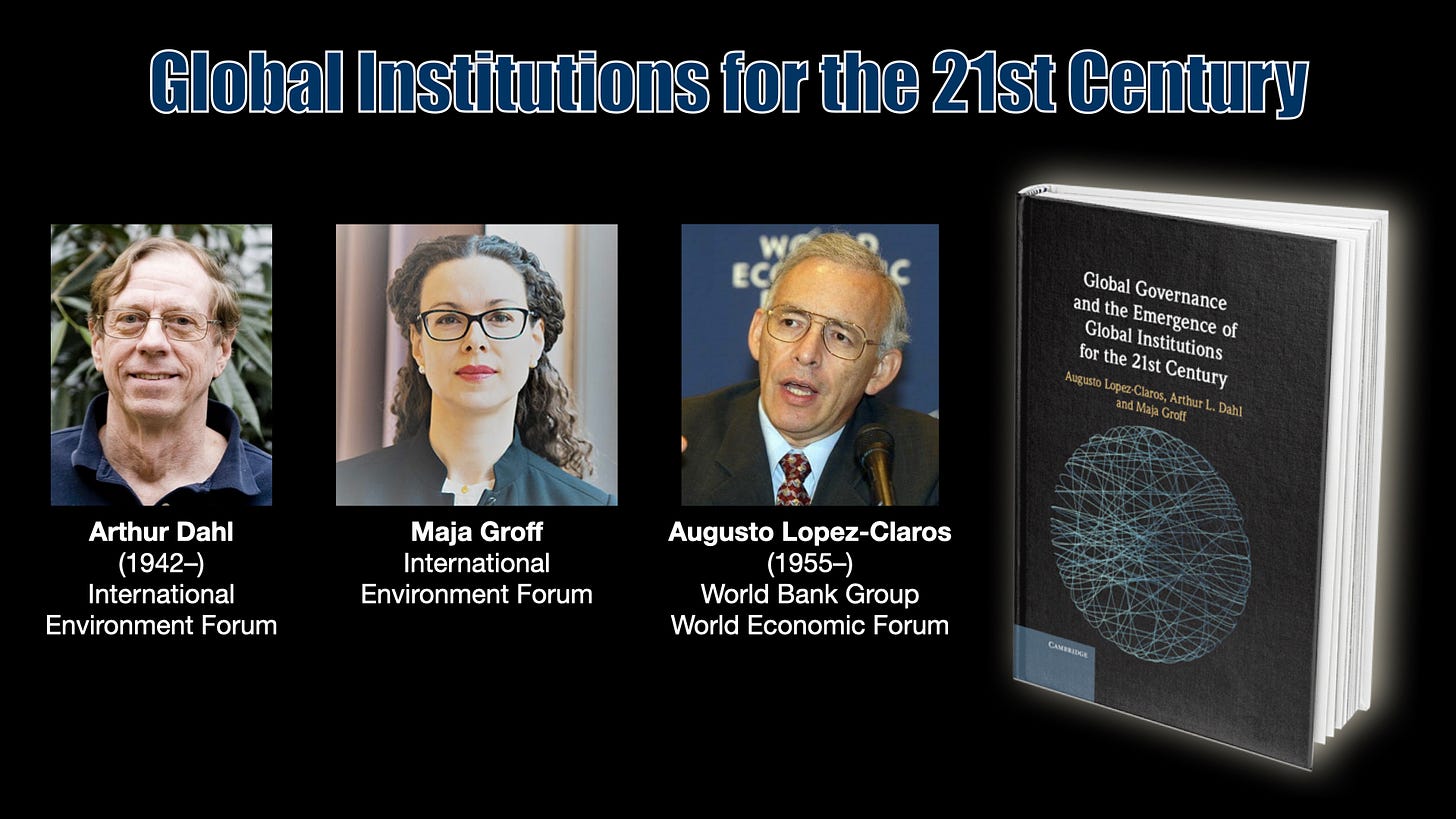
Among them are Global Governance and the Emergence of Global Institutions for the 21st Century by Arthur Dahl, Maja Groff and Augusto Lopez-Claros.

They are all followers of the Baháʼí Faith. The central theme of this religion is that humanity is one single race and that the day has come for its unification in one global society.
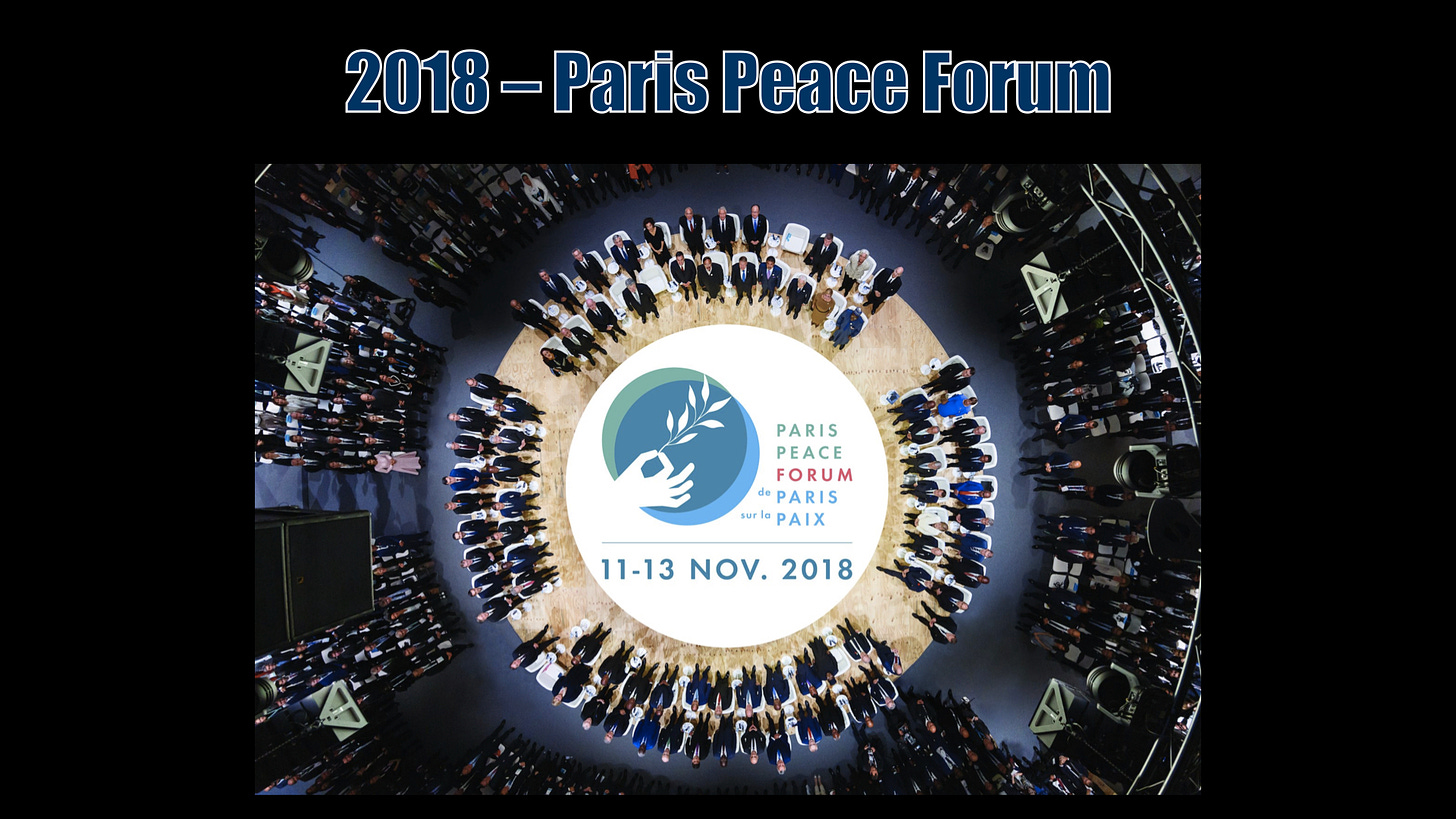
Their proposal is presented at the Paris Peace Forum in November 2018. A newly founded annual gathering with world leaders that focus on improving global governance.
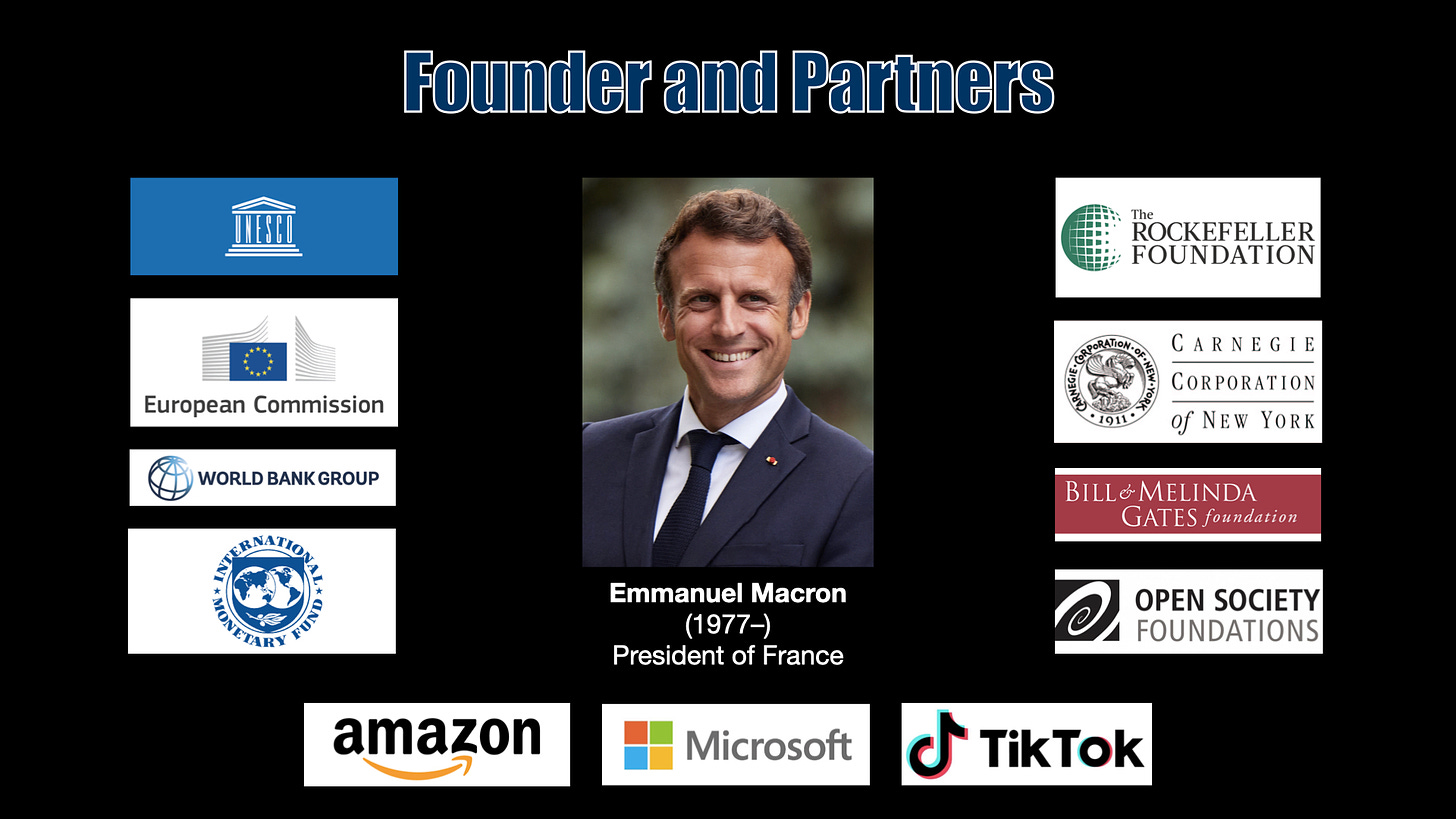
Paris Peace Forum was founded by Emmanuel Macron and is led by former OECD secretary-general Angel Gurria. Support comes from UNESCO, the European Commission, the World Bank, IMF, Rockefeller Foundation, Carnegie Corporation, Bill & Melinda Gates Foundation, Open Society and corporations like Microsoft, Amazon and TikTok.
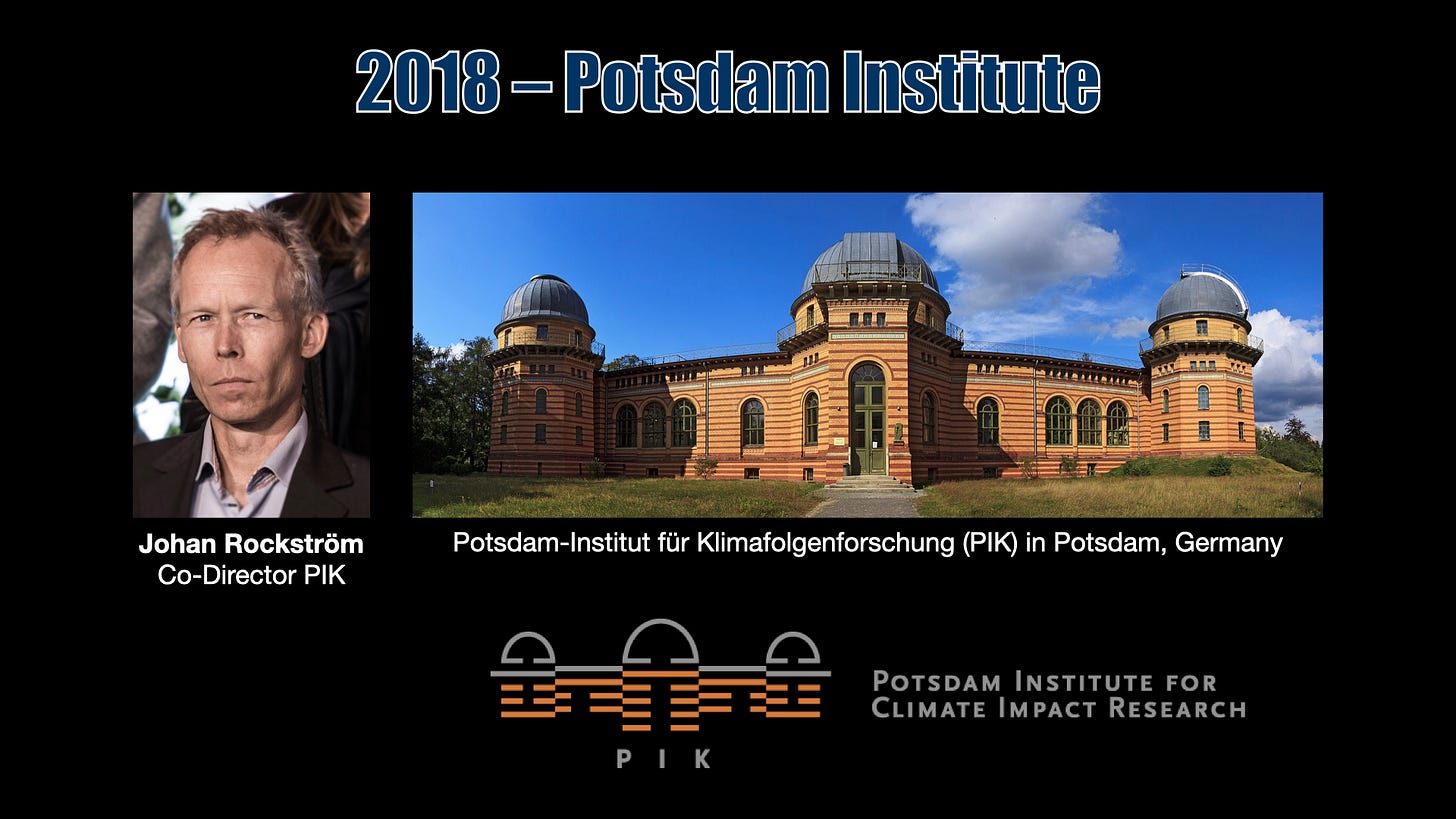
The stage was set and big changes were at the horizon. Johan Rockström assumed his new position as co-director of the Potsdam Institute for Climate Research in Germany in late 2018.
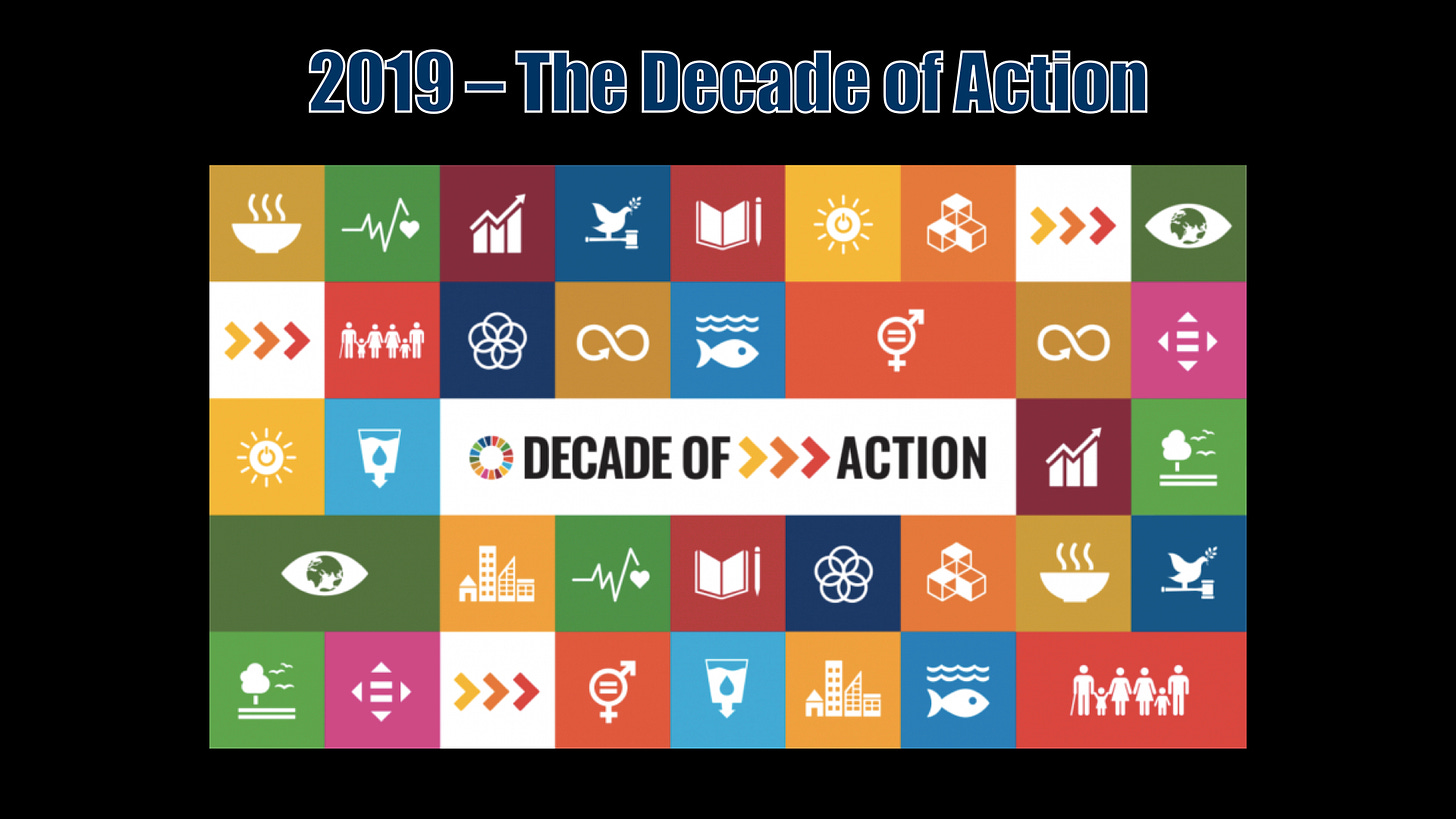
In September 2019 United Nations secretary-general calls for all sectors to mobilize for the Decade of Action.
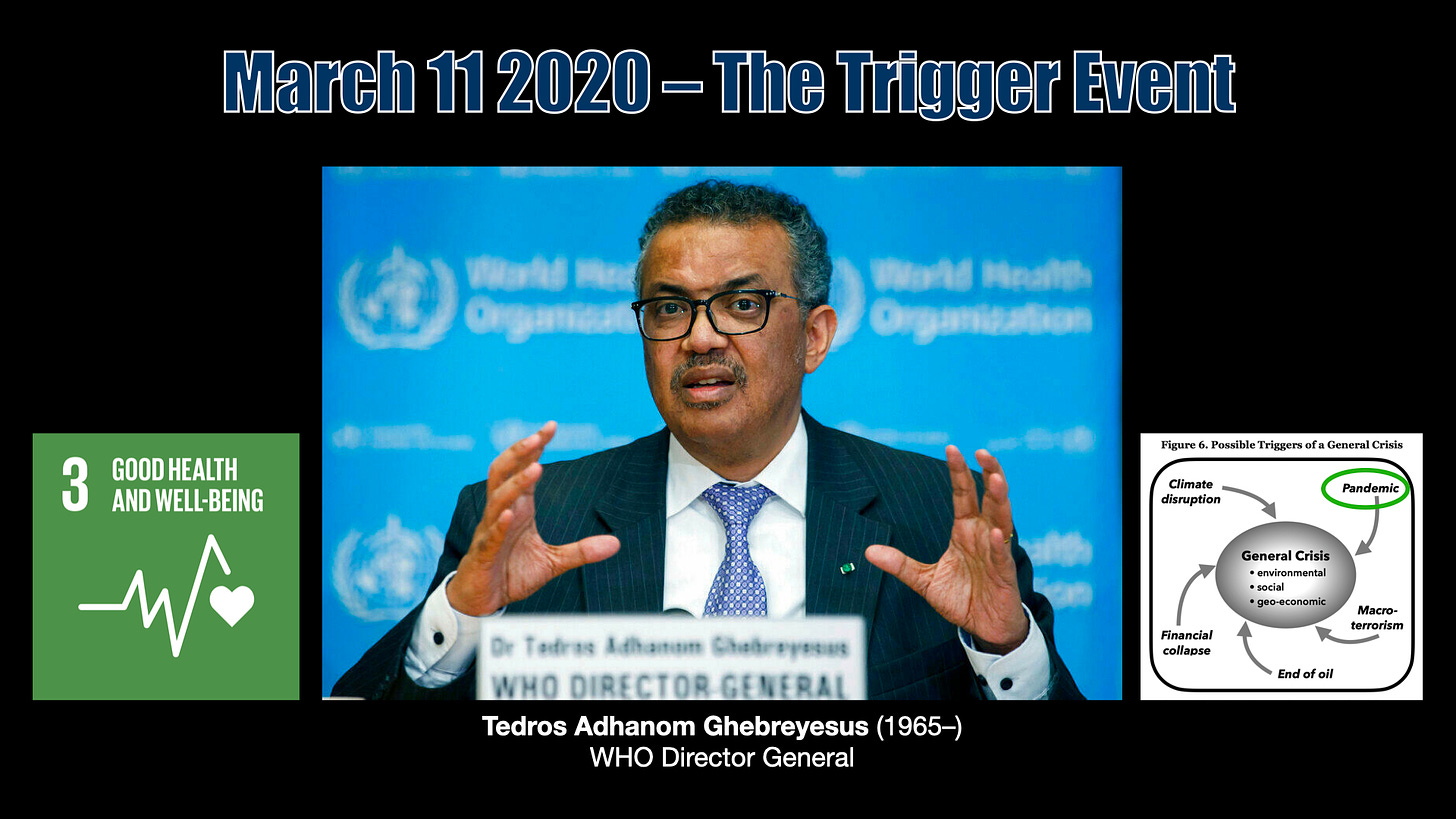
It is followed by a triggering event that had been prophesied by Paul Raskin’s The Great Transition Initiative. On March 11 2020, WHO declares a Global Health Emergency.
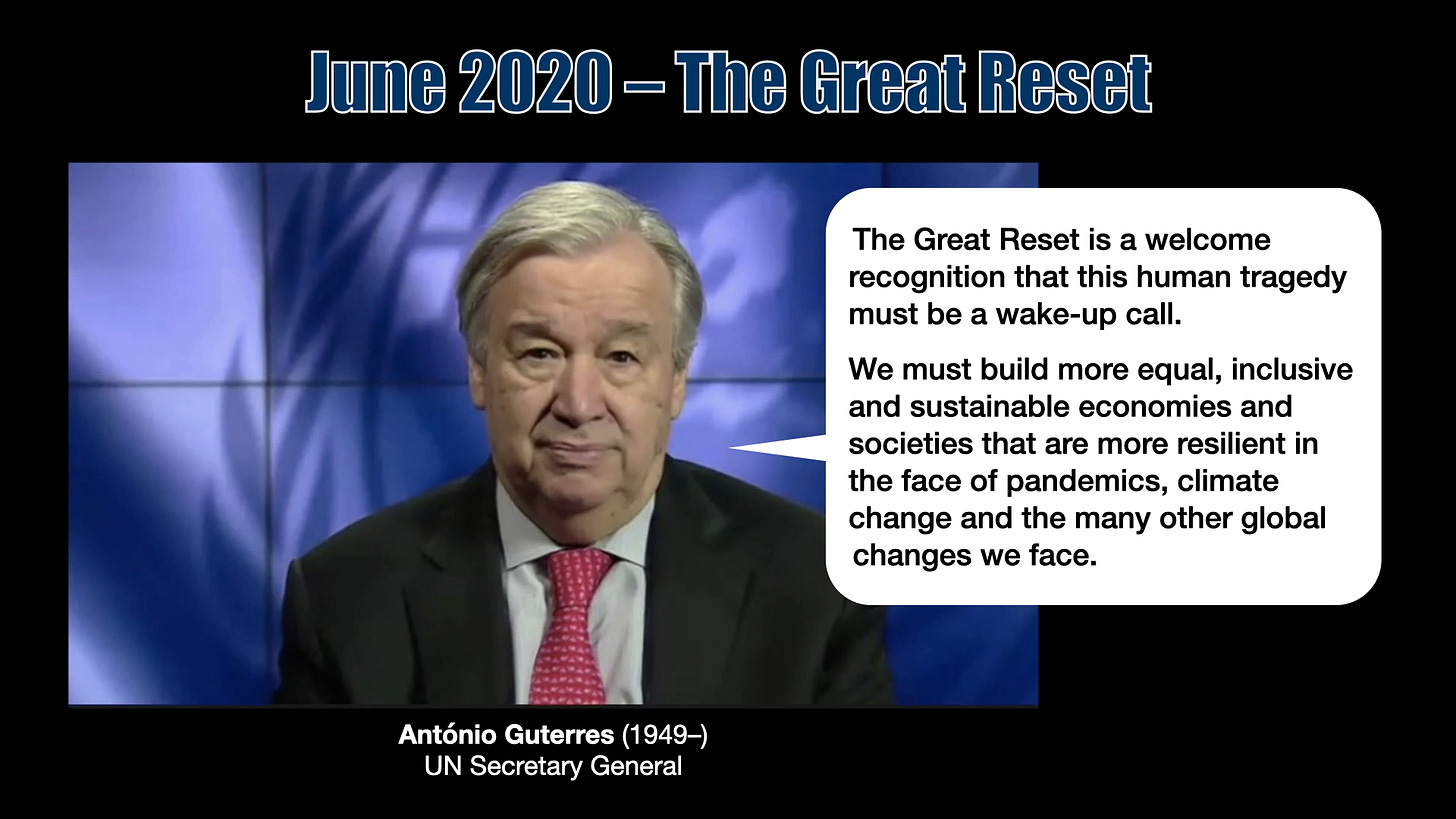
Three months later The Great Reset is declared by UN Secretary General Antonio Guterres: “The Great Reset is a welcome recognition that this human tragedy must be a wake-up call. We must build more equal, inclusive and sustainable economies and societies that are more resilient in the face of pandemics, climate change and the many other global changes we face.” It is a voice of a puppet.
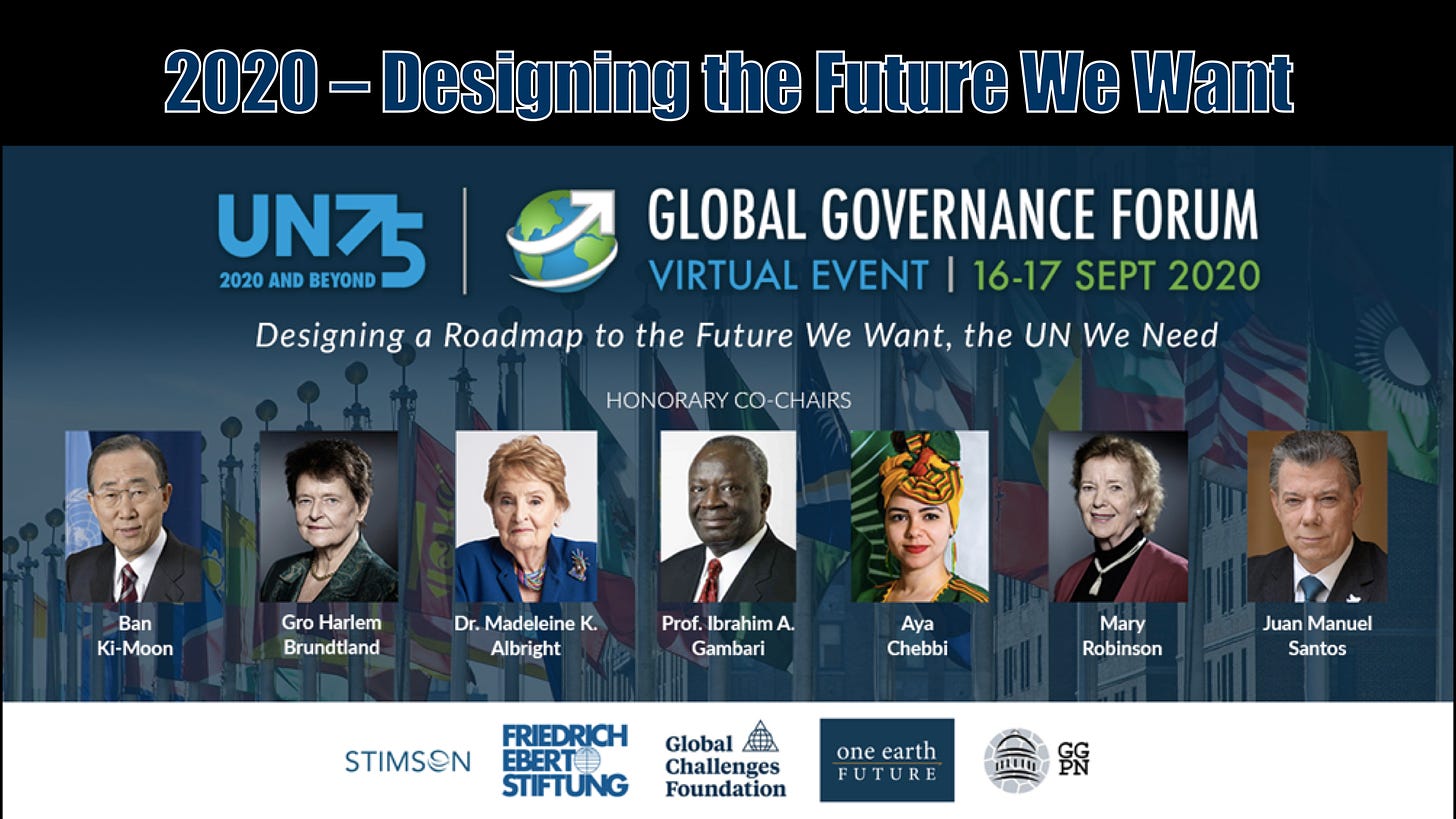
In September 2020, an answer to The Great Reset is declared by the United Nations at the Global Governance Forum with the slogan “Designing a Roadmap to the Future We Want, the UN We Need”.
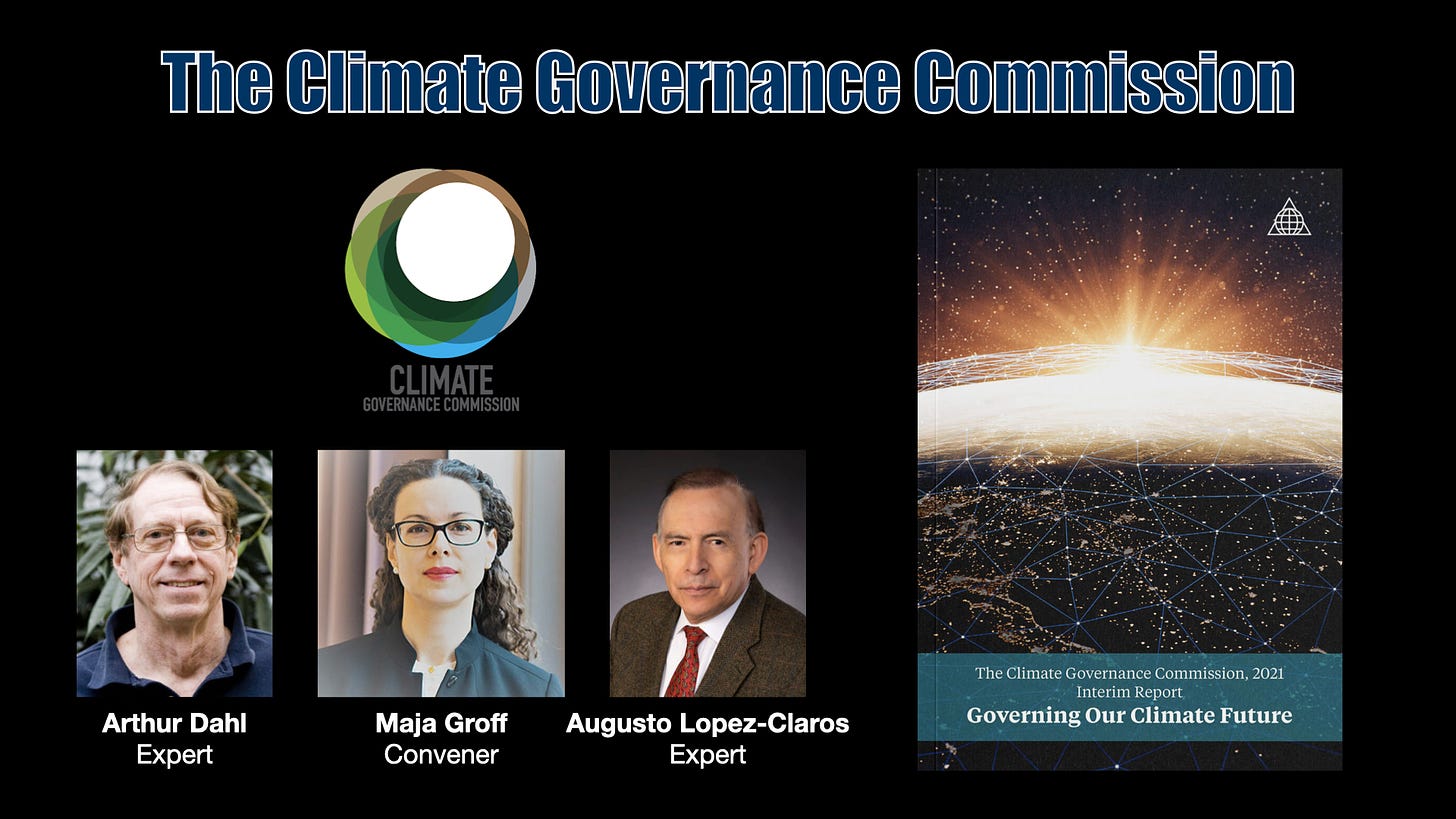
At the Forum, 20 projects to further the agenda is presented. Among them are Global Challenges Foundation’s Climate Governance Commission, convened by Maja Groff, with Arthur Dahl and Augusto Lopez as experts. Their mission is to develop new models of global governance solutions. They release their first interim report, Governing our Climate Future, in 2021 with suggestions on how to reform the global governance system.
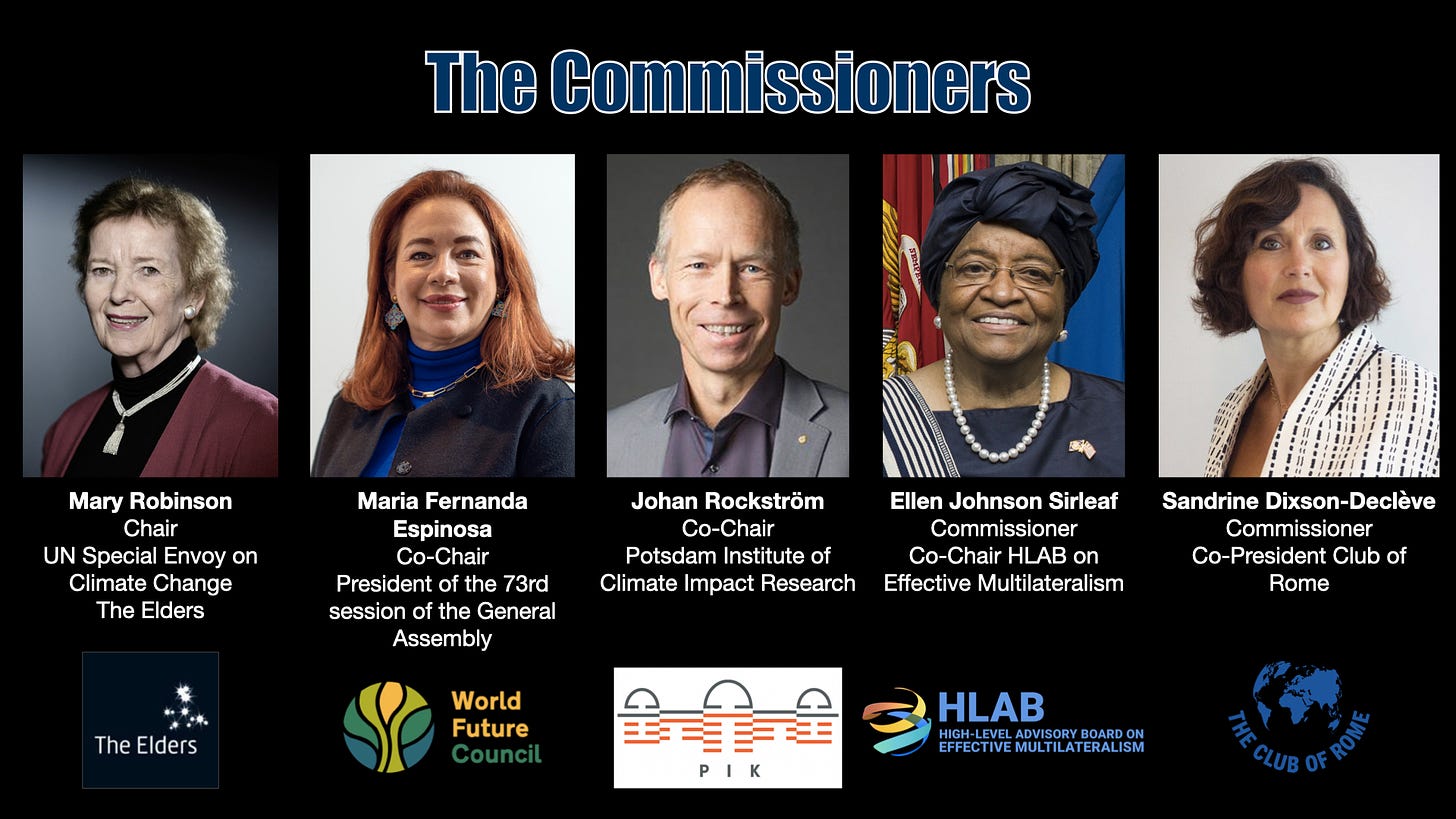
The commission, chaired by Mary Robinson, Maria Espinosa and Johan Rockström also consists of members such as the Club of Rome co-president Sandrine Dixson-Declève and Ellen Johnson Sirleaf.

Ellen is also the co-chair for the High Level Advisory Board on Effective Multilateralism together with former Swedish Prime Minister Stefan Löfvén. A panel sponsored by Global Challenges Foundation as well as the Bahbaai International Community.
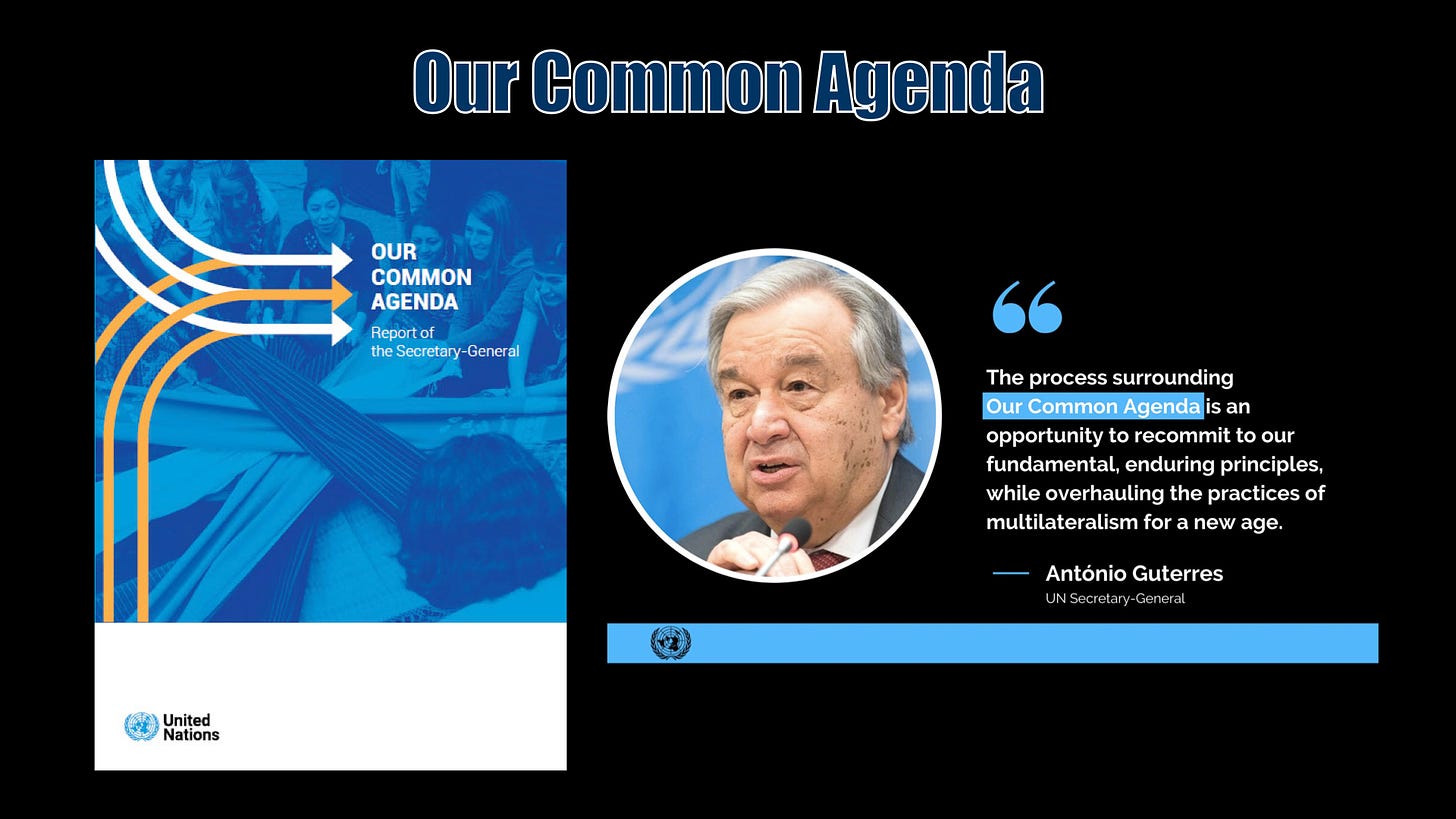
This High Level Board had been created by Antonio Guterres with the task to support Our Common Agenda and the Summit of the Future and develop proposals on how governance improvements could be achieved.
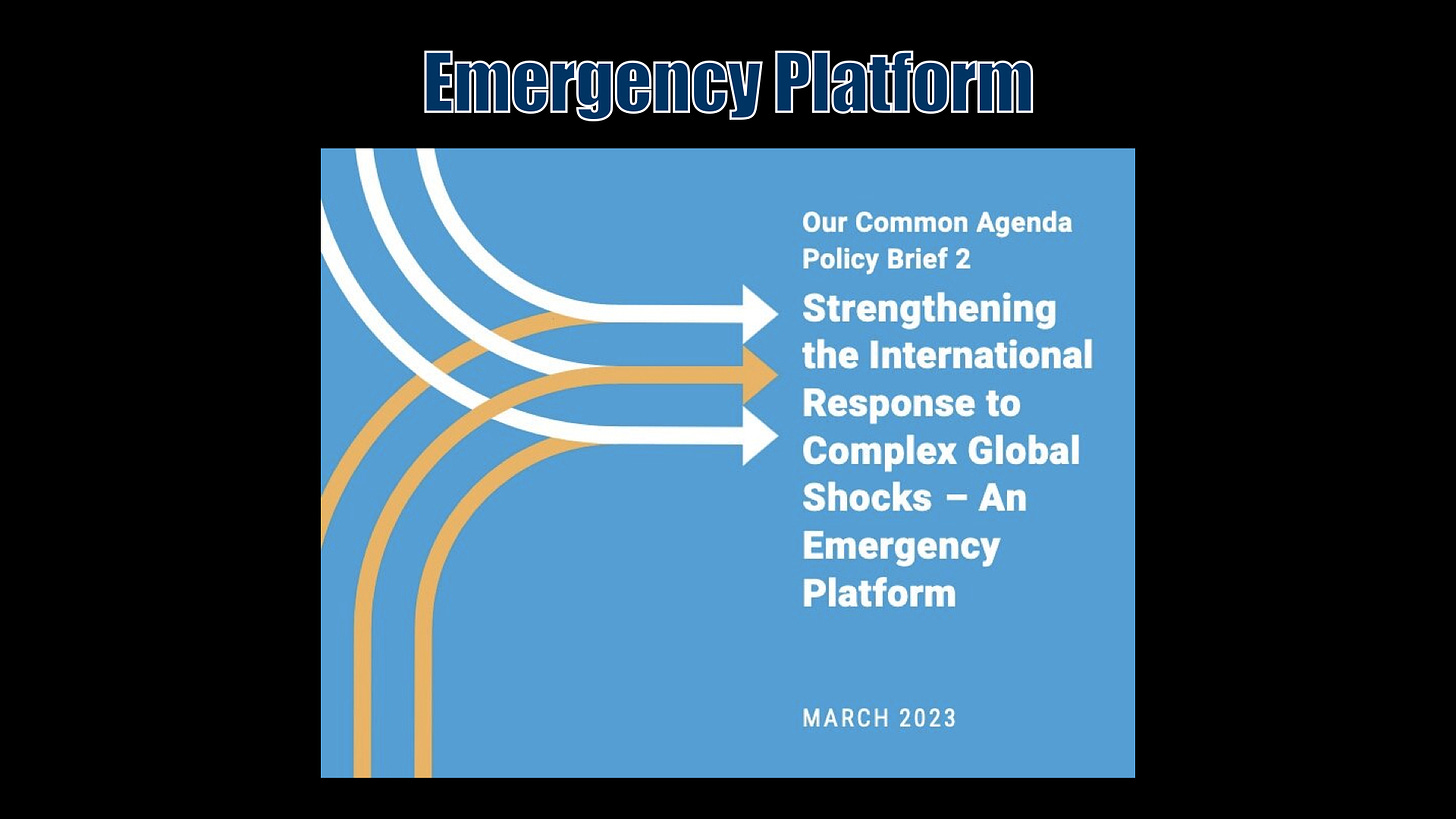
One of the proposals in Our Common Agenda is the set up of an Emergency Platform to manage complex global shocks. If an emergency is declared.
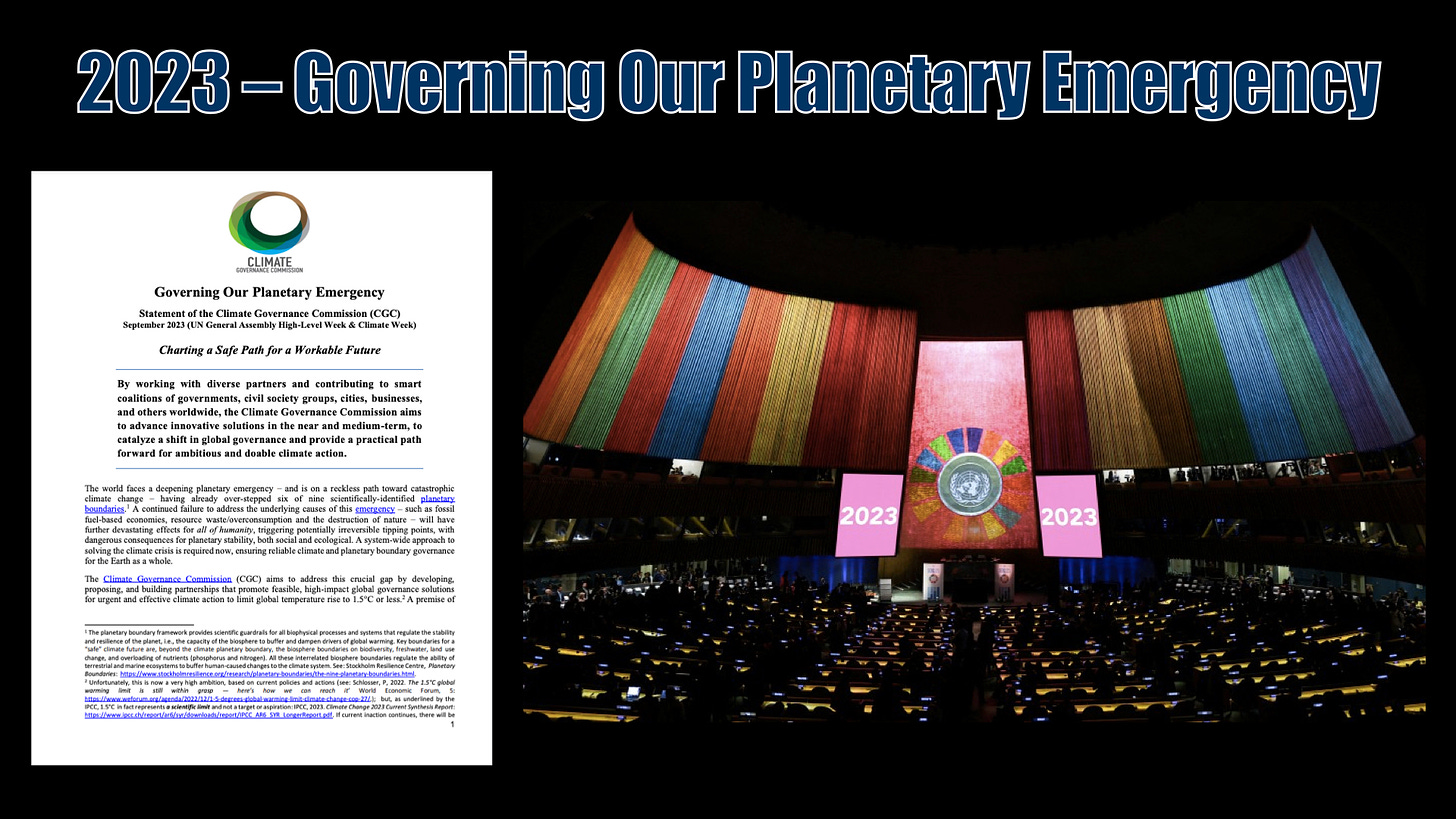
During United Nations General Assembly in September 2023 the Climate Governance Commission issues a policy paper called Governing our Planetary Emergency.
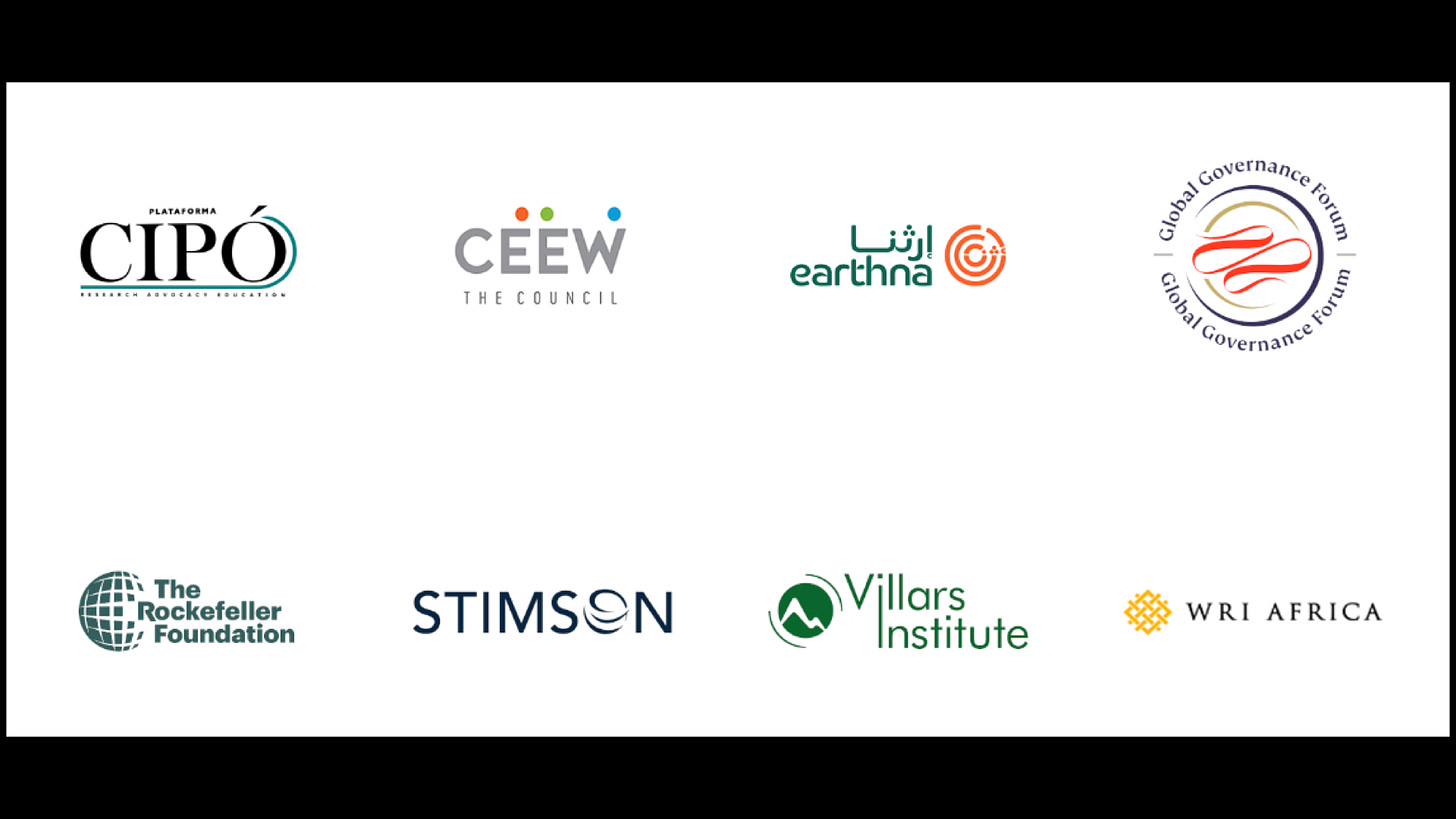
Among the supporters we find the Rockefeller Foundation.
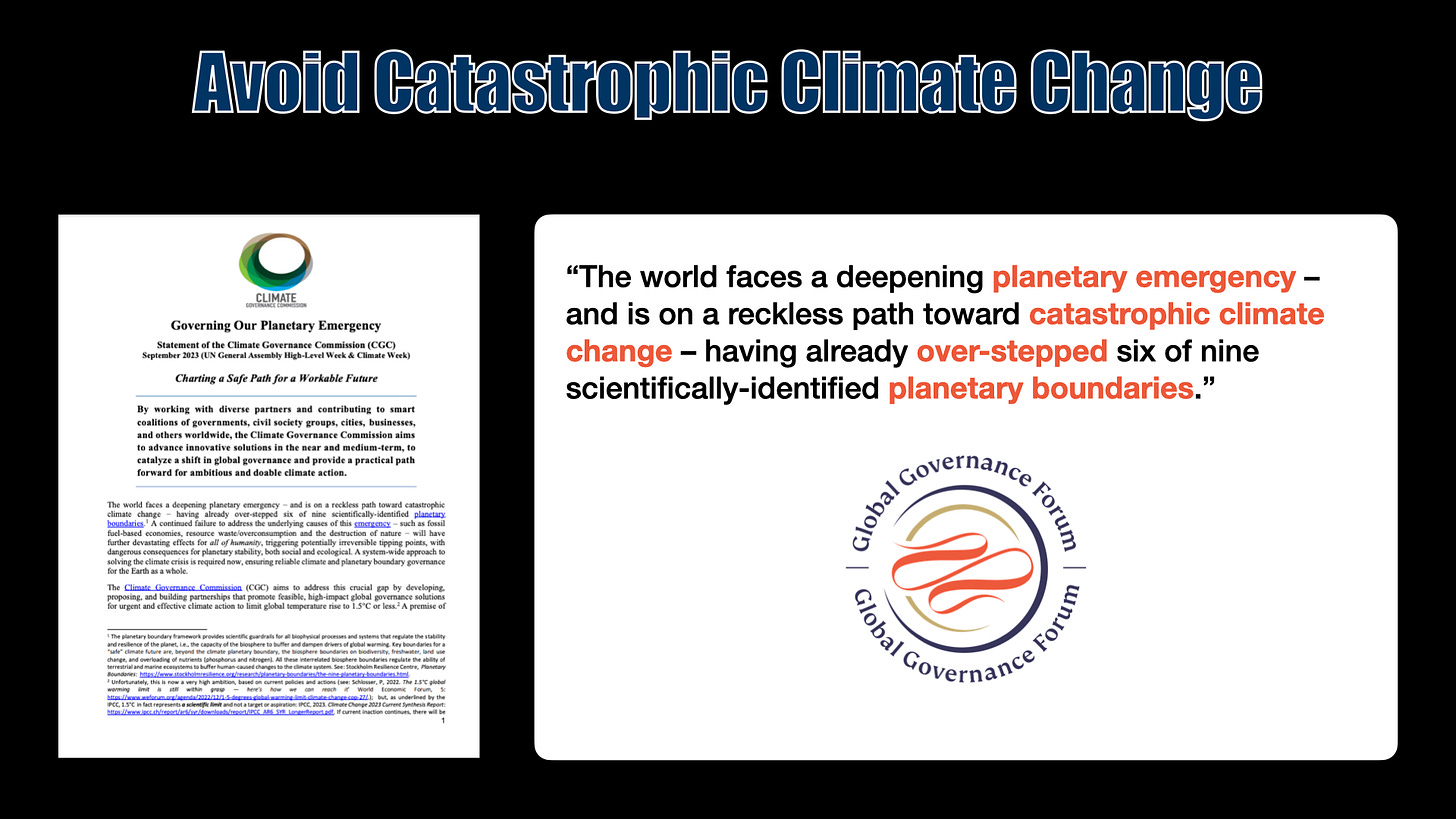
They proclaim that: ”The world faces a deepening planetary emergency – and is on a reckless path toward catastrophic climate change – having already over-stepped six of nine scientifically-identified planetary boundaries. A system-wide approach to solving the climate crisis is required now, ensuring reliable climate and planetary boundary governance for the Earth as a whole.”
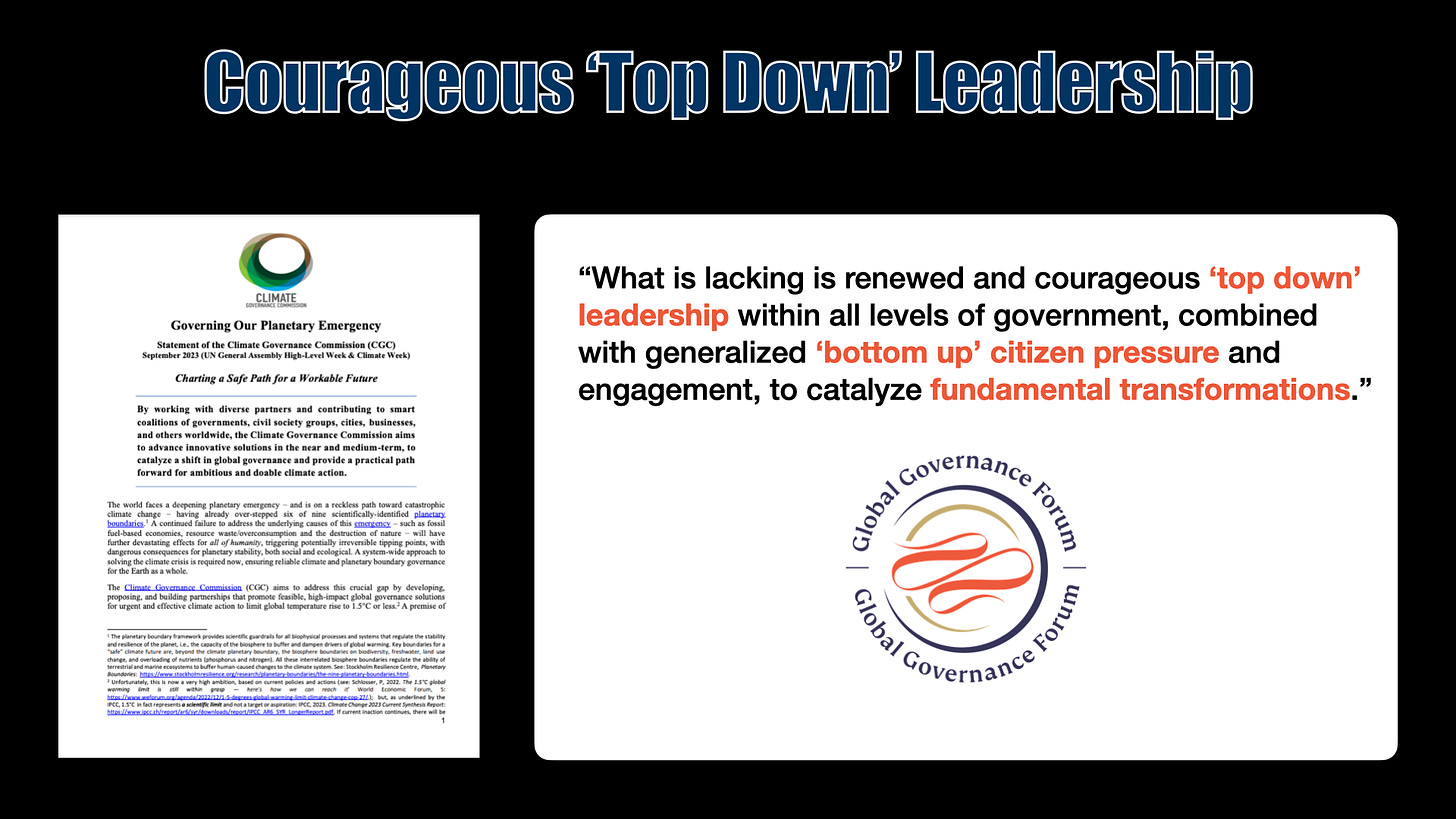
They state that ”What is lacking is renewed and courageous “top down” leadership within all levels of government, combined with generalized “bottom up” citizen pressure and engagement, to catalyze fundamental transformations.”
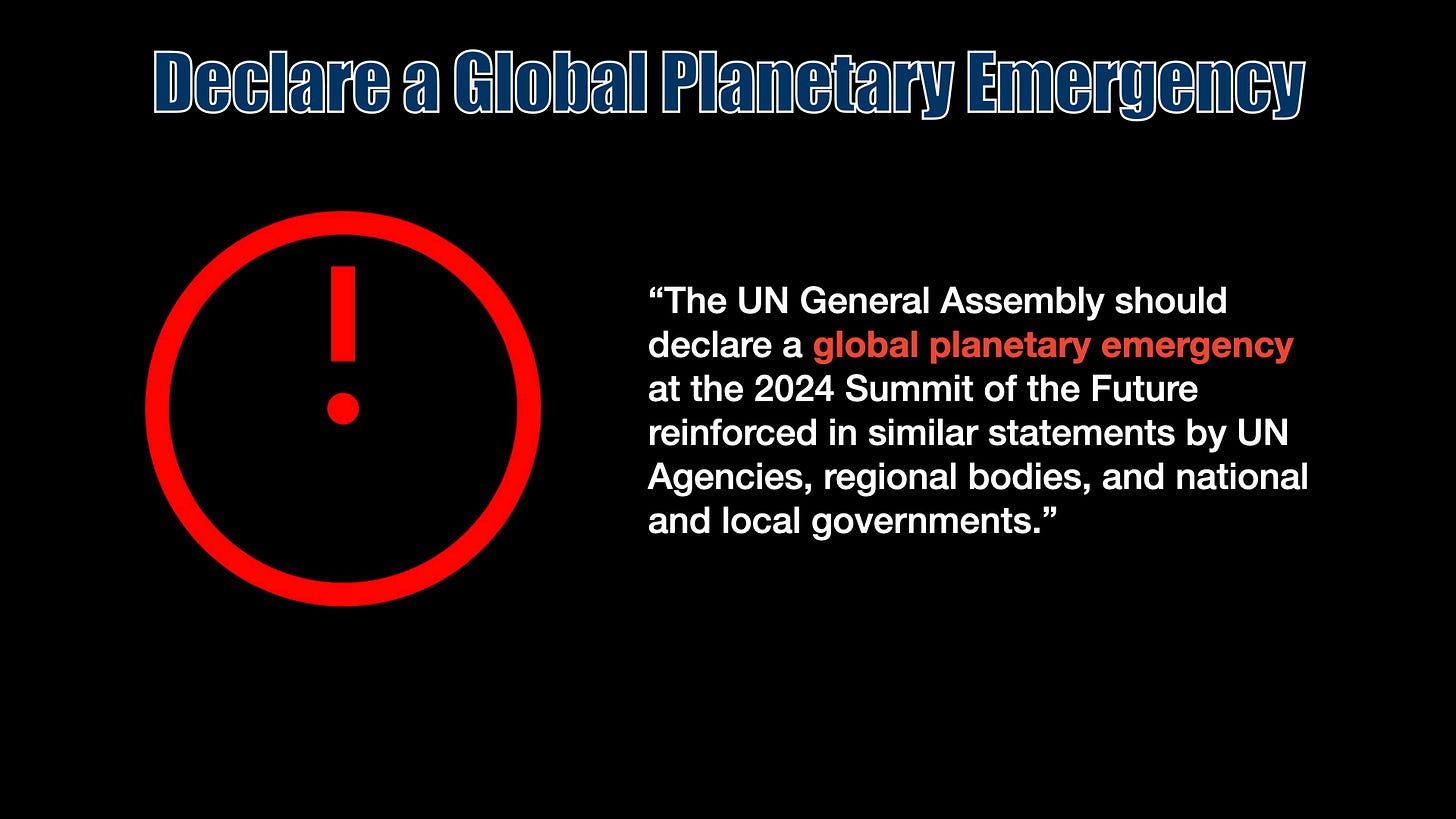
To set the plan in motion they want the UN General Assembly to declare a global planetary emergency at the 2024 Summit of the Future.
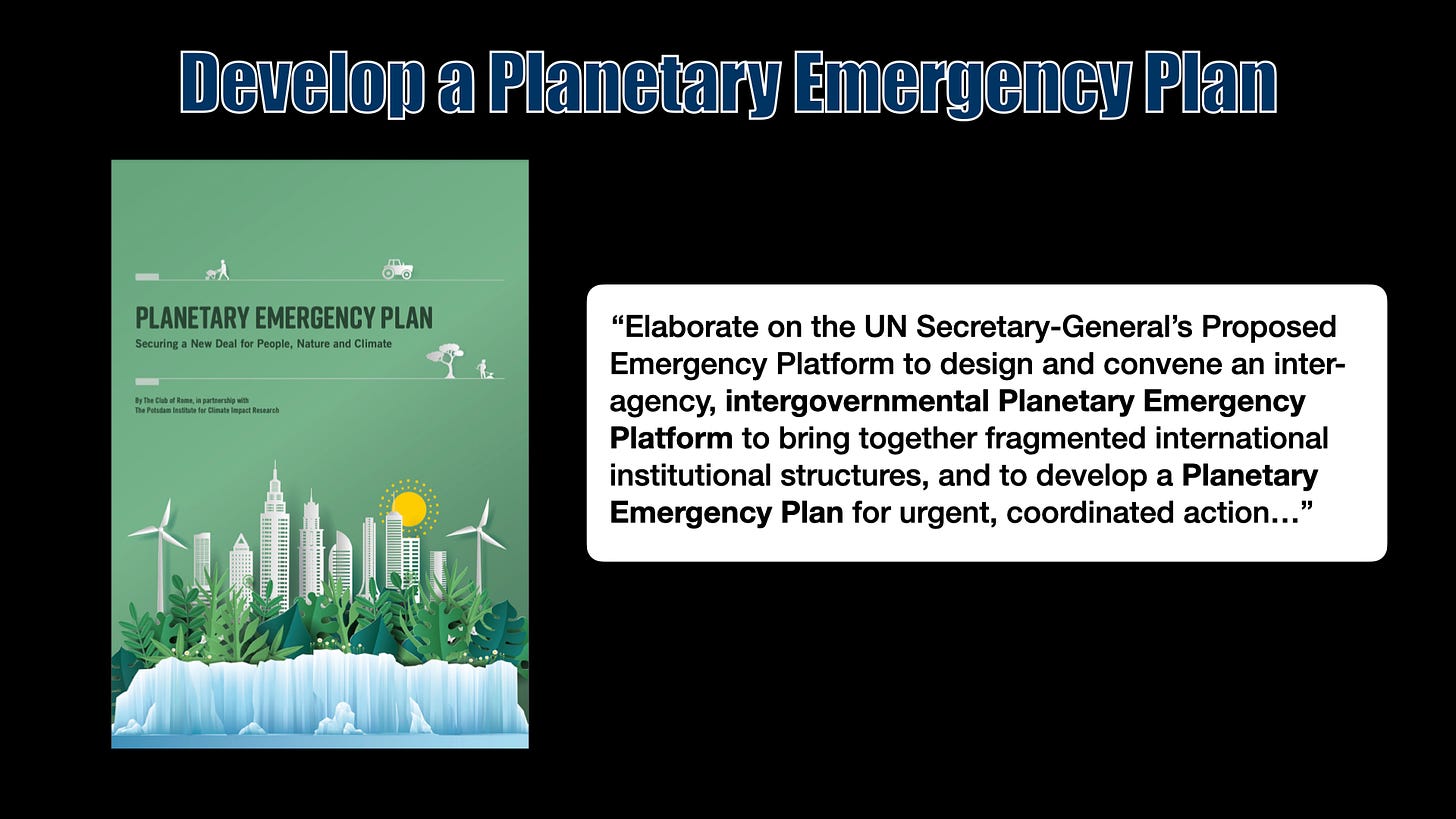
They also want to convene an intergovernmental Planetary Emergency Platform and develop a Planetary Emergency Plan for urgent, coordinated action…
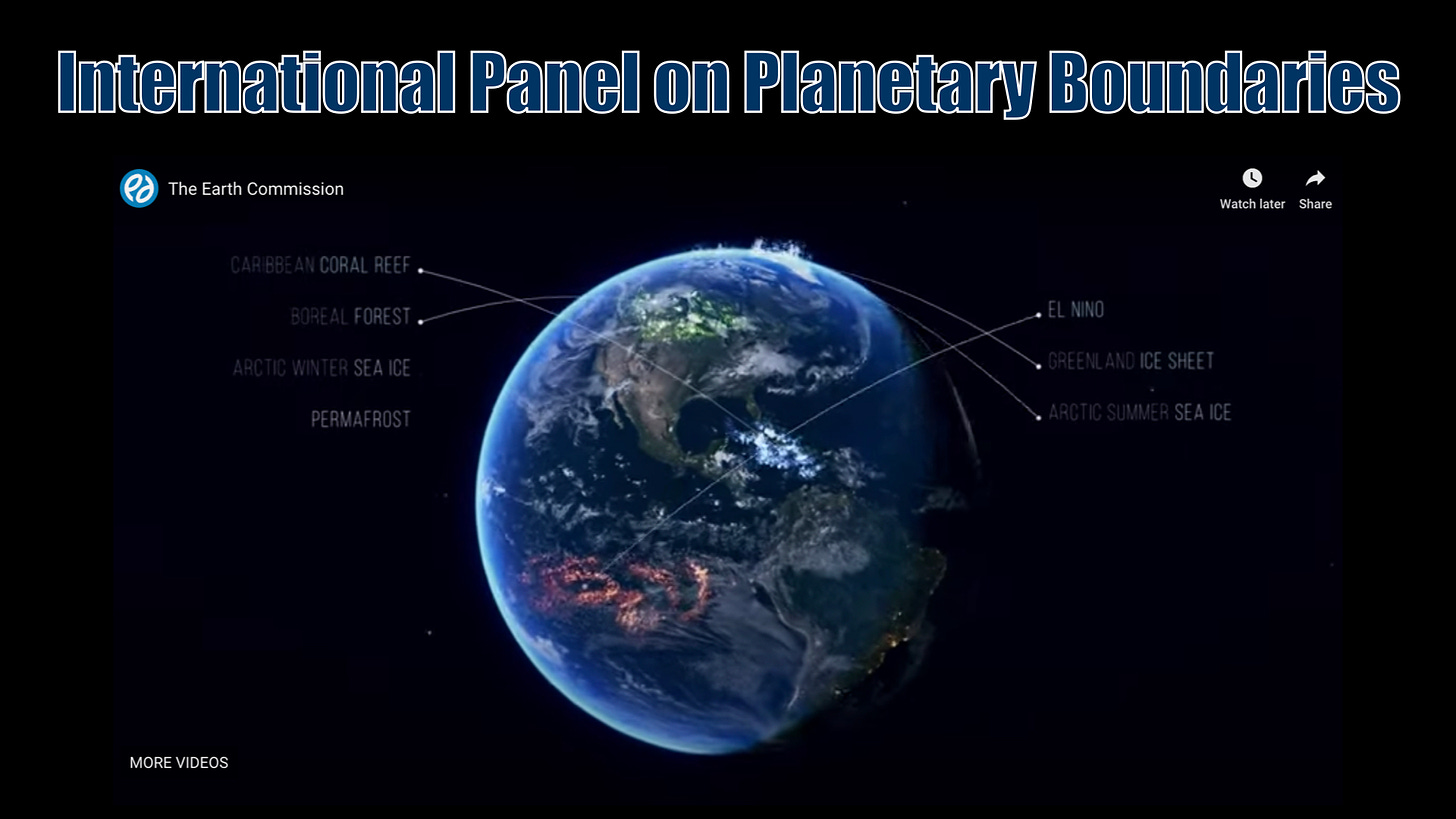
An International Panel on Planetary Boundaries is proposed ”to communicate scientific findings and policy matters to relevant national and international governance bodies, and the general public.”
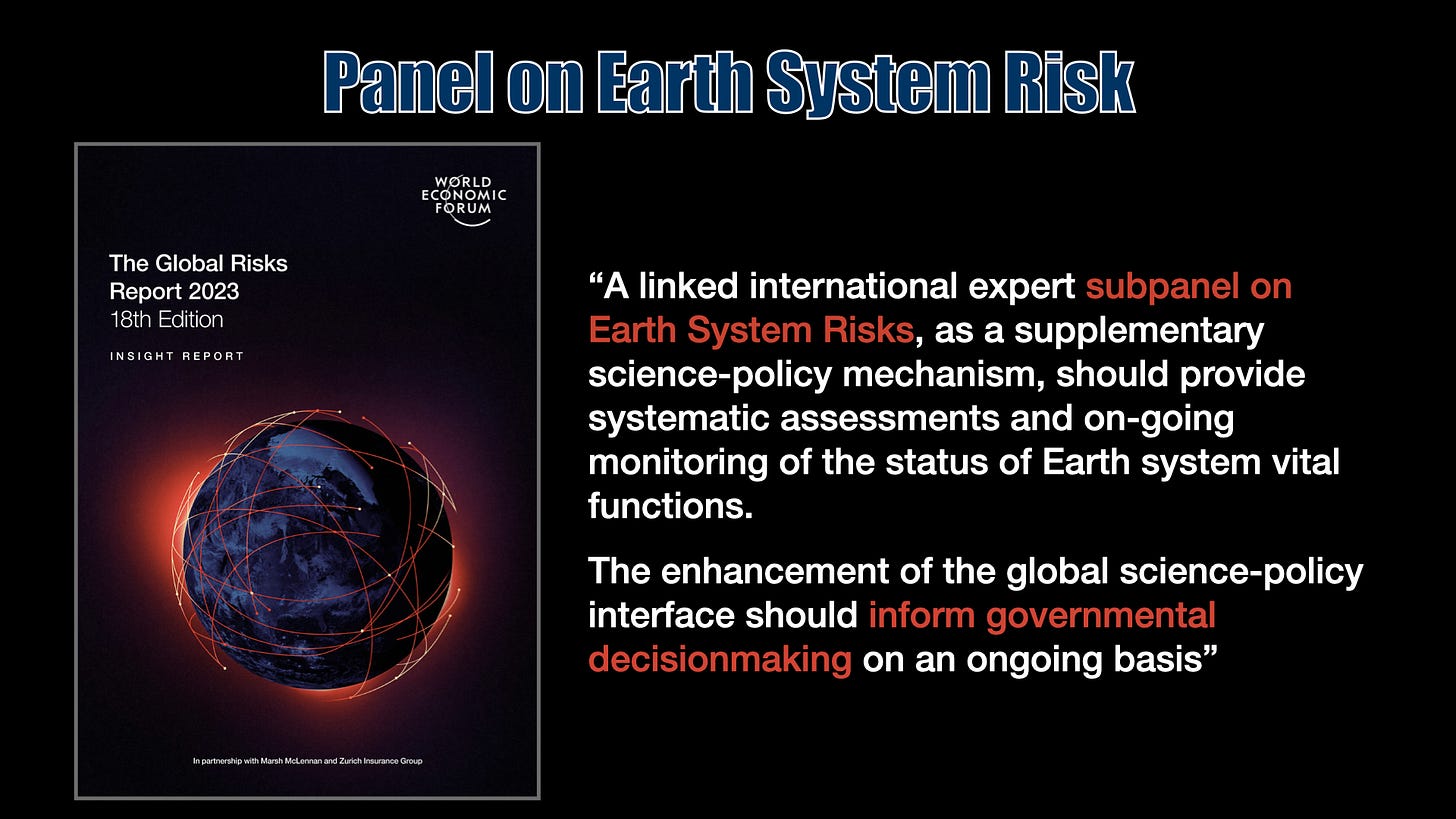
As well as a sub-panel on Earth System Risk ”to provide on-going monitoring of the status of Earth system vital functions”. They should inform governmental decision making on an ongoing basis.
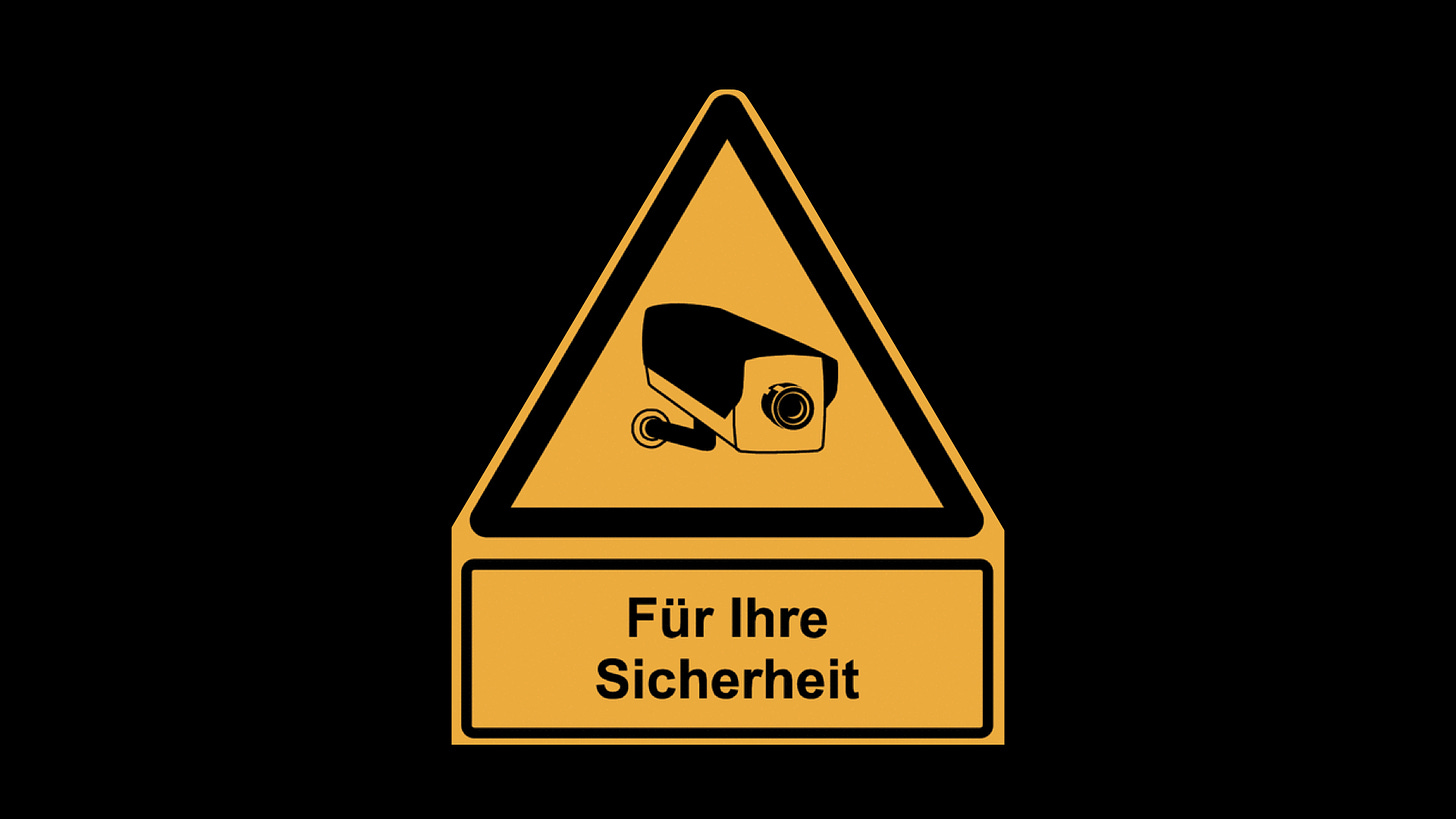
All for the sake of Safeguarding the Planet.
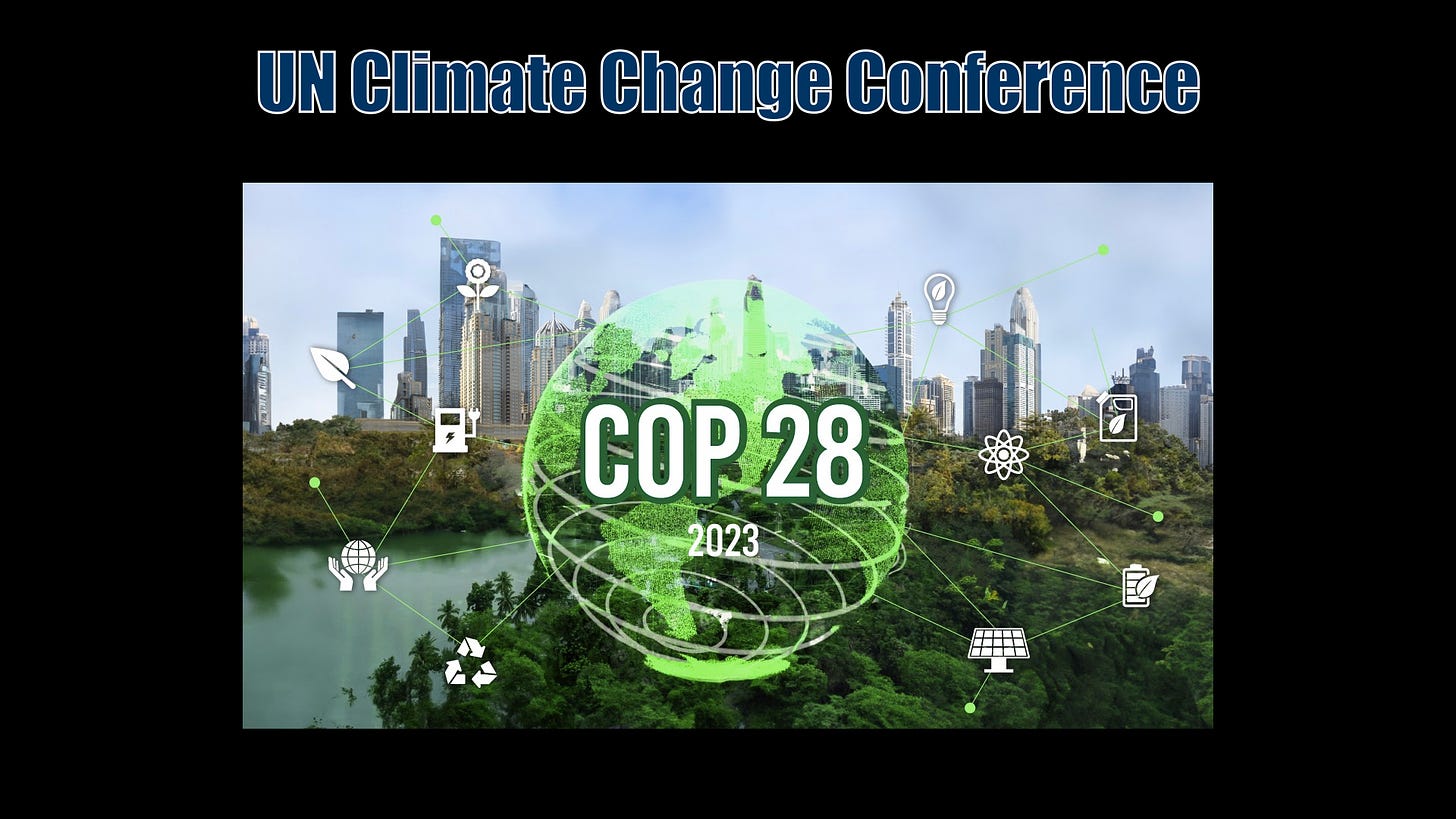
Their new report will be released during COP 28 in Dubai.
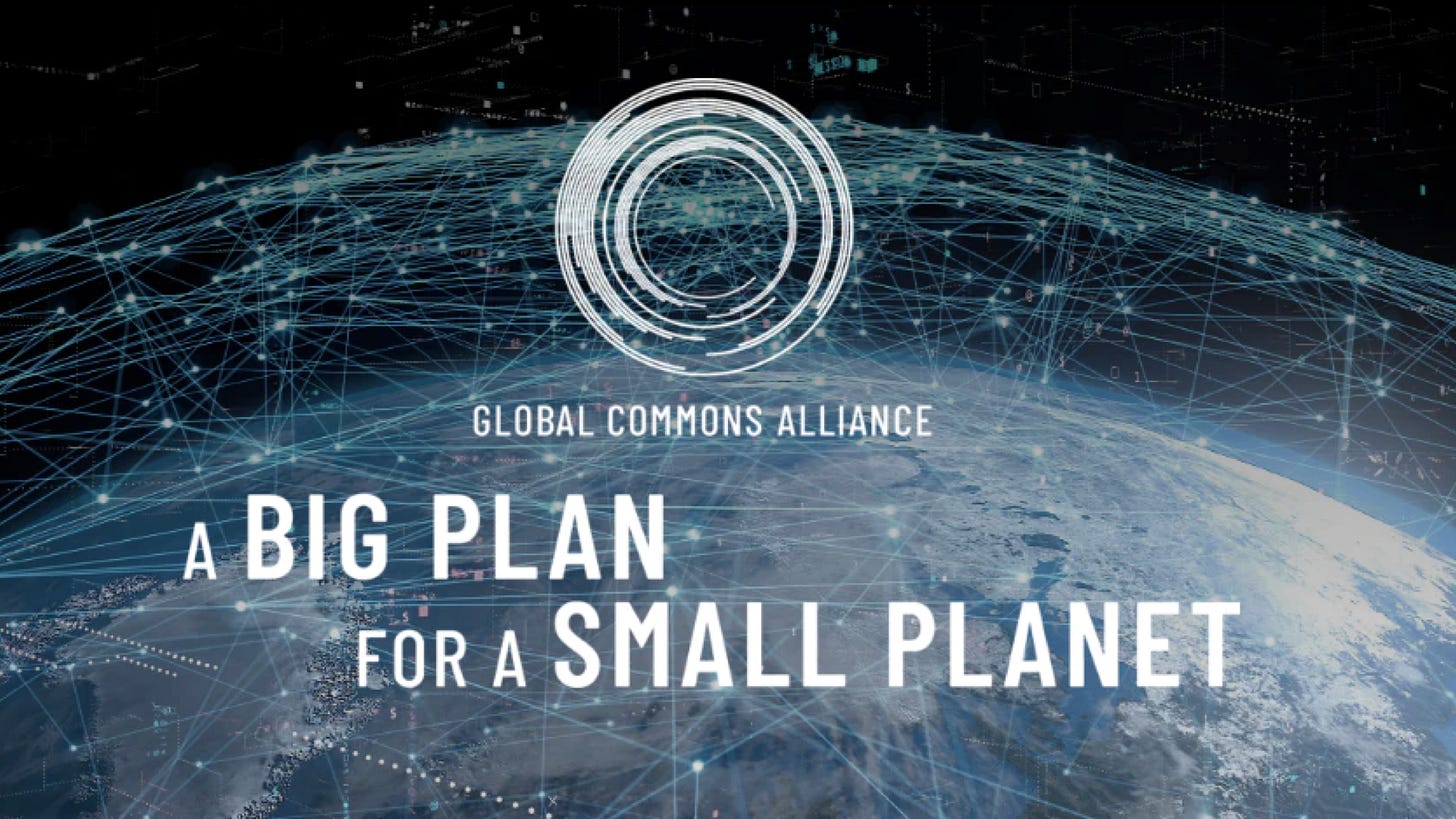
But everything has already been prepared in the background. The ambitious project Global Commons Alliance was launched in 2019.
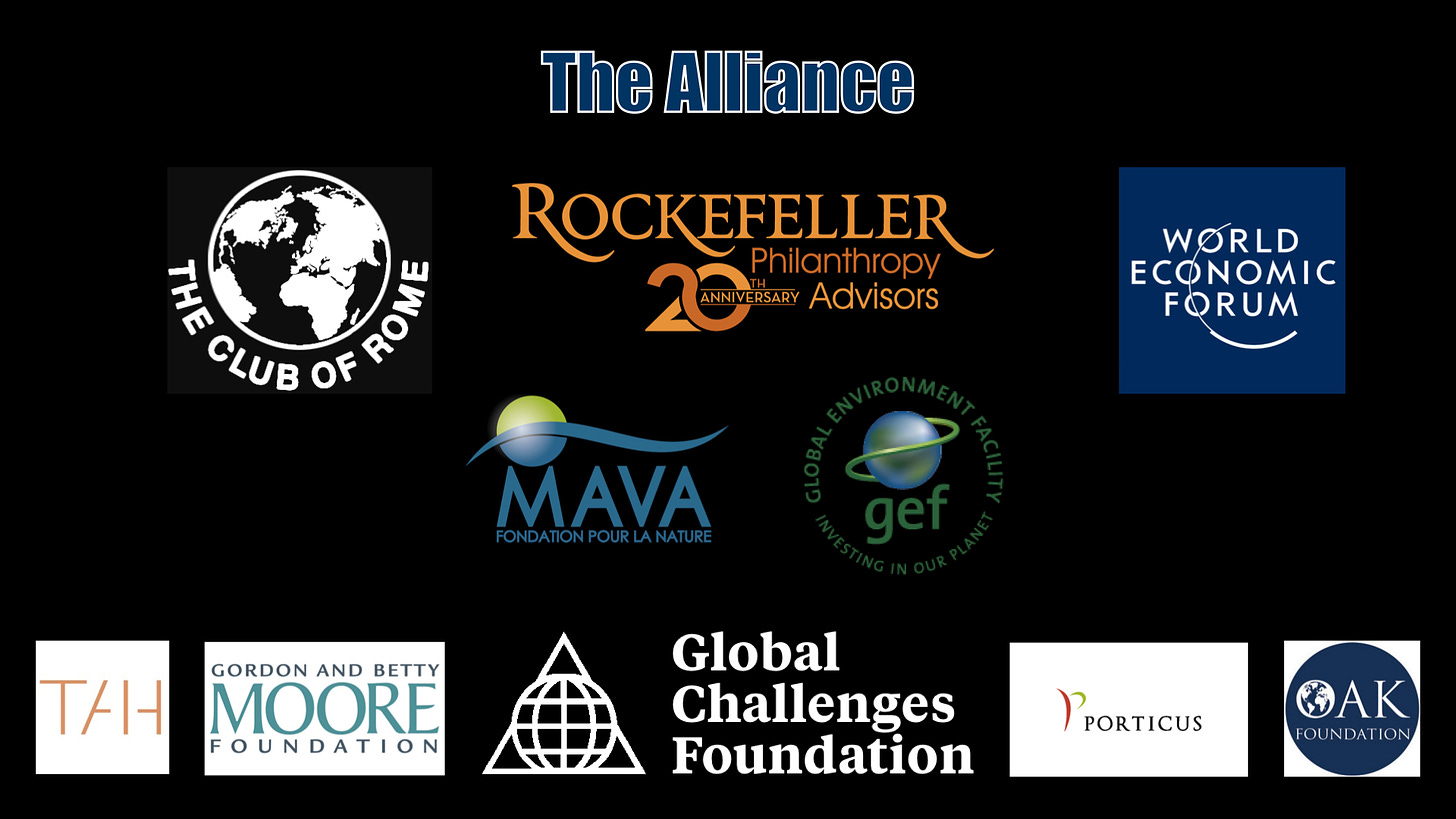
The project is coordinated by the Rockefeller Philanthropy Advisors with World Economic Forum, the Club of Rome and United Nations Global Environmental Facility among its seventy partners, with funding from among others the Global Challenges Foundation. It is a project funded by the ultra-rich.
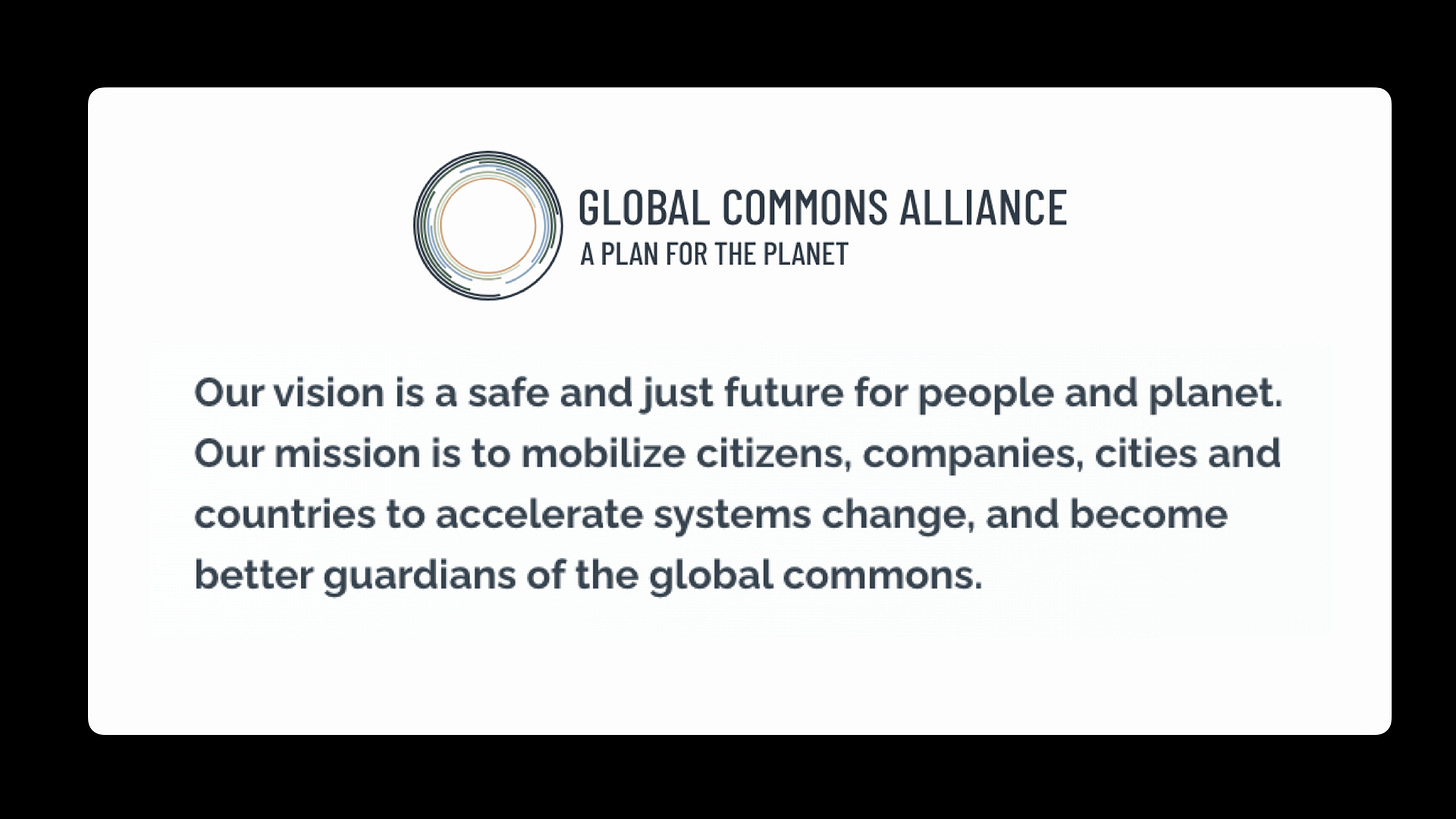
Their mission is to mobilize citizens, companies, cities and countries to accelerate systems change, and become better guardians of the global commons.
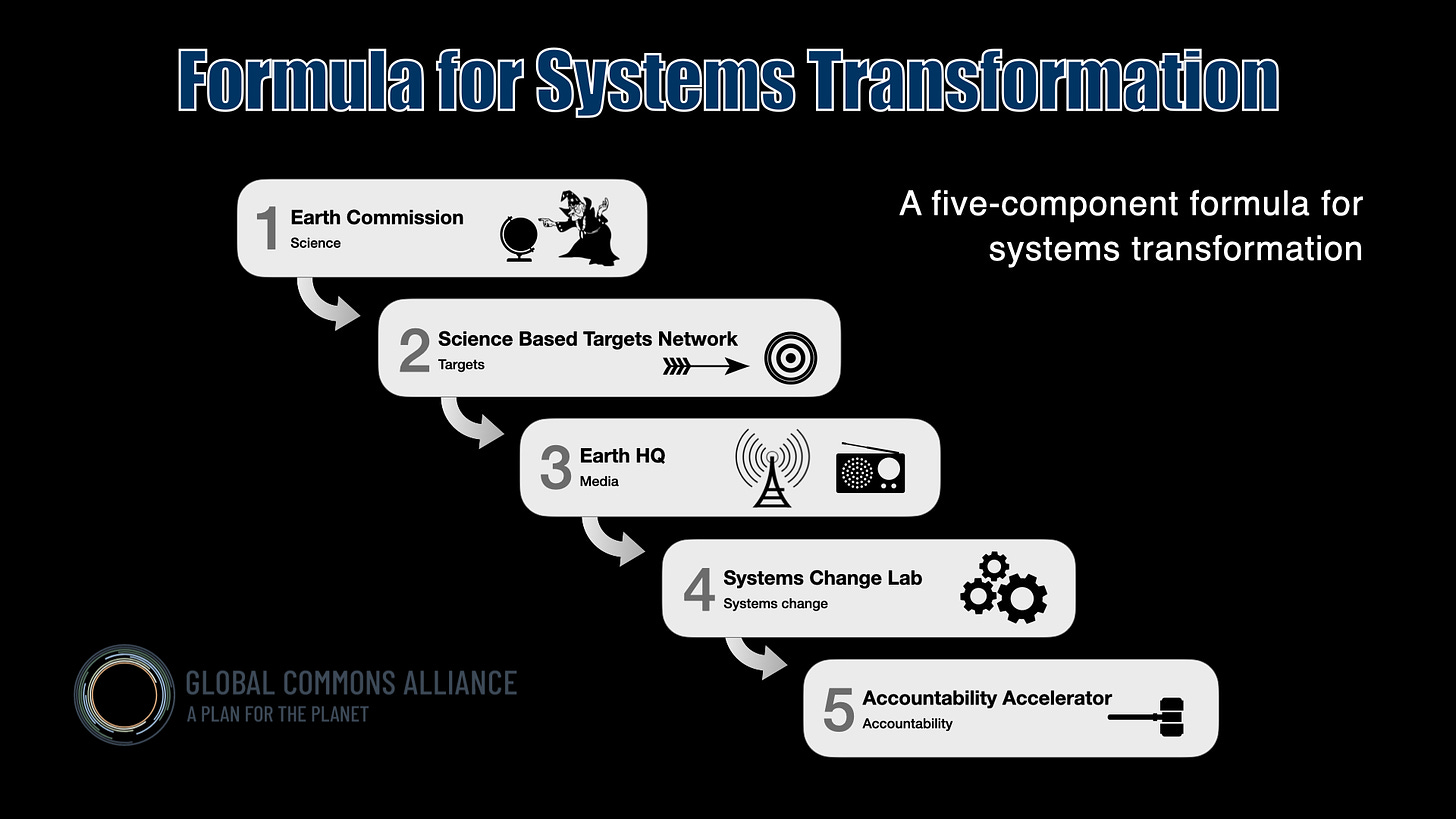
To achieve this they have constructed a five-part formula for systems transformation:
The Earth Commission determines the science
The Science Based Target Network sets the targets
The Earth HQ communicates the science
The Systems Change Lab monitors and accelerates the changes deemed necessary
The Accountability Accelerator holds companies, cities and countries accountable.
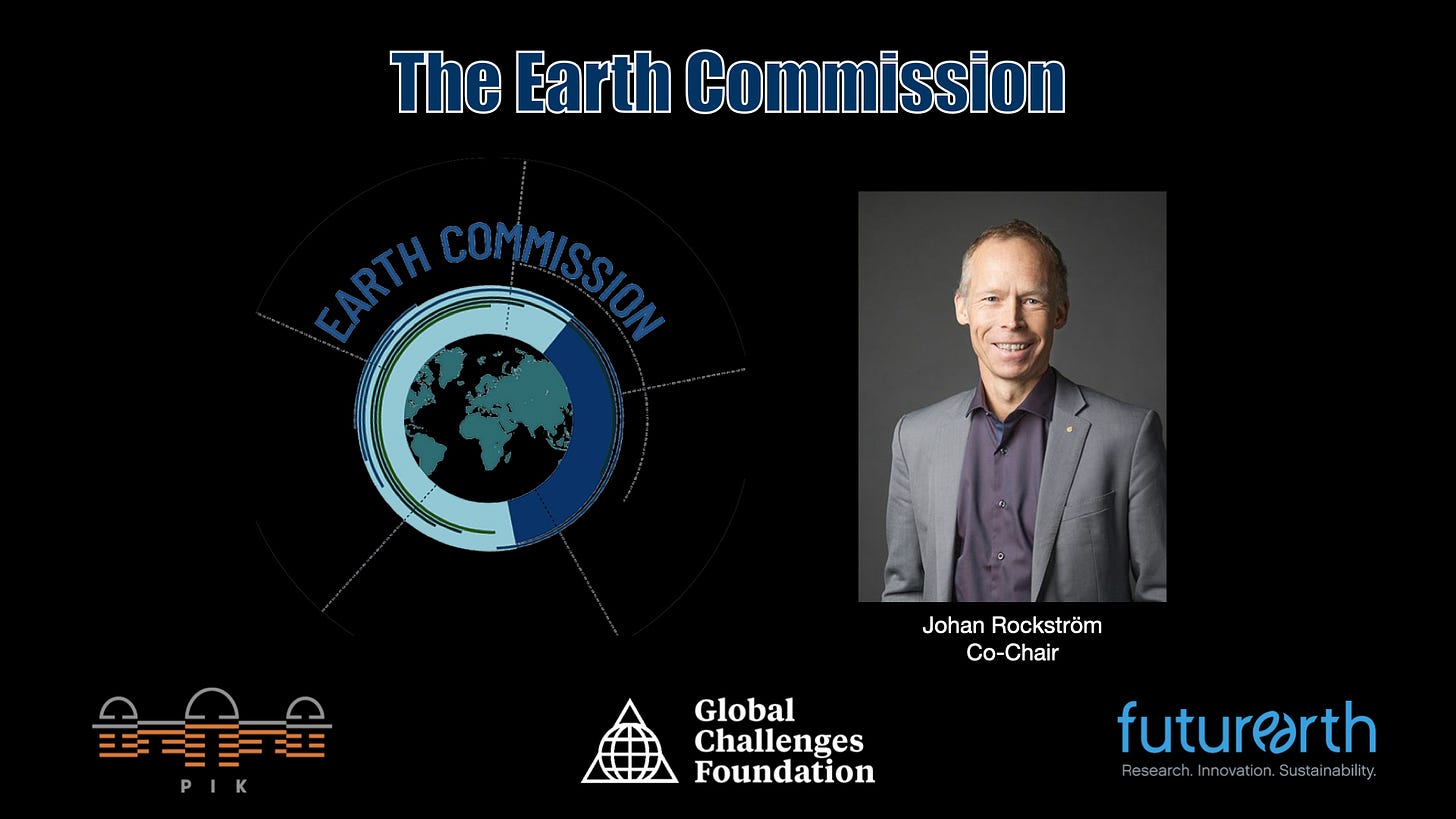
The Earth Commission, that claims to be the first holistic attempt to scientifically define and quantify a safe and just corridor for people and planet is co-chaired by Johan Rockström.
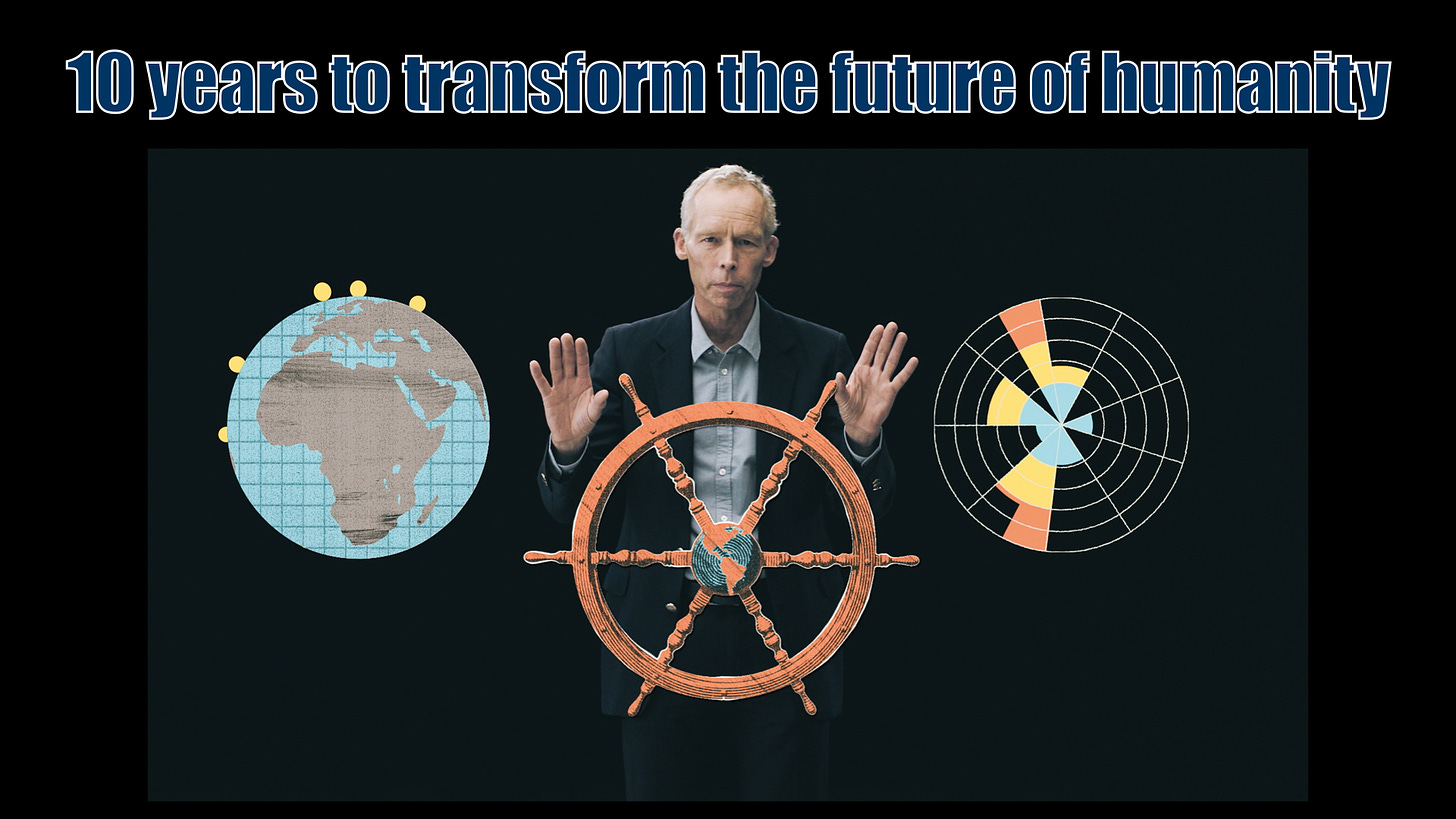
The concept is built on his planetary boundaries framework. We have to be steered and managed in order not to over-step our boundaries. Here is Johan with the steering wheel at his Ted Talk 10 Years to Transform the Future of Humanity from October 2020.
The Earth Commission is hosted by Future Earth with its office in the Swedish Royal Academy of Sciences at Frescati in Stockholm. The home of the Beijer Institute. By the terms of Alfred Nobel’s will The Royal Academy awards the Nobel Prizes in physics and chemistry since 1901. Svante Arrhenius received the prize in 1903.
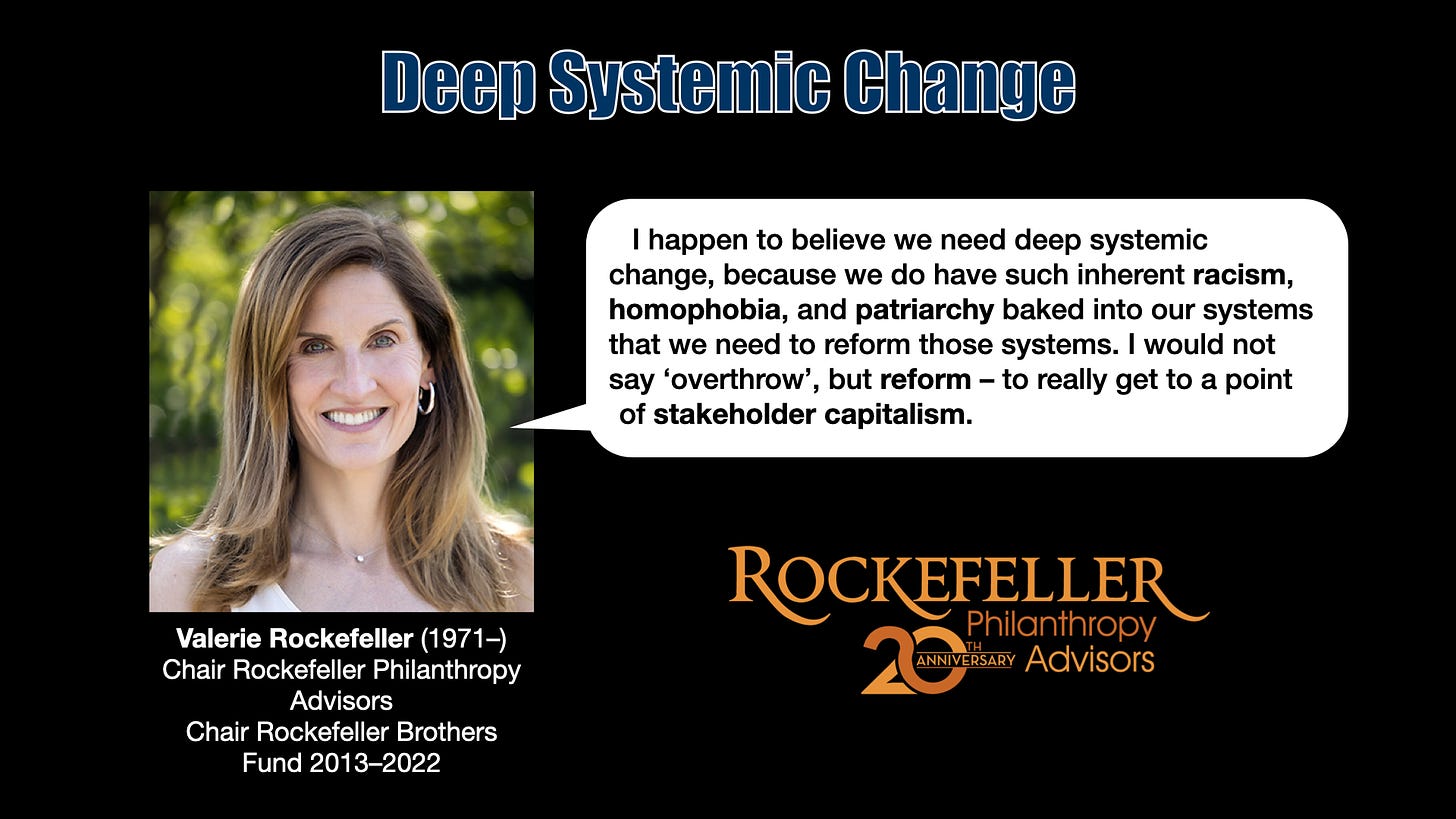
The project coordinator Rockefeller Philanthropy Advisors is chaired by Valerie Rockefeller. She said in a 2022 interview with Spear’s Magazine that: ”I happen to believe we need deep systemic change, because we do have such inherent racism, homophobia, and patriarchy baked into our systems that we need to reform those systems. I would not say ‘overthrow’, but reform – to really get to a point of stakeholder capitalism.”
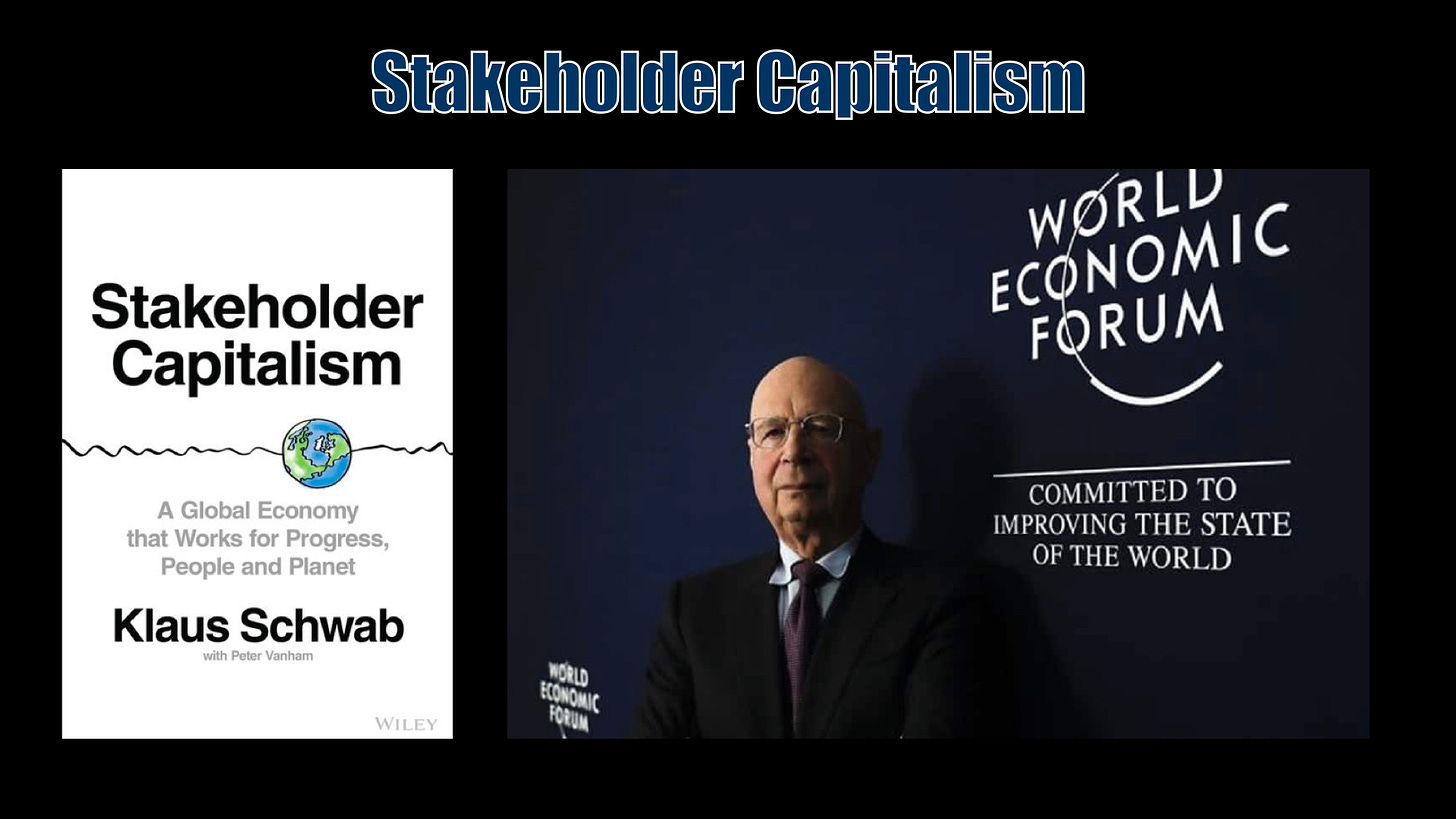
She is of course referring to Klaus Schwab’s vision of the world.
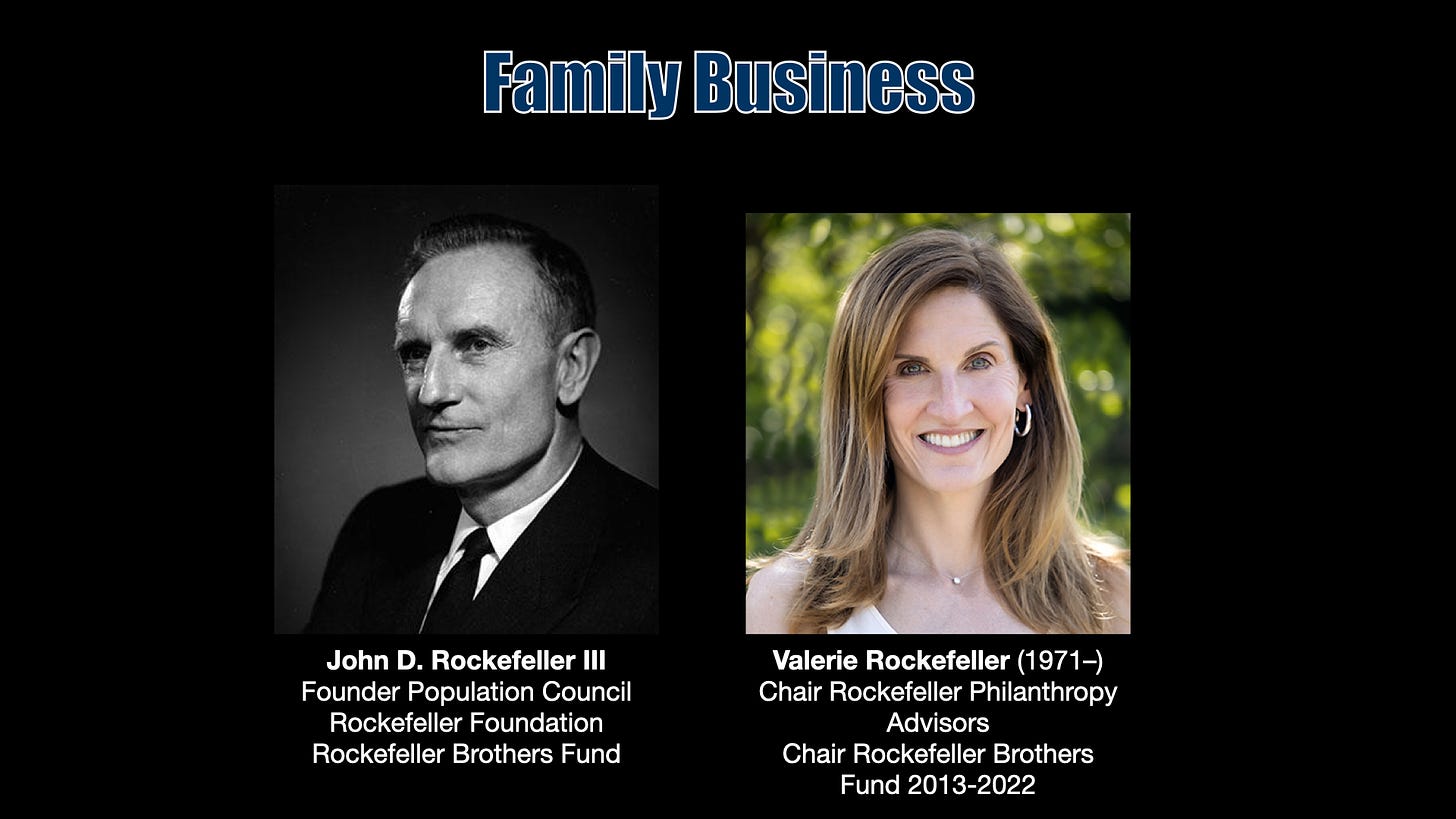
But her views have more familiar origins. Valerie Rockefeller is the granddaughter of Population Council founder John D. Rockefeller III. She has inherited the Rockefeller brothers’ 75 year old population control agenda.
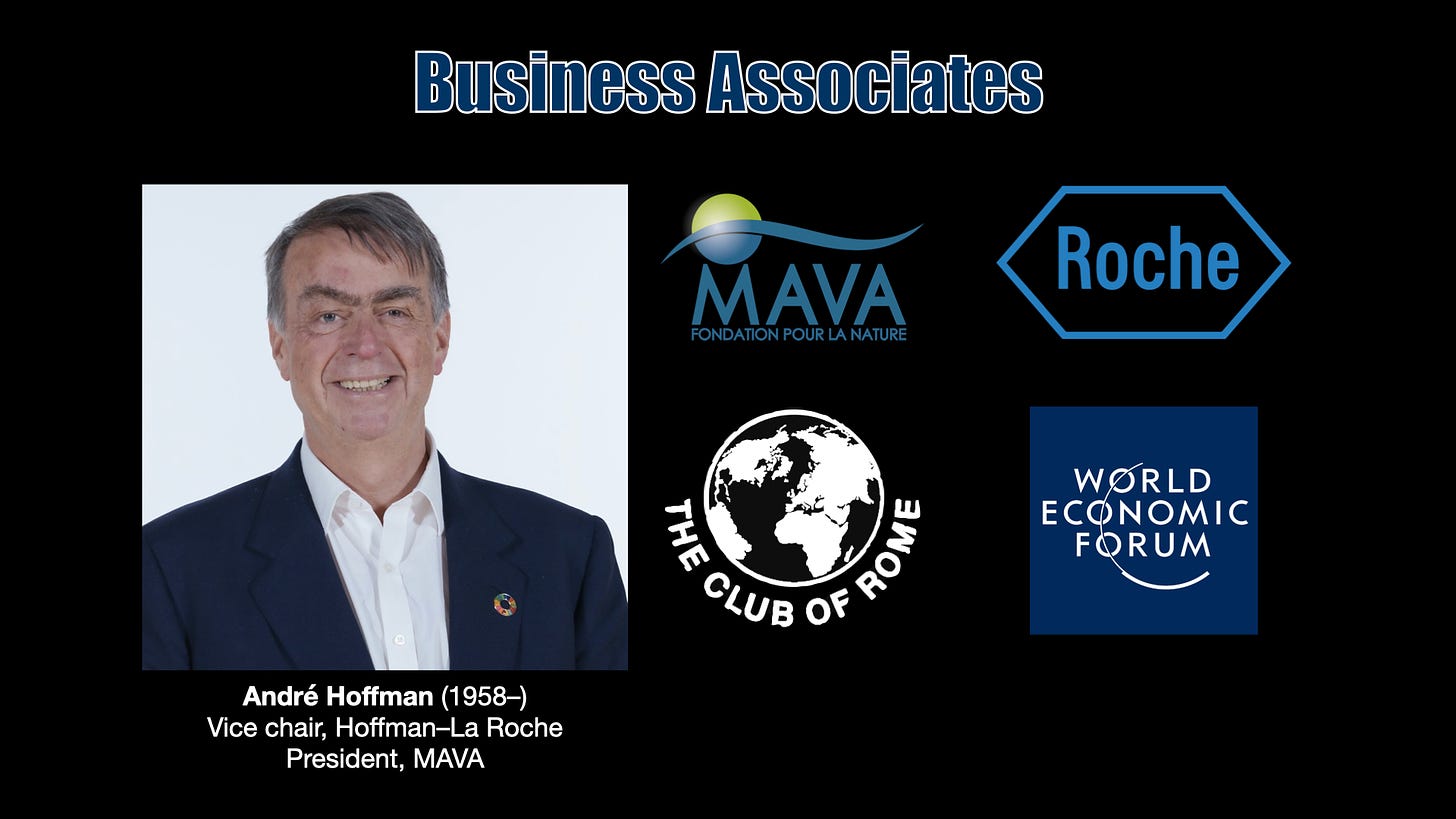
Another key financier is billionaire André Hoffman from MAVA Foundation, vice chair of pharmaceutical company Roche, member of the Club of Rome and a World Economic Forum trustee.
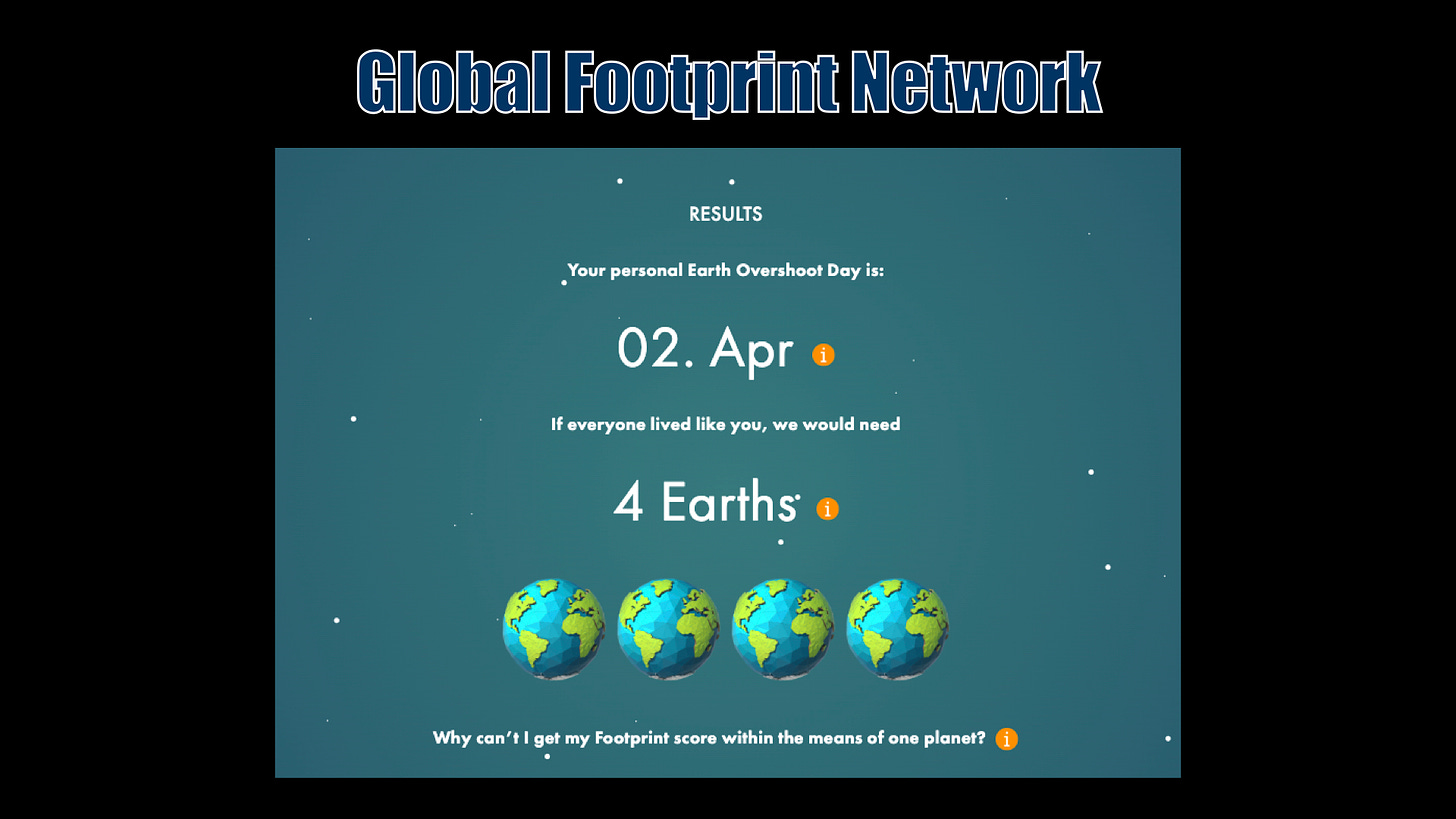
He is also the honorary chair of the Global Footprint Network that calculates our individual footprints and the Earth Overshoot Day.
When he received the David Rockefeller Bridging Leadership Award in 2022 by Valerie’s aunt Peggy Dulany from Synergos he told a story that illustrates the views of the ultra-rich: ”Planet Earth goes on holiday, planet Earth has had enough, planet Earth travels out in the Cosmos. It crosses another planet. The other planet says: ‘Hey, how are you?’ And the planet Earth replies: ‘I’ve got a bad case of Homo Sapiens.’” I am sure he doesn’t consider himself a part of the disease. He is one of the doctors delivering the cure.
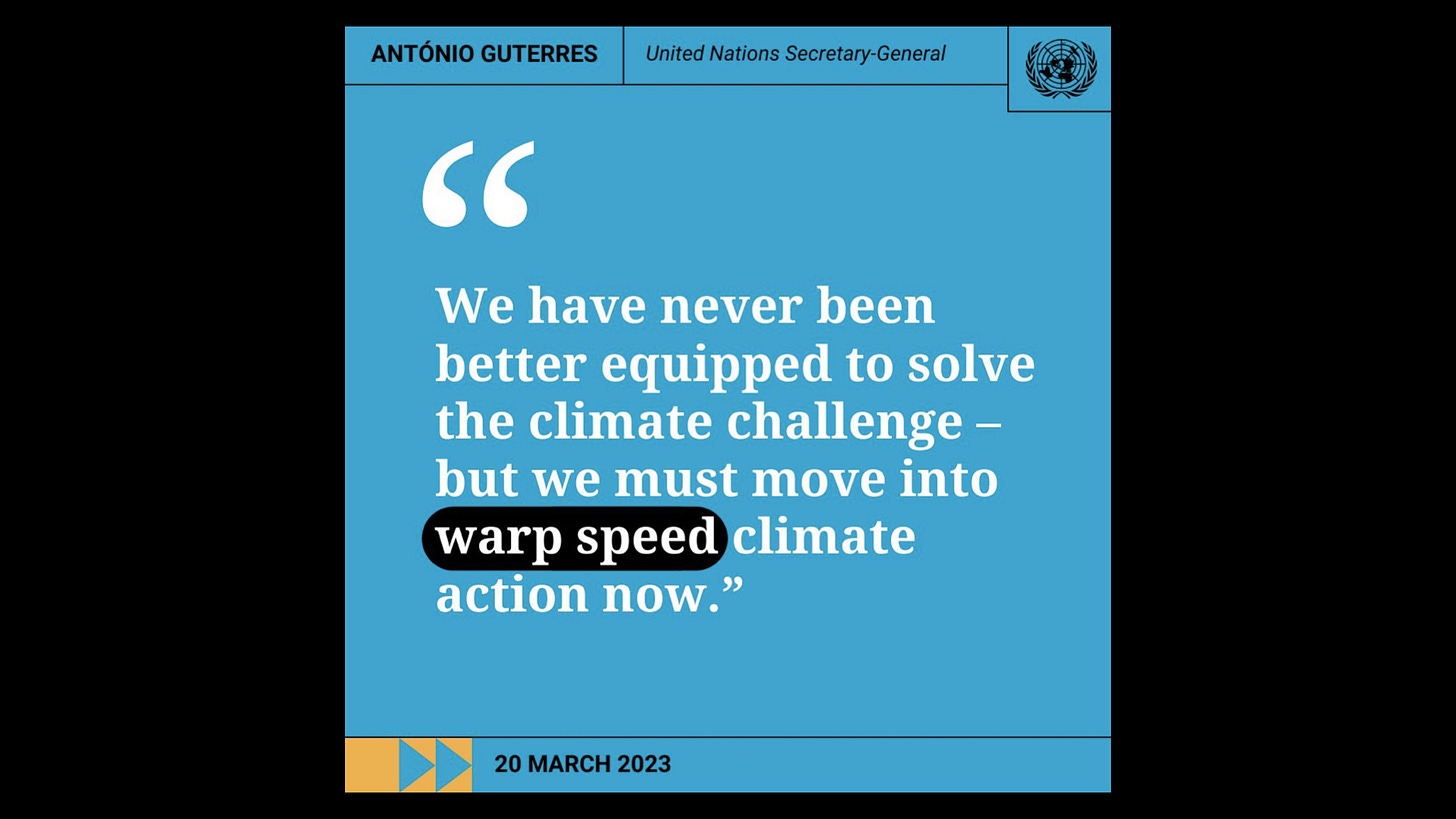
Guterres proclaimed in March that: ”We have never been better equipped to solve the climate challenge – but we must move into warp speed climate action now.”
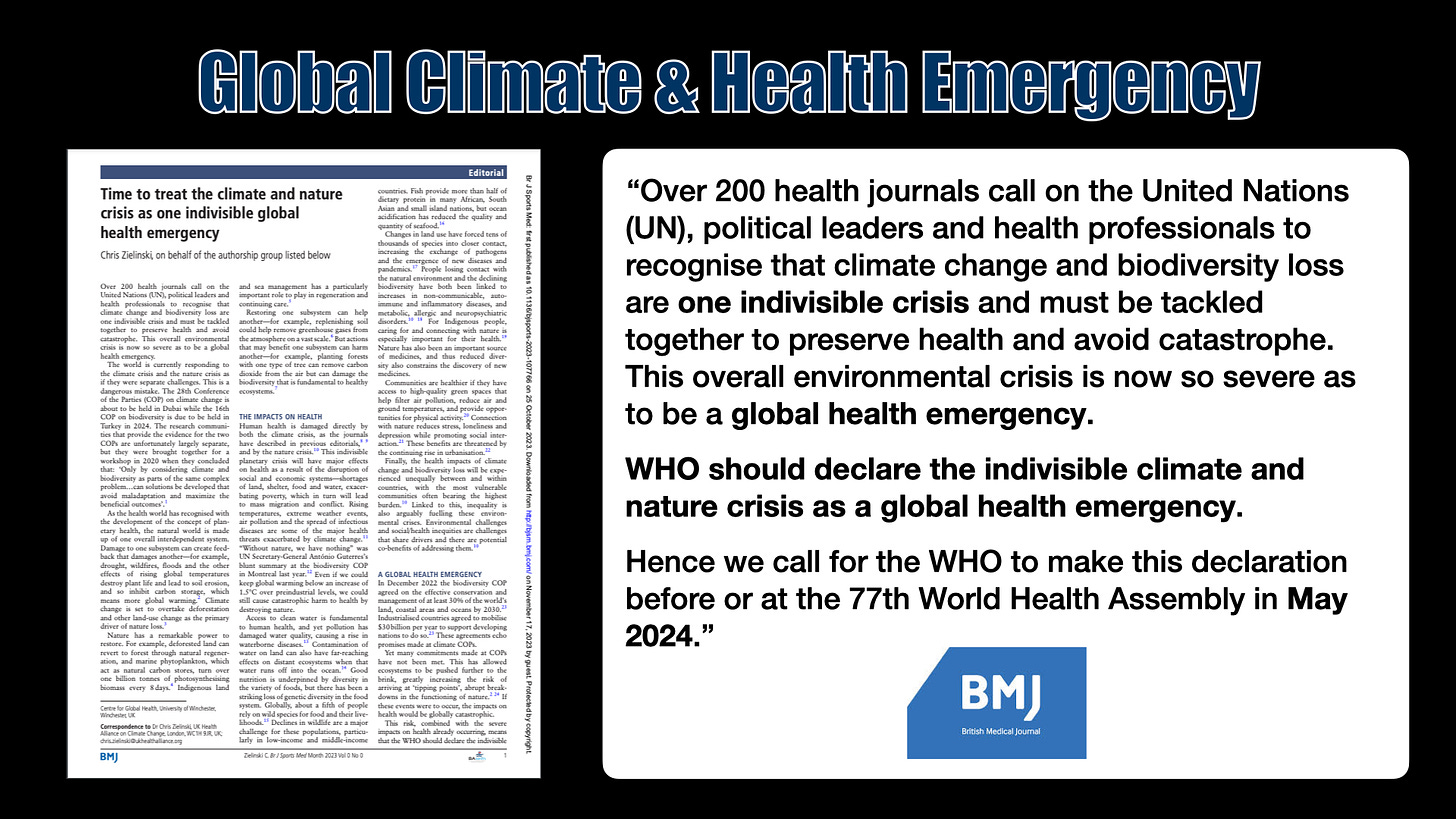
And if this wasn’t enough. On October 25th British Medical Journal published an editorial demanding that the climate crisis must be treated as a global health emergency. Quote:
”Over 200 health journals call on the United Nations (UN), political leaders and health professionals to recognise that climate change and biodiversity loss are one indivisible crisis and must be tackled together to preserve health and avoid catastrophe. This overall environmental crisis is now so severe as to be a global health emergency.
WHO should declare the indivisible climate and nature crisis as a global health emergency.
Hence we call for the WHO to make this declaration before or at the 77th World Health Assembly in May 2024.”
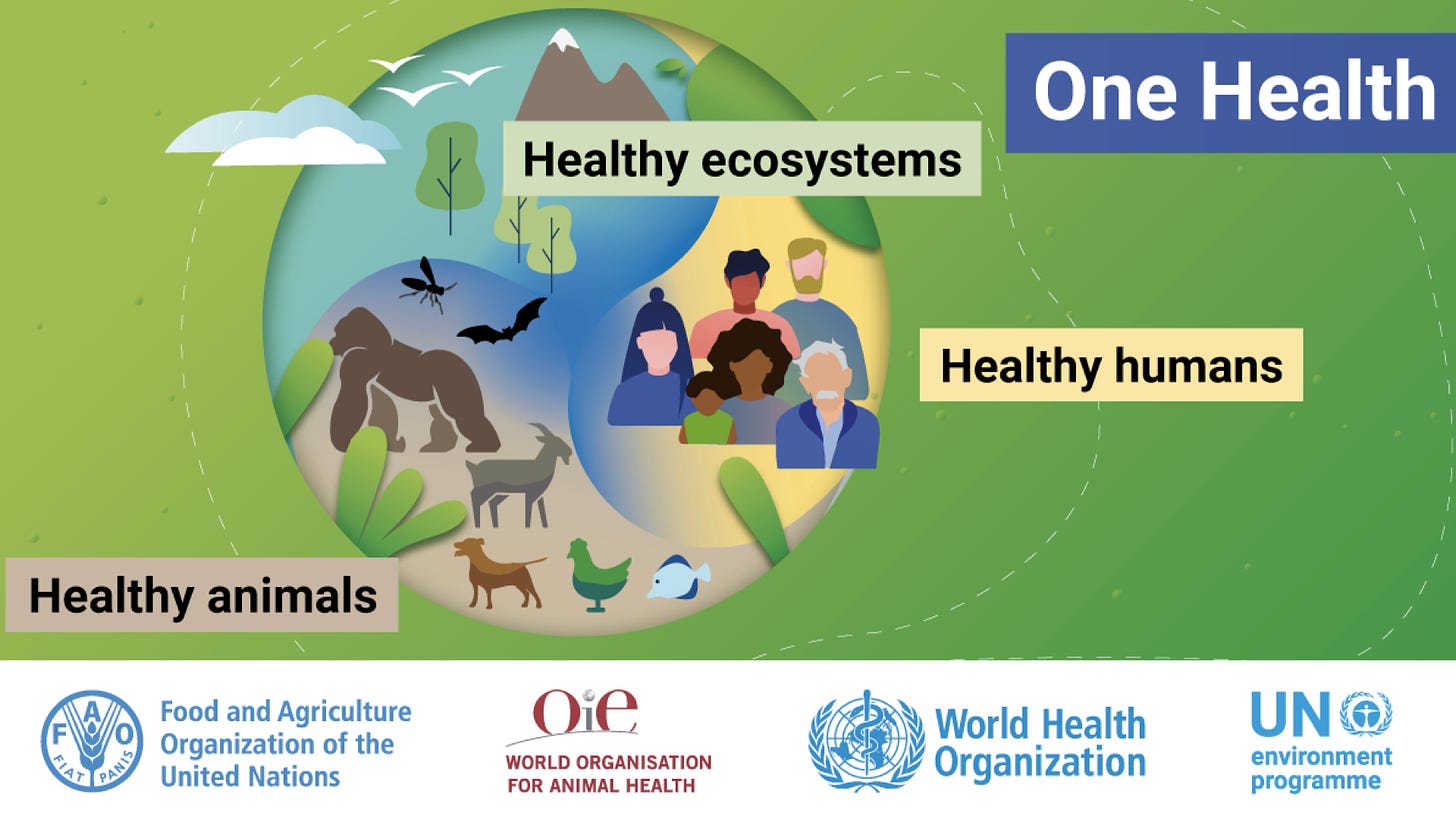
All for One World, One Health
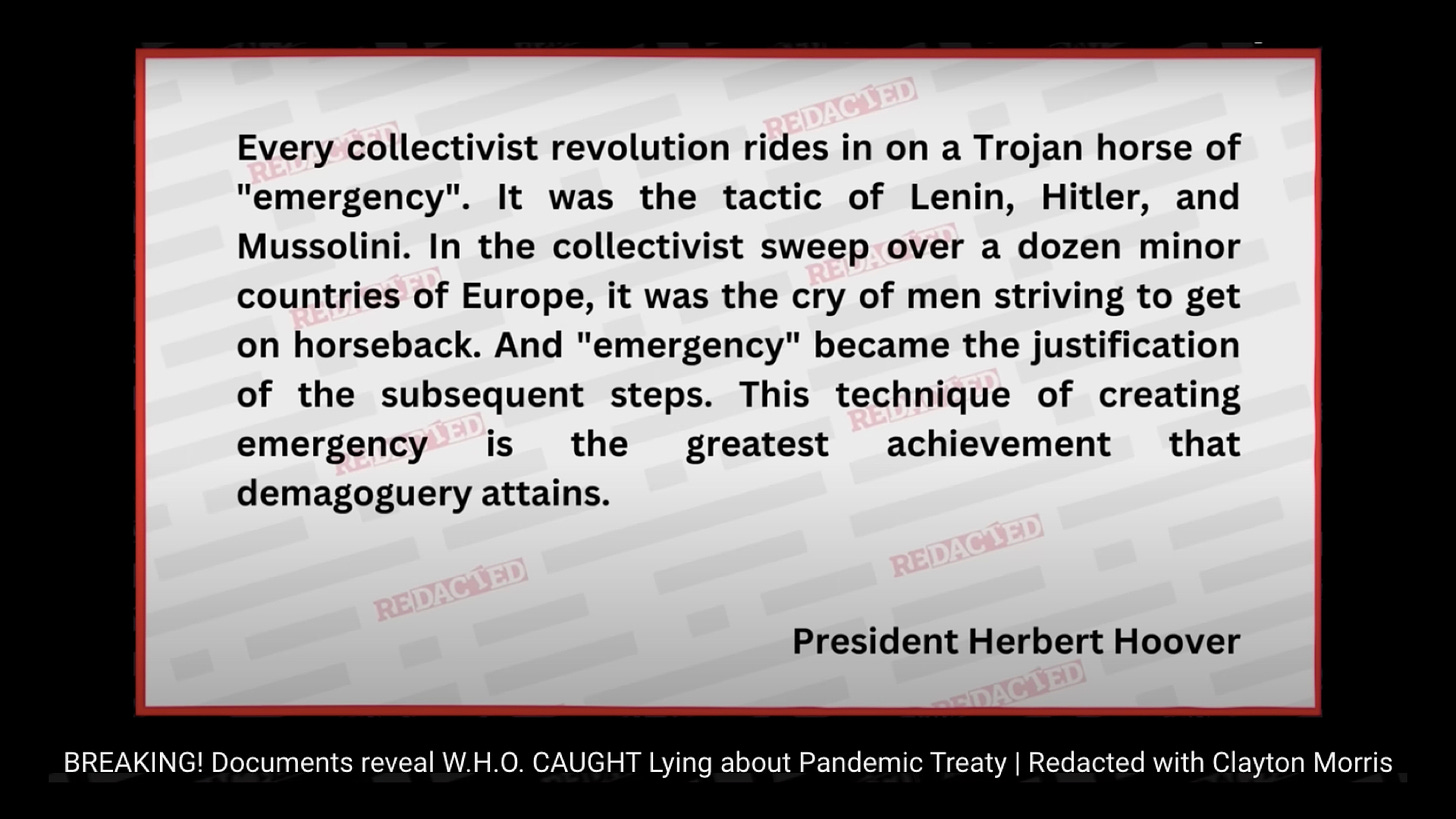
This is a quote that Redacted News mentioned in their 17 November episode ”Documents reveal W.H.O. CAUGHT Lying about Pandemic Treaty”: “Every collectivist revolution rides in on a Trojan horse of ’emergency’. It was the tactic of Lenin, Hitler, and Mussolini. In the collectivist sweep over a dozen minor countries of Europe, it was the cry of men striving to get on horseback. And ’emergency’ became the justification of the subsequent steps. This technique of creating emergency is the greatest achievement that demagoguery attains.”

The Planetary Guardians are coming to our rescue… Or is it the angel of death? We better beware! Thank you!

Read the fascinating background in Rockefeller – Controlling the game. Released in English, French, Polish and Swedish. The new international edition will be available early 2024. Preorder from Skyhorse Publishing.
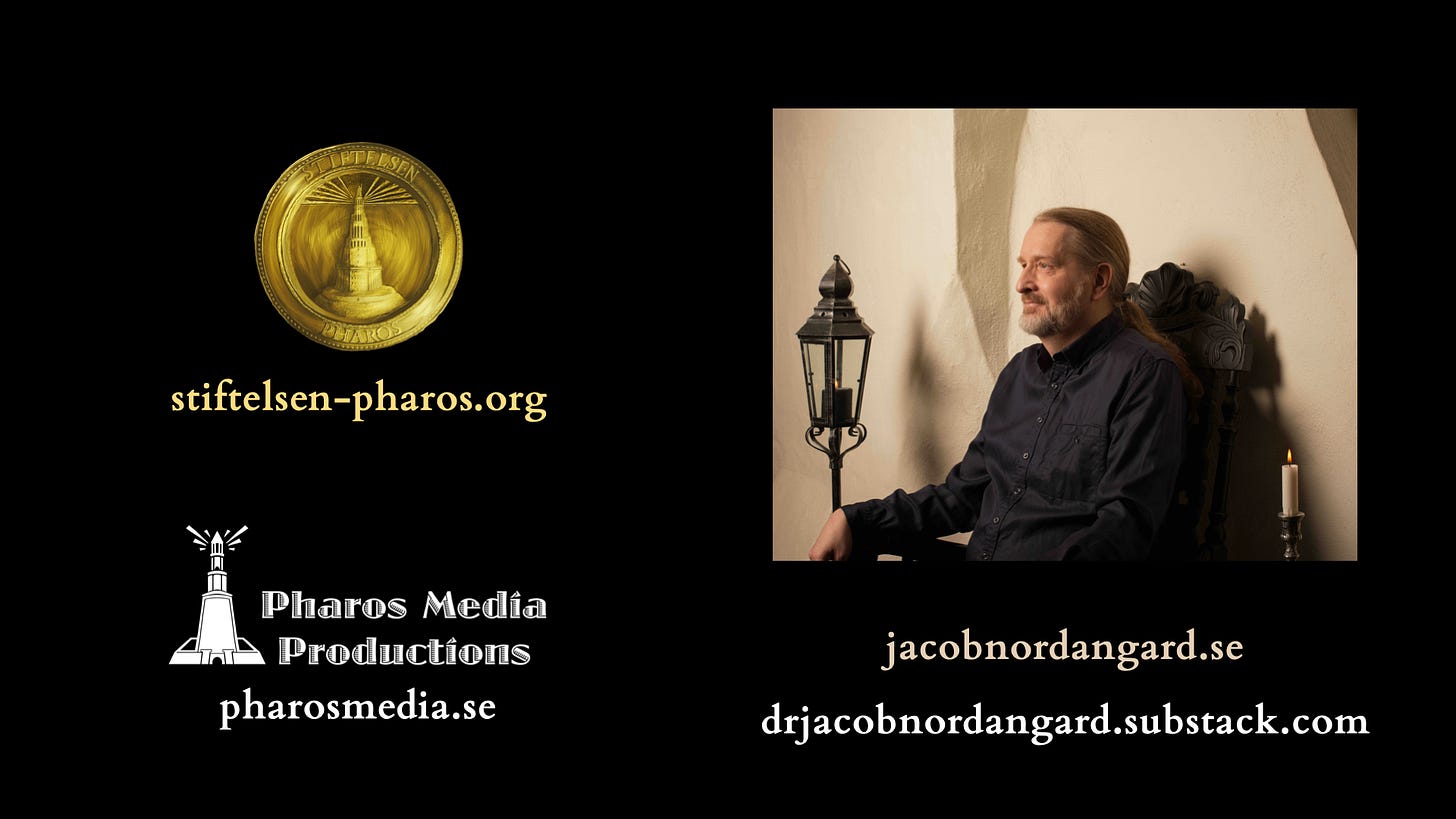
My latest articles can be found on my Substack. Support my work by becoming a paid subscriber.
The Pharos Chronicles – Jacob Nordangård, PhD is a reader-supported publication. To receive new posts and support my work, consider becoming a free or paid subscriber.





·
5 Comments

| alwayscurious19 hrs agoOutstanding timeline and presentation. Amazing how involved Sweden is and how far back it all goes. |
| Reuben J RoseWrites Sons of Issachar Newsletter 10 hrs agoJacob – what a remarkable story you have put together with more strands than most of us had ever realized. This has a sense of careful strategy and organization at the highest levels. It looks like we are due for another global emergency. Now the medical journals have been roped in and the medical profession. Friends of humanity will be hard to find. Thanks for your careful research. |
Top
New
Community
Why the President of the Club of Rome tried to stop the approval of my dissertation
Oct 7 •

Nov 7 •

Declaration of a Planetary Emergency to begin “the long term reduction of global population”
Oct 10 •

Ready for more?
© 2023 Jacob Nordangård
Privacy ∙ Terms ∙ Collection notice
Substack is the home for great writing”